

Ultimate Seville travel guide
- April 8, 2024
- curious goose
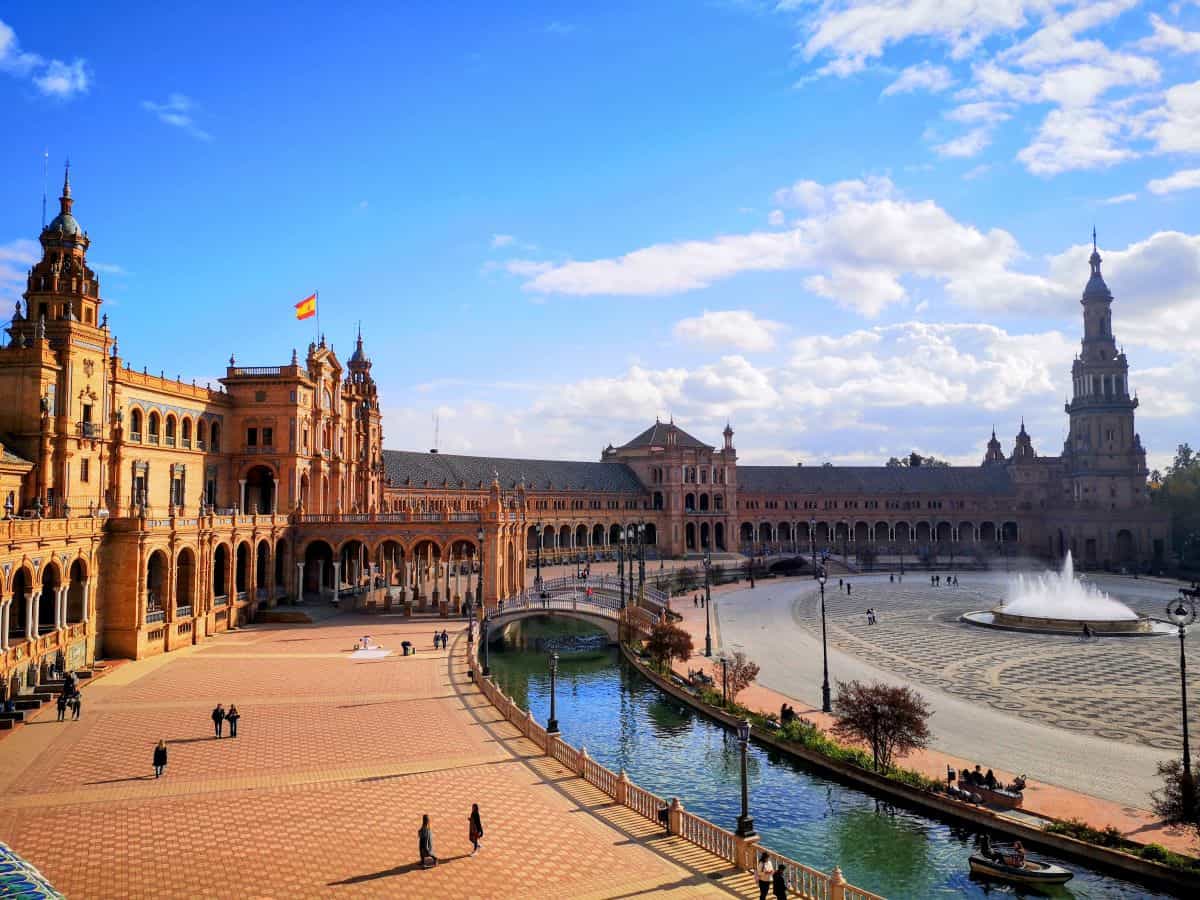
This post may contain affiliate links. I will receive a small commission if you use these links.
Table of Contents
Plan your perfect trip to seville with this handy guide.
Seville is one of the most popular city break destinations in Southern Spain. It is a great place to visit for a long weekend, or as part of a Spanish road trip. In this guide, I’ll cover all the key things you need to know about planning your perfect trip to Seville, including when is the best time to visit Seville, how to get there and some of the best things to see and do in Seville.
How many days do you need in Seville?
Many people choose to visit Seville on a long weekend, or a city break. However, Seville is also a great destination to include in your itinerary for a longer trip touring around the beautiful region of Andalusia, in Southern Spain.
I would recommend spending 3-4 days in Seville. This will give you a good amount of time to visit all the main sights and attractions of Seville without having to rush around to fit it all in. If you want to extend your stay, there’s also some great day trips from Seville .
How to get to Seville
By Plane: Seville airport is very small, and although it does have a handful of flights everyday, it is most likely that you will fly into either Madrid or Malaga.
By Train: The most convenient way to travel to Seville is by train . Seville’s Santa Justa Train Station is located on the edge of the Centro neighbourhood and main tourist area of the city. From Malaga, you can take a 2 hour train direct to Seville. A one way journey will cost approximately €46. From Madrid, the train to Seville takes 2 hours 45 minutes and will cost approx. €26.
From Seville train station, it is a 30 minute walk (approximately 2km) into the centre of Seville. Alternatively, you can catch a taxi which will take 20 minutes.
Getting around Seville
Seville is a very walkable city. In fact, much of the El Centro area is pedestrianised, or has one way roads. So the best way to get around Seville is on foot.
If you are staying in the El Centro area, in the heart of the tourist neighbourhood, then you can walk to most of the sights and attractions in around 20 minutes. If you are not able to walk far, then another great option is the Hop on, Hop off sightseeing bus.
If you are staying further away from the attractions, in the outskirts of Seville, there is a public tram and bus network which you can use to travel to the centre.
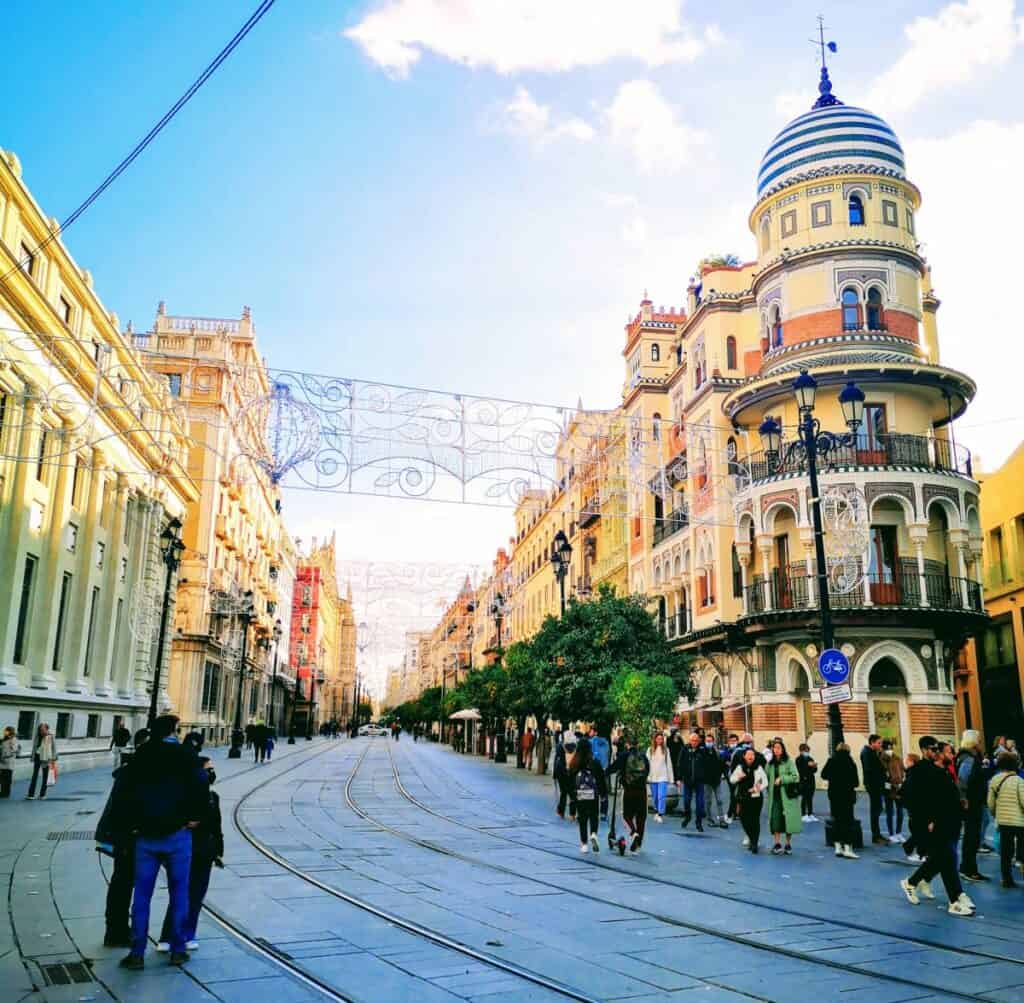
Where is the best place to stay in Seville?
As I mentioned above, most of Seville’s main sights and attractions are located in the El Centro neighbourhood, in the centre of the city. El Centro is definitely the best place to stay in Seville if you want to be in the middle of everything. Although, as you would expect, accommodation in El Centro is more expensive than on the outskirts of the city.
Surrounding El Centro is the Santa Cruz (Jewish) neighbourhood and the La Macarena neighbourhood.
Santa Cruz is known as Seville’s Jewish quarter. This pretty neighbourhood is a maze of narrow, cobbled streets and pretty buildings. It’s great to spend an hour or so exploring this area. There’s also lots of small cafes and tapas bars to be found here.
The area of La Macarena is becoming quite a trendy part of Seville. It is popular with a younger crowd and you’ll find a good mix of bars, clubs and restaurants. Staying in La Macarena is a great choice for finding more budget-friendly accommodation in Seville.
Across the river from El Centro is the neighbourhood of Tirana . In this area, you’ll find more family friendly tavernas and restaurants. You’ll also find cheaper accommodation on this side of the river. Tirana has less of a buzz, so if you are looking for somewhere quieter, this could be a good option for you.
When is the best time of year to visit Seville?
Seville is a large, bustling city. And as you would expect from any big, modern city, the attractions, bars and restaurants stay open all year round. This makes Seville a great city break destination to visit at any time of the year.
Seville in Summer
The average daily high in Seville throughout the peak summer months of July and August is 36 degrees Celsius. However, Summer in Seville can see temperatures reach up to a sweltering 40 degrees Celsius! This has caused Seville to be named as the hottest city in Europe during the summer.
Even if you are someone who enjoys the sun, Seville can be quite unbearable in the summer heat. Not all accommodation has air conditioning, especially in the more budget friendly hostels and guesthouses, and there are not lots of accommodation options with a pool.
Personally, I would avoid visiting Seville in the heat of the summer, and instead, choose to visit in the Spring or Autumn months.
Seville in the Spring and Autumn
The Spring months of March – May or the Autumn months of September – November are both great times to visit Seville. During the Spring and Autumn seasons, the temperature is mild and the days are lovely and sunny.
During September, average temperatures are still quite high at 32°C, so this is a great time to visit if you like it quite hot. Even in May and October, average temperatures are around 26°C.
I visited Seville towards the end of November, which I would really recommend. The weather was still warm and mild during the day. Accommodation prices were lower as it was officially the ‘off-season’. However, there were still lots of tourists around, creating a good atmosphere, without it feeling too busy.
Seville in the Winter
Spain is a great destination to visit in the winter months and I’ve spent time in Malaga and the Costa del Sol during the winter and loved it. Visiting Seville in December, you will be able to experience the Christmas market and enjoy the Christmas decorations which are all around the main El Centro neighbourhood.
January and February are the cheapest months to visit Seville. This is also the least crowded time of year to visit. Even in January and February, you will still get average temperatures of 16°C during the day.
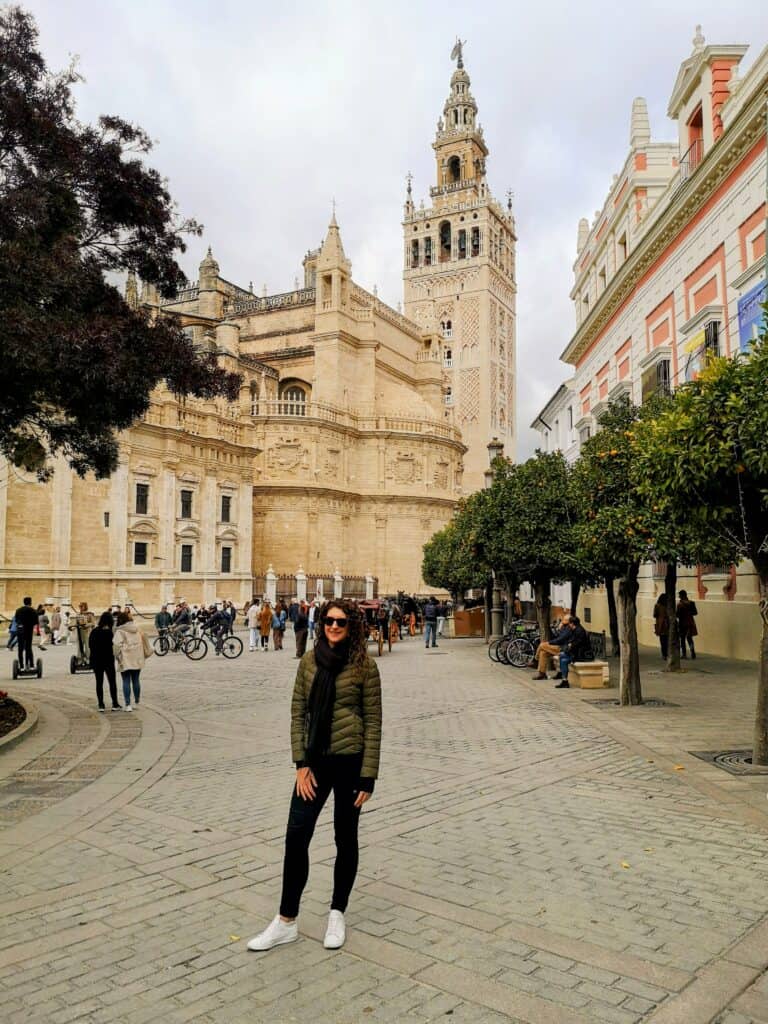
Best things to do in Seville
Here’s some of the best sights and attractions to see whilst you are in Seville:
Cathedral de Sevilla
Opposite the Royal Alcazar is the city’s other most visited attraction – the Cathedral of Seville. This impressive gothic cathedral is an absolute must-visit when in Seville. The intricate detail of the decor and carvings on the inside is incredible. You can also visit the Giralda (bell tower) – which I would highly recommend. The steps up to the top will be worth it as you’ll be rewarded with fantastic skyline views over the city. In fact, this is the best city view in Seville!
As with the Alcazar, I would highly recommend purchasing your ticket in advance to avoid long queues. It is also slightly cheaper to purchase online, at €12 per adult (instead of €13 at the ticket office)
Plaza del Triunfo
This small Plaza sits in between the Royal Alcazar and the Cathedral. It can get quite busy here during the day, but in the morning you can enjoy it whilst it is a bit quieter. This is also a great meeting spot if you are travelling with others and need to arrange a rendezvous point!
Royal Alcázar of Seville
The Royal Alcazar is one of the most visited attractions in the centre of Seville. A wander around the 16th century palace and its landscaped gardens is a lovely way to spend a couple of hours. The gardens are particularly beautiful, especially between the Spring and early Autumn months.
There can be a very long queue to enter the Alcazar, especially during peak season and in the middle of the day. Even in November, I experienced long queues! I would definitely recommend booking in advance if you can. Otherwise, you can purchase tickets at the official ticket office in the Patio de Banderas, which is a small square around the corner from the main entrance to the Alcazar. Once you have purchased your tickets, head back to the main entrance (identified by the red Puerta del León gates) and join the queue to enter. Tickets are €13.50 for general admission.
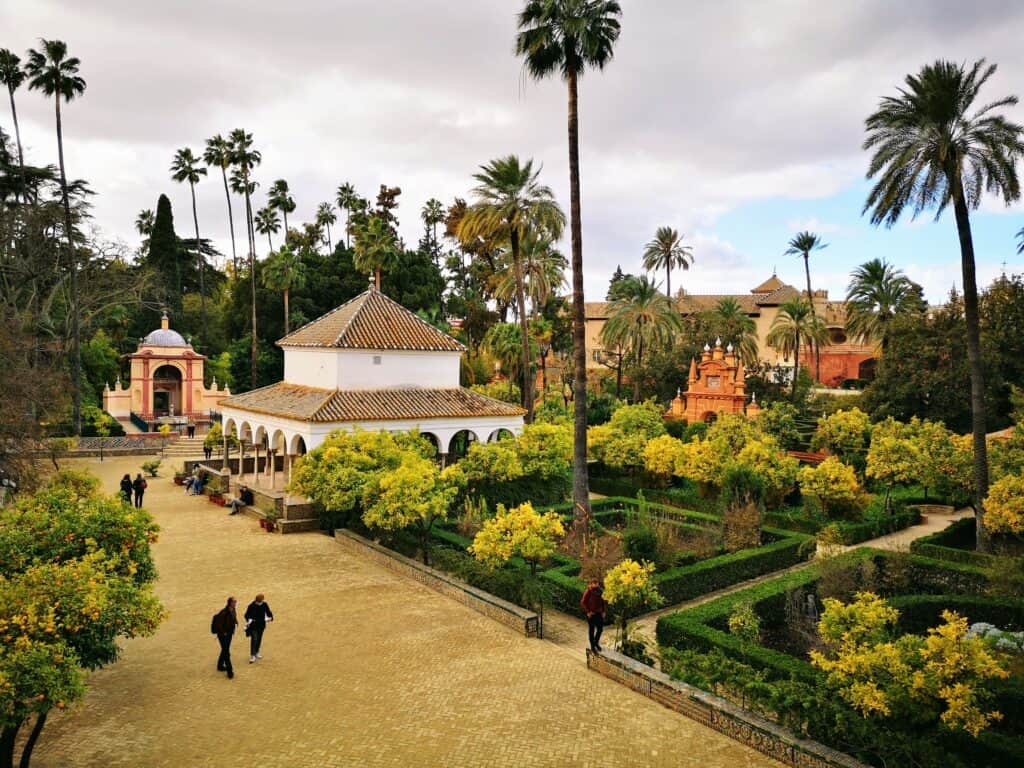
Avenue de la Constitución
This is one of the main streets, running right through the centre of the city, past the Alcazar and Cathedral. The tree-lined street is lined with shops and cafes, with tram stops along the way.
Plaza de España
You can’t go to Seville and not visit the Plaza de Espana! It has become one of the most photographed and recognisable sights in Seville. This famous plaza has an impressive curved building, holding various government offices. Several bridges curve over a shallow water feature and small rowing boats can be hired out to take out onto the water for a photo opportunity. You can wander around the Plaza for free, however there is a small charge to hire the rowing boats.
This is a great place to sit and enjoy watching the world go by. You can also see the various colourful tiled benches which have been created as part of the main building.
Parque de María Luisa
In front of the Plaza España is the sprawling Maria Luisa park. In the hot summer months, this is a great place to cool off under the shade of the trees. There is an abundance of paved walking trails all over the park, as well as benches, and small squares with water fountains. At the far end of the park, you will also find several historic landmarks and the Museum of Popular Arts and Traditions, which houses various exhibitions on arts, local traditions and costumes.
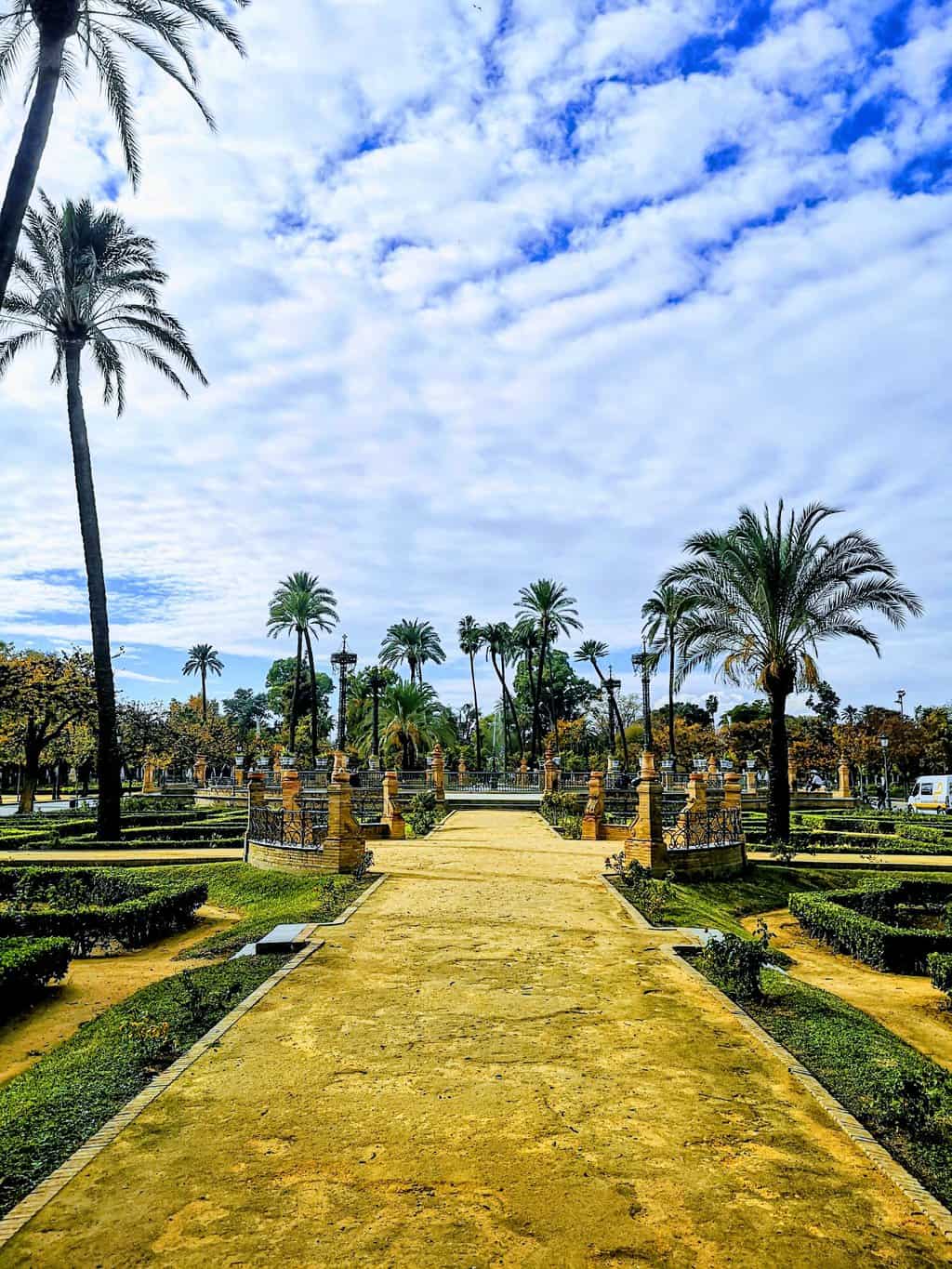
Jardines del Prado de San Sebastián
Tucked behind the Plaza Espana, and often overshadowed by the Parque de Maria Luisa, are the San Sebastian gardens. This is another great place to find some peace and quiet in the city. There are a couple of cafes with outside seating here, and in the winter months, you can often find a pop up ice skating rink.
Paseo del Rio Guadalquivir
The Rio Guadalquivir is a pedestrian walking path that runs alongside the canal skirting the edge of the El Centro neighbourhood. You can follow it from the Parque de María Luisa all the way to the Del Cachorro bridge. Along the way, you’ll pass various cafes, kiosks and landmarks, including the Torre del Oro – a defensive watchtower, dating back to 1220.
Centro Comercial Torre Sevilla
If you want to do some shopping, then you can head to the Centro Commercial. Located on the opposite side of the canal, you can cross the Del Cachorro bridge. There are also various well known fast food outlets here
Go shopping on Calle Sierpes
This is a busy shopping street which runs right through the centre of the El Centro neighbourhood, eventually joining up with Avenue de la Constitución. You will find mainstream brands alongside local, independent shops. With lots of cafes, restaurants and food outlets.
Wander the Jewish Quarter
The Jewish Quarter is actually a neighbourhood rather than a single sight or attraction, but it is worth mentioning as it is a really charming area to wander around. The Jewish Quarter is a pretty area of the city, with a maze of narrow streets and historic and interesting churches, landmarks and buildings with little cafes tucked away inside.
Setas de Sevilla
This giant wooden sculpture is hard to miss! Hang out underneath the structure or purchase a ticket to access the raised walkway and viewing platform . Tickets are also available to visit at night, when the sculpture is illuminated with bright colours.
During the day, you can also visit the Encarnación food market , which sits underneath the sculpture to pick up some tasty local produce.
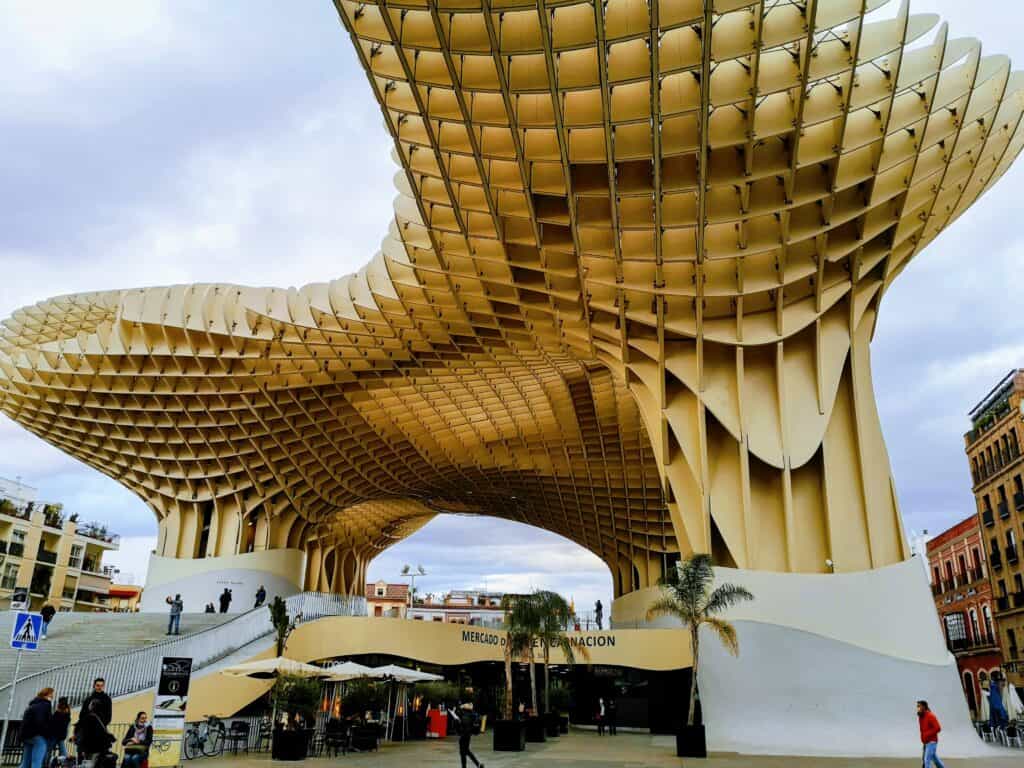
Day trips from Seville
I’ve visited Andalusia several times in the last few years and I absolutely love it. It is such a beautiful region of Spain. If you have longer than 3 days to spend in Seville, I would highly recommend taking a day trip to explore the wider area of Andalusia.
There are many organised tours you can take from Seville. Or, if you prefer to have more flexibility, then another great option is to rent a car for the day.
Cordoba is one of the most popular day trips from Seville, due to its proximity and ease of travel.
What is there to do in Cordoba?
The main attraction in Cordoba is the La Mezquita mosque-cathedral . The impressive building and complex is a must-see when in Cordoba and tickets should be booked in advance to avoid disappointment.
Other sights in Cordoba include the Alcazar of Cordoba, Roman Bridge, Plaza des Tendillas and the Jewish quarter.
Travel from Seville to Cordoba
The quickest and best way to get to Cordoba from Seville is by train. The direct train takes just 45 minutes and costs approximately €20 each way. There are also many organised tours that will leave to Cordoba from Seville if you prefer.
Cadiz is known for being the oldest city in western Europe. Situated on the Andalusian-Atlantic coast, it is home to the Spanish Navy and was an important Port city, with over 100 watchtowers.
What is there to do in Cadiz?
The historic city of Cadiz is a perfect day trip destination from Seville. The largely pedestrianised Old Town of Cadiz is great for exploring on foot, with plenty of cafes and tapas bars to rest and enjoy some local cuisine. Visit the Cathedral , and the castle of Santa Catalina and San Sebastian . Stroll along La Caleta beach and through the Genoves park.
Cadiz is only 80 minutes by car from Seville, so renting a car for the day is the most convenient option. However, if you prefer, you can also take a bus from Seville to Cadiz . The journey will take you around 1 hour 45 minutes.
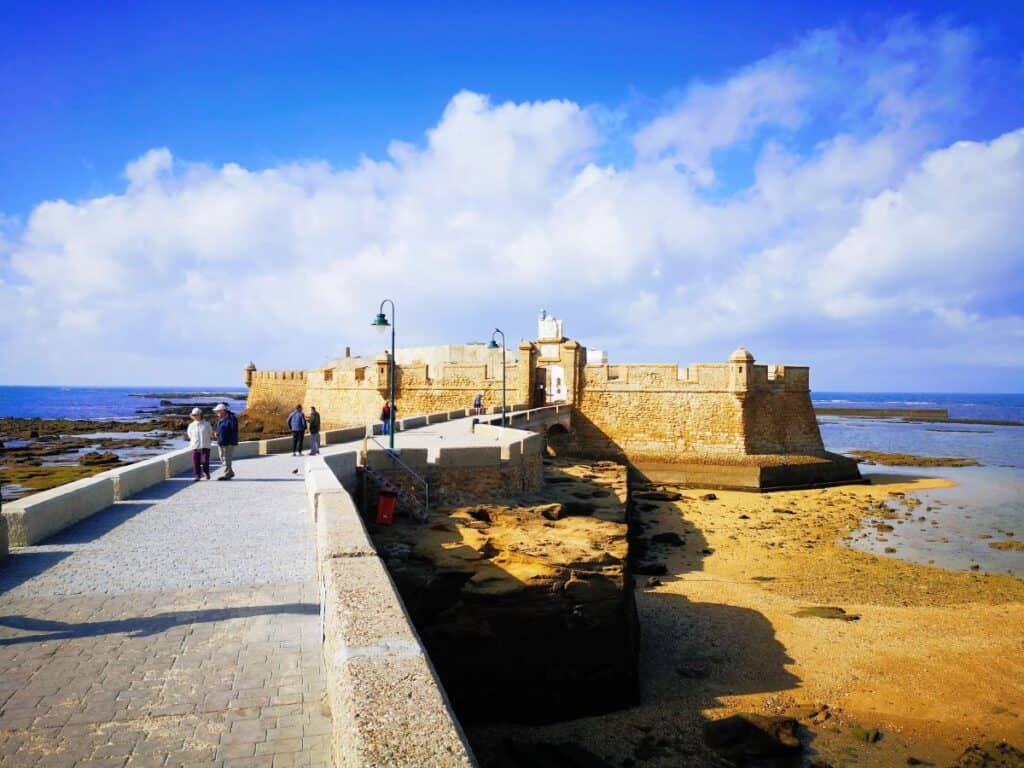
Malaga is a fantastic city to visit and is one of the most popular city break destinations in Southern Spain, alongside Seville. If you have more time, I would recommend spending 3 days in Malaga . If you arrived in Seville via Malaga airport, make sure you have at least one night in Malaga either before or after your trip to Seville.
What is there to do in Malaga?
Malaga is a vibrant city with beautiful historic buildings and a charming old town. Visit the Alcazaba of Malaga , and see the Roman Amphitheatre . Stroll around the ruins of Gibralfaro castle with sweeping 360 views over Malaga’s mountain range, city and sea.
Have a leisurely lunch in one of the many restaurants in Malaga’s Port , walk along the seafront promenade and relax on Malagueta beach . Go shopping in the old town, visit the impressive Malaga Cathedral and enjoy a drink in one of the many tapas bars.
Travel from Seville to Malaga
There are two main ways to travel to Malaga from Seville. Either by train or by car. The train takes approximately 2 hours and costs around €46 each way. Driving will take 2 hours 20 if you take the toll road, or 2 hours 45 mins if you choose not to take the route with tolls.
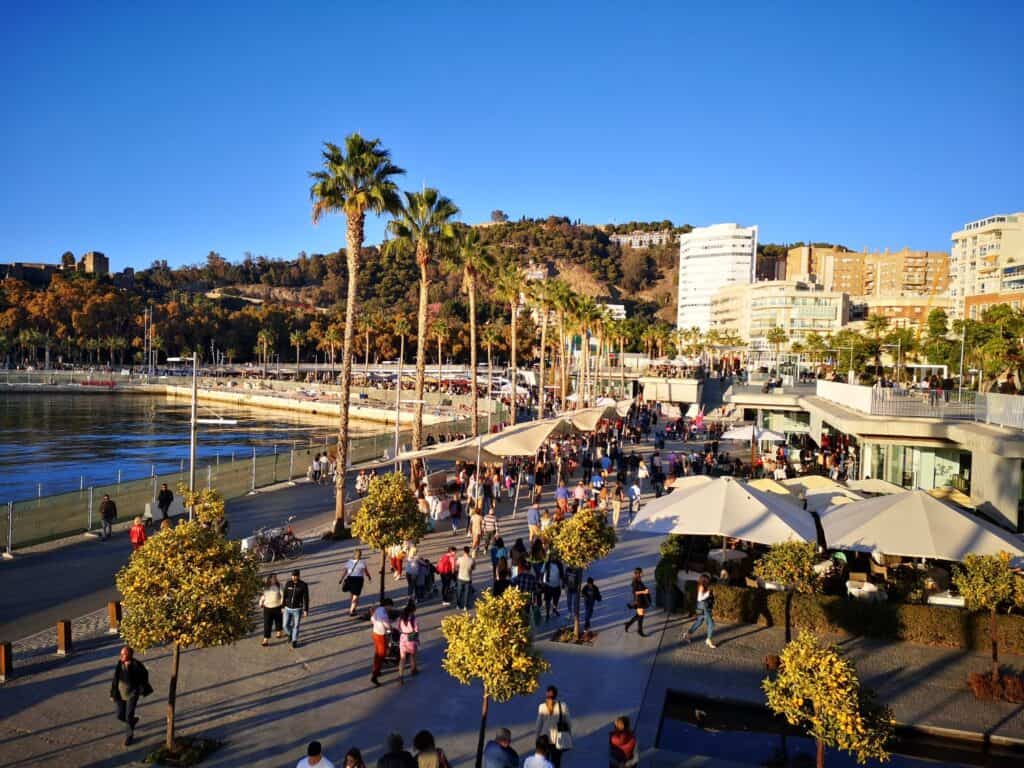
Other day trips from Seville
There are so many great places to visit in Andalucia , it is hard to include them all! Other worthy places to visit, which are a little bit further away from Seville include Granada, where you can wander around the famous Alhambra Palace .
Ronda is another great option, where the impressive Puente Nuevo bridge straddles a 120m deep gorge which has split the historic town in half.
Or, if you are looking for something a little more adventurous, join a trip to hike the famous Caminito del Rey – once known as Europe’s most dangerous hike!
Related Posts
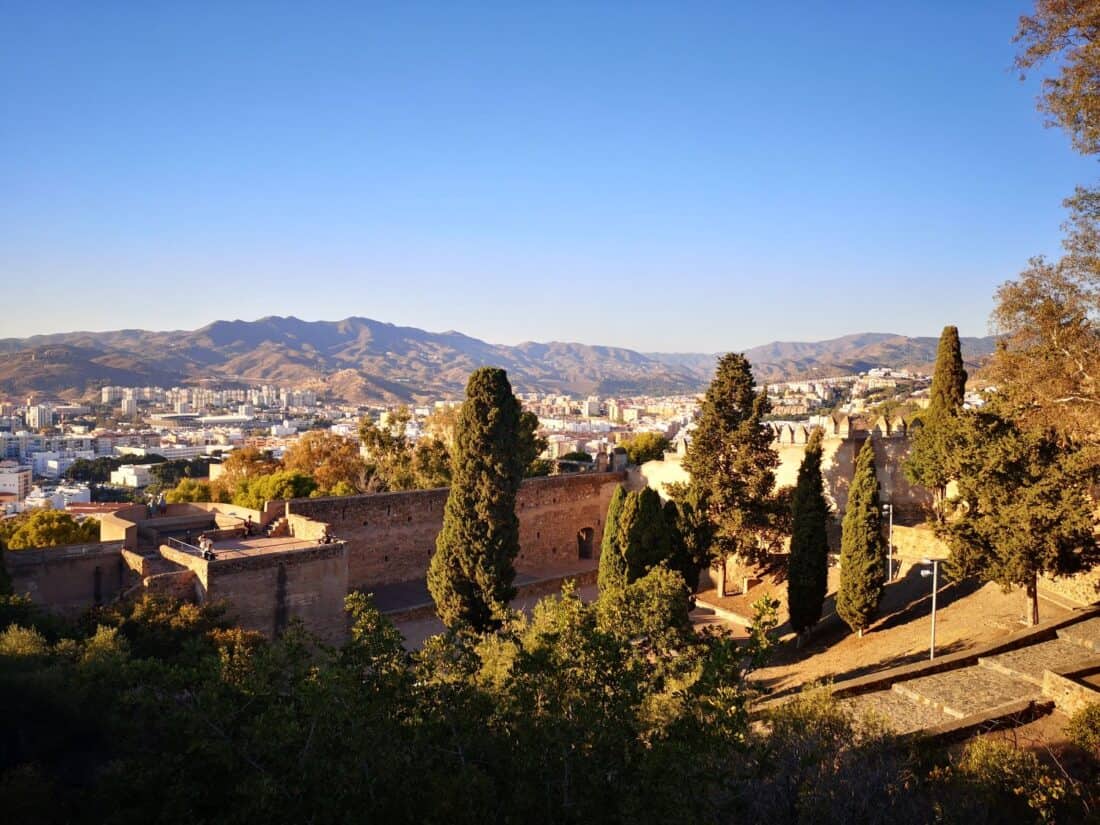
Amazing day trips from Malaga
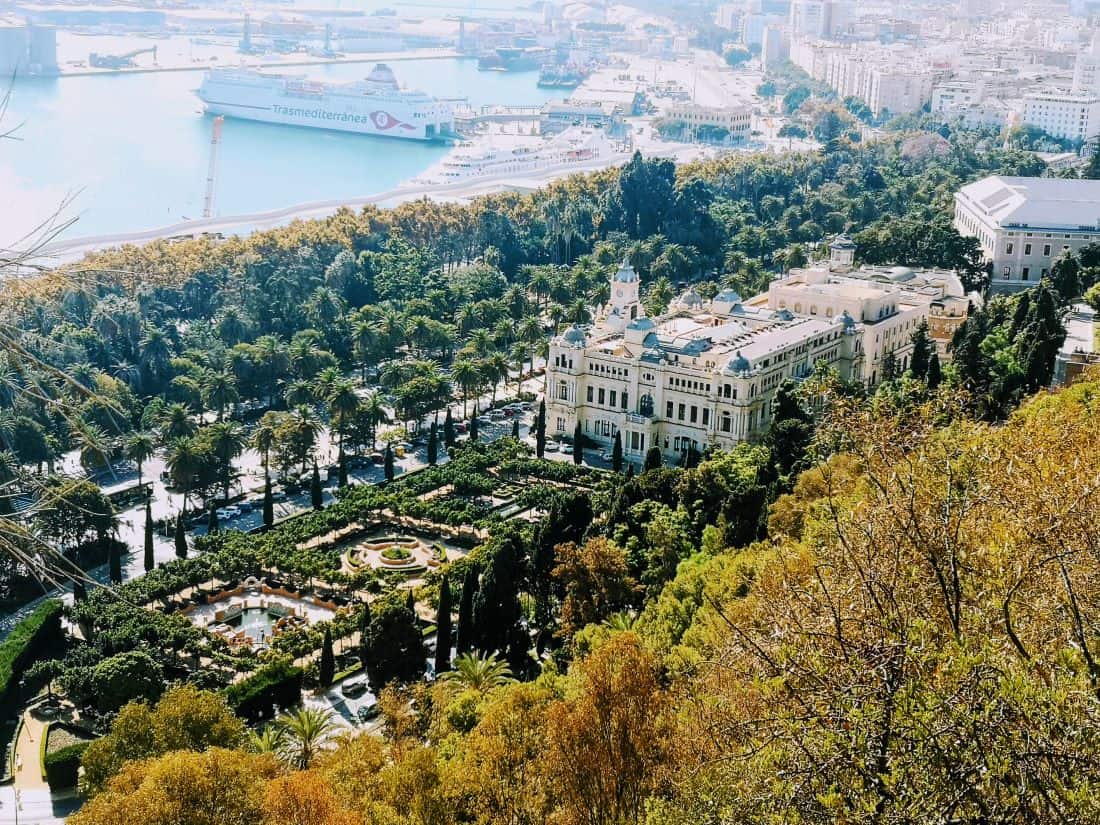
Best things to do in Malaga (2024) – A complete guide
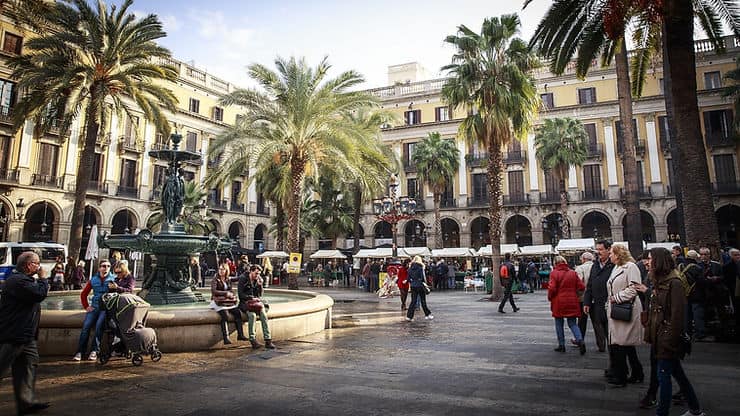
A long weekend in Barcelona
Nomadic Matt's Travel Site
Travel Better, Cheaper, Longer
Seville Travel Guide
Last Updated: January 5, 2024
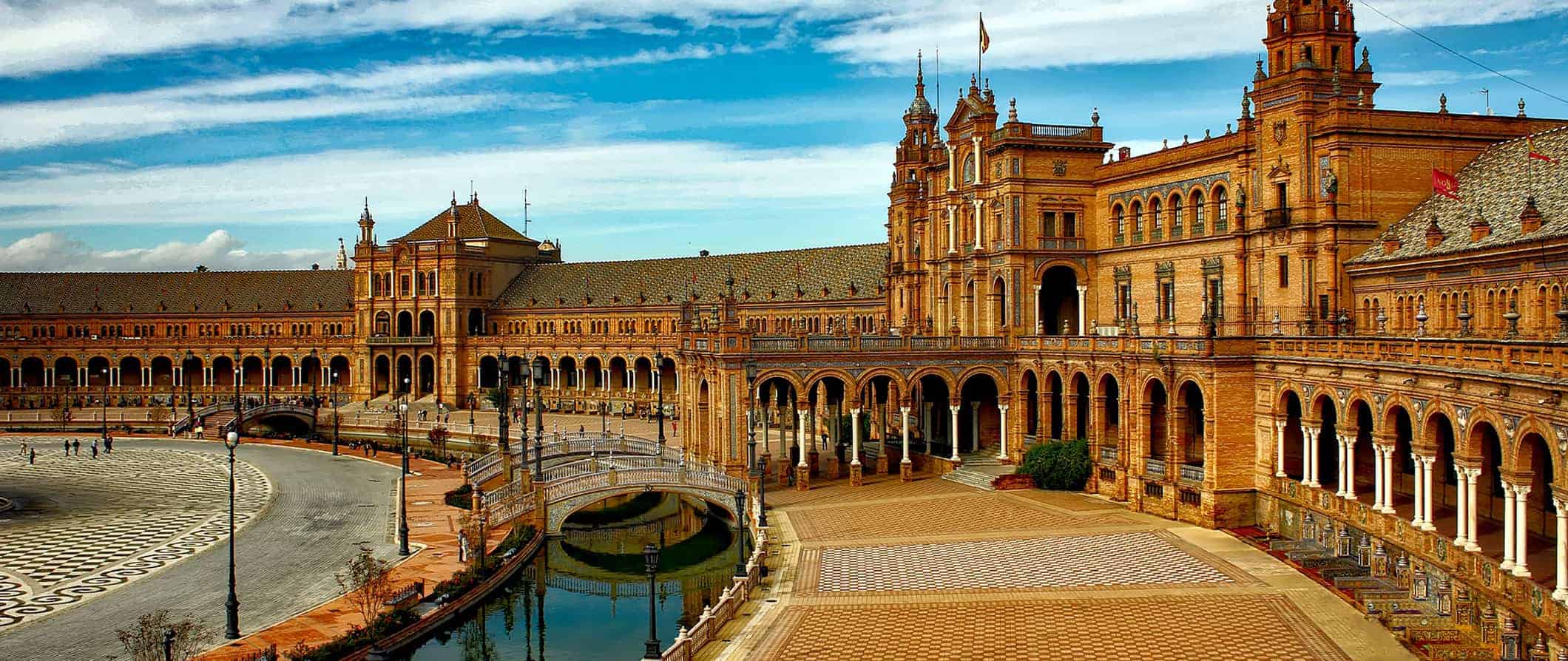
Originally founded as a Roman city, Seville came to prominence after the Islamic conquest in 711. Today, the city is known for its flamenco dancing (which originated in Andalucía), its beautiful architecture that blends Islamic and European styles, and its scorching summers.
Seville is a big university town and is extremely popular with people studying abroad, making it a more affordable destination than cities like Barcelona or Madrid (it’s not as crowded either).
This Seville travel guide will give you everything you need to know to eat well, save money, and see the best sights Seville has to offer!
Table of Contents
- Things to See and Do
- Typical Costs
- Suggested Budget
- Money-Saving Tips
- Where to Stay
- How to Get Around
- How to Stay Safe
- Best Places to Book Your Trip
- Related Blogs on Seville
Top 5 Things to See and Do in Seville

1. Tour Casa de Pilatos
Built in the 16th century, this beautiful Andalusian palace is a mix of Italian Renaissance and Spanish Mudejar styles. It houses a collection of 16th and 19th-century paintings, as well as a sculpture garden of Greek mythological figures. It’s also the permanent residence of the Dukes of Medinaceli (a hereditary title in Spain) and boasts the world’s largest collection of azulejo (a traditional glazed tile artwork). Numerous films have also been shot here, including Lawrence of Arabia, Kingdom of Heaven , and Knight and Day to name a few. Admission is 12 EUR.
2. Explore Parque de Maria Luisa
Located just in front of the iconic Plaza de España, this 100-acre public park offers the opportunity to browse gardens, patios, and sculptures. The park is Seville’s main greenspace and is situated near the Guadalquivir River. Created in 1911, it’s a relaxing place to lounge, picnic, and people watch. Don’t miss the monument to Miguel de Cervantes, who wrote Don Quixote (the monument used to include statues of Don Quixote on his horse and Sancho Panza on his donkey but they have since disappeared).
3. Visit the Royal Alcázar
The Royal Alcázar of Seville (also known as al-Qasr al-Muriq) is the oldest residential palace in Europe still in use today. Dating to the 14th century, it’s an important example of Moorish architecture. There are giant galleries, ornate rooms, and beautiful gardens. The palace was built for the Christian king Peter of Castile atop a Muslim fort after Christian armies reconquered the city in 1248. It’s also a UNESCO World Heritage Site. General admission is 14.50 EUR. Free admission is available on Monday afternoons/evenings. Check the website for specific times.
4. Walk through the historic Jewish Quarter
Seville’s Jewish Quarter is filled with small winding streets and is generally regarded as the most charming part of the city. The area gets pretty crowded but there are numerous small alleys and streets to explore where you can escape the crowds. Don’t miss this part of town.
5. Take a food tour
To learn more about the history and culture behind Seville’s cuisine, take a food tour. It’s the best way to eat your way around the city sampling the best eats Seville has to offer while learning what makes the cuisine unique. Devour Tours runs in-depth food tours led by expert local guides that will introduce you to the food culture and its history. If you’re a foodie like me who wants to learn more about the history and culture behind each dish, this tour is for you! Tours start at 89 EUR.
Other Things to See and Do in Seville
1. visit the catedral of sevilla.
This Roman Catholic cathedral dominates much of Seville’s skyline. Surrounded by Andalusian orange trees, the Cathedral (also known as the Cathedral of Saint Mary of the Sea) is one of Seville’s top tourist attractions. Lines can get long, partially because hours are limited around church services, so get there early. While you can just admire the stunning design and stained glass from outside, the Cathedral is where Christopher Columbus is buried, so it’s worth going inside. The bell tower also offers a panoramic view of the city. Admission is 11 EUR if you purchase online and 12 EUR in person. The audio guide costs 5 EUR (4 EUR if you use the app).
2. Check out Plaza de España
One of Seville’s most picturesque spots, Plaza de España was built at the northern edge of the Parque de María Luísa in the 1920s for the Ibero-American Exposition. The unique building mixes Baroque, Renaissance, and Moorish architectural styles, and there’s a small canal with Venetian-like bridges and gondolas. The Plaza has gotten a lot of attention in the past few years because it has served as a backdrop in film and TV, such as Star Wars and Game of Thrones . The murals along the sweeping arc of the building depict the various regions and municipalities of Spain. It also has benches that depict the 49 provinces of Spain in ceramic tiles. Admission is free.
3. Visit the Iglesia de San Isidoro
While this church is less popular than the Catedral de Sevilla, the Iglesia de San Isidoro is considered one of Seville’s most impressive churches. The 14th-century church was built on top of a former Arabic fortification and its fusion of Gothic and Mudejar styles is a common example of unique architecture in Andalucía. The intricate design makes this worth a visit. Admission is free but be sure to dress respectfully as it is a place of worship.
4. Enjoy some contemporary art
The Centro Andaluz de Arte Contemporáneo (CAAC) is a contemporary art museum located just across the river from the city center. Housed in a former Franciscan monastery that dates to the 15th century (and was later a ceramic tile factory), today the museum hosts a collection of Andalusian artists. There are rotating exhibitions so check the website to see what’s on during your visit. Admission is 3.01 EUR, though there is free entry Tuesday-Friday from 7pm-9pm and on Saturdays from 11am-9pm
5. Learn about Spain’s colonial history
The General Archives of the Indies is a 16th-century building and UNESCO World Heritage Site. Built in the Spanish Renaissance style, it contains a large collection of documents and artifacts related to Spain’s colonization of the New World. Highlights include the personal diary of Columbus and the Treaty of Tordesillas, which divided the New World between Spain and Portugal. Admission is free.
6. Visit the Flamenco Museum
Flamenco music and dance is an important cultural element of southern Spanish culture, and the Flamenco Museum in Seville is a great way to learn more about this unique style of performance. The museum features many intricately designed flamenco dresses and illuminates the history behind the dance’s origins. Admission to the museum is 10 EUR while live flamenco shows in the museum’s theater are 25 EUR.
7. Admire fine art
The Museo de Bellas Artes is a fine arts museum with works from the Middle Ages through to the 20th century. The museum lies in the Macarena neighborhood in a building that dates to 1594. Two floors in the building are full of paintings, sculptures, furniture, and crafts — many by artists from Seville or Andalucía. Admission is 1.50 EUR and free if you’re an EU citizen.
8. Take a Spanish class
Seville is a popular study abroad location for international students and there are a number of language schools catering to students from around the world. You can take Spanish courses for just a single week or longer. Many students choose Seville to study because of the big student population of the city, the affordability of the city, and the unique Andalusian culture. The CLIC language school offers a variety of courses for any number of weeks or months, plus affordable housing for those that want to stay with other students or in a homestay. A one-week intensive Spanish language course at CLIC costs as little as 205 EUR, though discounts are available depending upon a package or multi-week course.
9. Take in the view from the top of a mushroom
This large sculptural platform in the Plaza de la Encarnación used to be a car park but, in 2011, it was transformed into a massive public art project called Las Setas De Sevilla, or the Metropol Parasol. Resembling mushrooms (or more like a beehive in my opinion), the structure provides shade to the plaza below and there are two 85-foot panoramic platforms where you can take in the view. Admission to the platform is 10 EUR.
10. Hang out in Alameda
The best nightlife spot in Seville is in and around the Alameda de Hercules. The large, open-air plaza attracts many students and creative artist types who relax here drinking, playing music, and enjoying any of the tapas bars and outdoor seating that line the mall. Many of the restaurants and bars in the area offer live music and great deals on food & drinks too.
11. Relax on the Guadalquivir River
The first trip around the world originated in Seville when Portuguese explorer Ferdinand Magellan sailed out along the Guadalquivir River in 1519. The river was the main maritime route for Atlantic traffic for over 200 years, making Seville the mercantile center of the western world in the 16th century. These days you can enjoy rowing and canoeing on the river or just simply relax by the shore and take in the scene.
12. Take a bike tour
For more information on other cities in Spain, check out these guides:
- Barcelona Travel Guide
- Granada Travel Guide
- Madrid Travel Guide
- Valencia Travel Guide
Seville Travel Costs
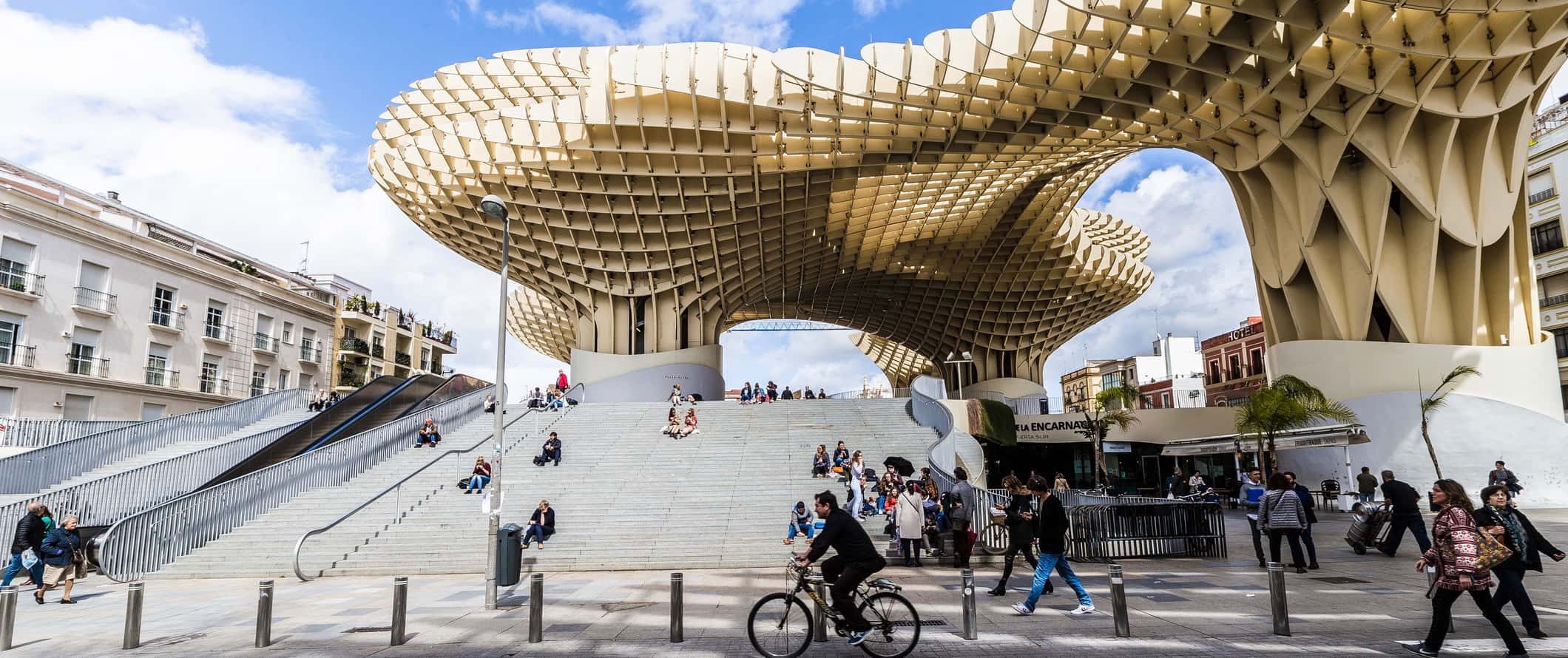
There are a few campgrounds outside the city, some offering private cabins with swimming pools for 40 EUR. For those with a tent, a basic plot for one person costs 5 EUR.
Budget hotel prices – Budget hotels cost 40-60 EUR per night, though prices are slightly higher (around 50-100 EUR per night) in peak tourist season and around Easter. Continental breakfast is usually included, as are basic amenities like TV and Wi-Fi.
Airbnb is available here as well, with private rooms starting at 30 EUR per night (but averaging double that). An entire apartment goes for at least 70 EUR per night though prices double if you don’t book early. Many include air-conditioning — useful to have for the hot summer season.
Food – Spain has a strong food culture, where meals can last hours and dinner often isn’t served until after 8pm. Each region in the country has its own local dishes and food culture, and Andalucía is no exception. Owing to its location on the coast, seafood is huge in this region, including shellfish and pescaito frito (fried fish). Gazpacho is also super common here, as is Iberian ham. Don’t miss trying some of the local sherry too (William Shakespeare apparently loved it).
You can eat very cheap in Seville. Tapas bars offer great deals and a number of takeaway stands with falafel, shawarma, or other late-night snacks can be found for under 10 EUR. Most tapas bars offer small plates for anywhere from 5-10 EUR depending upon the type of dish.
If you want to splurge, there are many nicer tapas restaurants with more elaborate meals and innovative takes on typical Andalusian-style foods. Mid-range tapas restaurants serve small plates between 7-15 EUR and, again, two or three plates is usually enough food for one person.
For a mid-range meal including an appetizer and drink, expect to pay at least 20 EUR. For cheap fast food (think McDonald’s), a combo meal costs around 8 EUR.
Beer costs as little as 2-3 EUR. A glass of sangria or wine costs 5 EUR. A latte/cappuccino is around 1.50 EUR while bottled water is under 1 EUR.
If you plan on cooking your own meals, expect to spend about 40-45 EUR for a week’s worth of groceries. This gets you basic staples like pasta, rice, seasonal produce, and some meat.
Backpacking Seville Suggested Budgets
If you’re backpacking Seville, expect to spend around 50 EUR per day. This budget covers a hostel dorm, cooking most of your meals, limiting your drinking, taking public transportation, and doing mostly free activities like relaxing in the park and seeing some of the churches. Add 10-15 EUR per day to your budget if you plan on drinking or partying a lot.
On a mid-range budget of about 135 EUR per day, you can stay in a private Airbnb or private hostel room, eat out at cheap restaurants for most meals, enjoy a few drinks, take the occasional taxi to get around, and do more paid activities like and museum visits or Spanish classes.
On a “luxury” budget of 250 EUR or more per day, you can stay in a hotel, eat out anywhere you want, drink as much as you’d like, take more taxis, and do as many guided tours as you want. This is just the ground floor for luxury though. The sky is the limit!
You can use the chart below to get an idea of how much you need to budget daily. Keep in mind these are daily averages – some days you spend more, some days you spend less (you might spend less every day). We just want to give you a general idea of how to make your budget. Prices are in EUR.
Seville Travel Guide: Money-Saving Tips
Food, drinks, and tours can add up in Seville if you aren’t watching your spending. This is one of the more expensive cities in Spain. Fortunately, there are plenty of ways to take advantage of free things to do here. Here’s how to save money in Seville:
- Get the Tarjeta TurÍstica pass – If you plan on using the bus or tram often, get this pass. A one-day pass costs 5 EUR and provides unlimited access to all public transport. A three-day pass costs 10 EUR.
- Visit the Royal Alcázar on Monday – The Royal Alcázar has free admission on Mondays, so plan accordingly to save money. Specific times vary by season so check the website for an up-to-date schedule.
- Buy your own alcohol – While drinks are hardly expensive at bars and restaurants in Seville (and in Spain as a whole), you can save yourself a lot of money if you buy your own beer and wine. Many locals buy their own bottles and drink in public at the Alameda de Hercules in the evenings, taking advantage of the street performers, buskers, and musicians that crowd the plaza on weekends.
- Stay with a local – Couchsurfing is a great way to save money on accommodation while also getting some insight from a local. While hostels aren’t too expensive in the city, this is still the best way to save money and deepen your travel experience.
- Go on a free walking tour – Like most of Spain, there are many opportunities to take advantage of free walking tours. Seville has a number and many depart from Plaza del Salvador. You just need to tip your guide. My favorite is New Europe. Just remember to tip your guide at the end!
- Visit the markets for groceries & cheap tapas – The Triana Market is one of the main food markets in Seville and has many fruit and vegetable vendors. There are food markets in each of the major Seville neighborhoods, and sometimes the smaller ones outside the main tourist trails even have small, local restaurants with great food deals. The Mercado de Feria is a favorite. Buying snacks, small meals, and groceries at the local neighborhood markets can cut down on your food budget.
- Bring a water bottle – The tap water here is safe to drink so bring a reusable water bottle to save money and reduce your plastic use. LifeStraw is my go-to brand as their bottles have built-in filters to ensure your water is always clean and safe.
Where to Stay in Seville
Seville has a ton of hostel choices for any budget. My recommended places to stay are the following:
- Triana Hostel
- Black Swan Hostel
- Oasis Backpakcers Palace
- Sevilla Kitsch Hostel Art
- Onefam Catedral
How to Get Around Seville
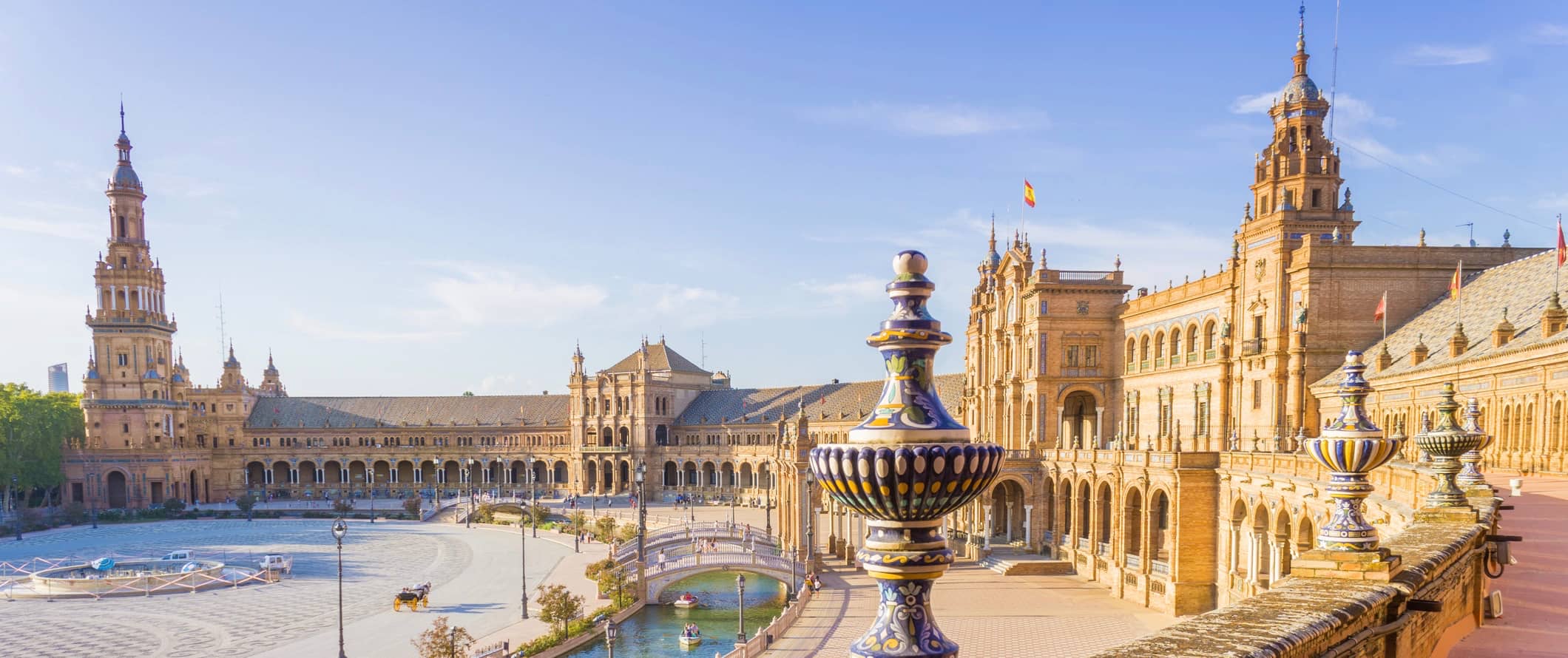
Public transportation – There is an extensive bus network that operates in Seville and can help you get from one edge of the city to another. Tickets can be bought on board and cost 1.40 EUR per trip. A one-day travel card, the Tarjeta TurÍstica, costs 5 EUR (10 EUR for a 3-day card).
Seville’s tram system connects to some of the further out areas of the city (and it’s air-conditioned). The tram is part of the same public bus system so tickets are the same price.
Bicycle Rental – Bike rentals are a great way to save money while seeing the sights from a new perspective. Rentals in Seville cost around 15 EUR per day.
Taxis – Taxis start at 2.50 EUR, with normal tariff being 1 EUR per additional kilometer. Skip them if you can as the prices add up fast!
Ridesharing – Uber is available in Seville but it won’t save you a ton so skip it and stick to the bus.
When to Go to Seville
Like most of southern Spain in Andalucía, Seville gets a lot of sunshine and has hot summers. I think the best time to visit is between March and May when crowds haven’t peaked but the weather is still warm and sunny.
The Easter season is especially popular in Seville because of the famous Feria (a large fair), which attracts hundreds of thousands of tourists and religious pilgrims. Part of the Semana Santa holy week, it’s a beautiful time to visit because of the colorful dresses and the many street activities and parades, but it does get crowded and expensive during the holy week.
In the summer (June-August), the weather is hot and sunny, with daily highs reaching upwards of 38°C (100°F). While the city is lively during the summer, it can be very taxing to explore in the heat.
The winter months (December-February) offer more comfortable temperatures, usually around 7-18°C (45-65°F). The city is much quieter, making it a nice time to visit if you want to beat the crowds and don’t mind some chilly days.
How to Stay Safe in Seville
Like most Spanish cities, Seville has a problem with pickpocketing and petty theft. The area around the Alameda de Hercules, a popular nightlife spot, was once very seedy and rife with crime and drug use, but that’s been cleaned up a lot in the past decade. Still, watch your bags when going out at night and avoid dark, empty streets if alone. Always keep an eye on your possessions when on public transportation as well.
If you go out at night, only bring the money you need and leave the rest locked up in your accommodation.
Tourist scams are prevalent as well so keep an eye out for groups of kids trying to distract you, as they’re probably trying to take your money. Additionally, be wary of people offering to carry your luggage. They may try to charge you a large fee.
When dining, keep your bags and belongings close and secure (especially when outside). Don’t leave your things on the table when going up to order. They can disappear quickly.
Read more about common travel scams to avoid here if you’re worried about getting ripped off.
Solo female travelers should feel safe here, however, the standard precautions apply (always keep an eye on your drink at the bar, never walk home alone intoxicated, etc.)
If you do experience an emergency, dial 112 for assistance.
Always trust your gut instinct and make extra copies of your important documents.
The most important piece of advice I can offer is to purchase good travel insurance. Travel insurance protects you against illness, injury, theft, and cancellations. It’s comprehensive protection in case anything goes wrong. I never go on a trip without it as I’ve had to use it many times in the past. You can use the widget below to find the policy right for you:
Seville Travel Guide: The Best Booking Resources
These are my favorite companies to use when I travel. They consistently have the best deals, offer world-class customer service and great value, and overall, are better than their competitors. They are the companies I use the most and are always the starting point in my search for travel deals.
- Skyscanner – Skyscanner is my favorite flight search engine. They search small websites and budget airlines that larger search sites tend to miss. They are hands down the number one place to start.
- Hostelworld – This is the best hostel accommodation site out there with the largest inventory, best search interface, and widest availability.
- Booking.com – The best all around booking site that constantly provides the cheapest and lowest rates. They have the widest selection of budget accommodation. In all my tests, they’ve always had the cheapest rates out of all the booking websites.
- HostelPass – This new card gives you up to 20% off hostels throughout Europe. It’s a great way to save money. They’re constantly adding new hostels too. I’ve always wanted something like this and glad it finallt exists.
- Get Your Guide – Get Your Guide is a huge online marketplace for tours and excursions. They have tons of tour options available in cities all around the world, including everything from cooking classes, walking tours, street art lessons, and more!
- The Man in Seat 61 – This website is the ultimate guide to train travel anywhere in the world. They have the most comprehensive information on routes, times, prices, and train conditions. If you are planning a long train journey or some epic train trip, consult this site.
- Rome2Rio – This website allows you to see how to get from point A to point B the best and cheapest way possible. It will give you all the bus, train, plane, or boat routes that can get you there as well as how much they cost.
- FlixBus – Flixbus has routes between 20 European countries with prices starting as low 5 EUR! Their buses include WiFi, electrical outlets, a free checked bag.
- SafetyWing – Safety Wing offers convenient and affordable plans tailored to digital nomads and long-term travelers. They have cheap monthly plans, great customer service, and an easy-to-use claims process that makes it perfect for those on the road.
- LifeStraw – My go-to company for reusable water bottles with built-in filters so you can ensure your drinking water is always clean and safe.
- Unbound Merino – They make lightweight, durable, easy-to-clean travel clothing.
- Top Travel Credit Cards – Points are the best way to cut down travel expenses. Here’s my favorite point earning credit cards so you can get free travel!
- BlaBlaCar – BlaBlaCar is a ridesharing website that lets you share rides with vetted local drivers by pitching in for gas. You simply request a seat, they approve, and off you go! It’s a cheaper and more interesting way to travel than by bus or train!
Seville Travel Guide: Related Articles
Want more info? Check out all the articles I’ve written on Spain travel and continue planning your trip:

The 7 Best Hotels in Madrid
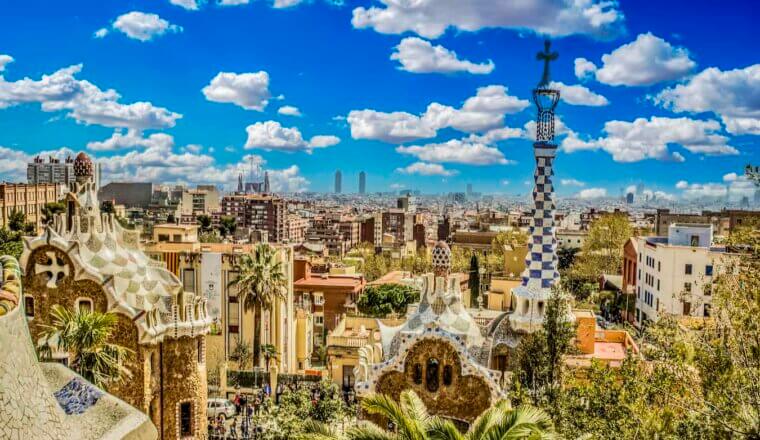
The 7 Best Hotels in Barcelona

The Best Walking Tours in Barcelona
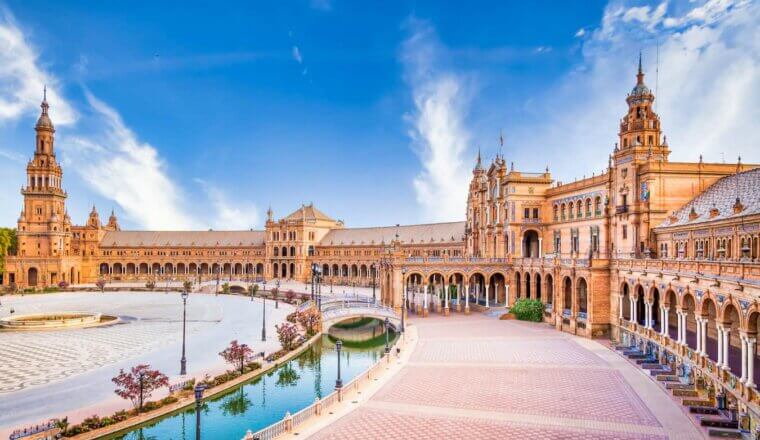
The Best Walking Tours in Seville
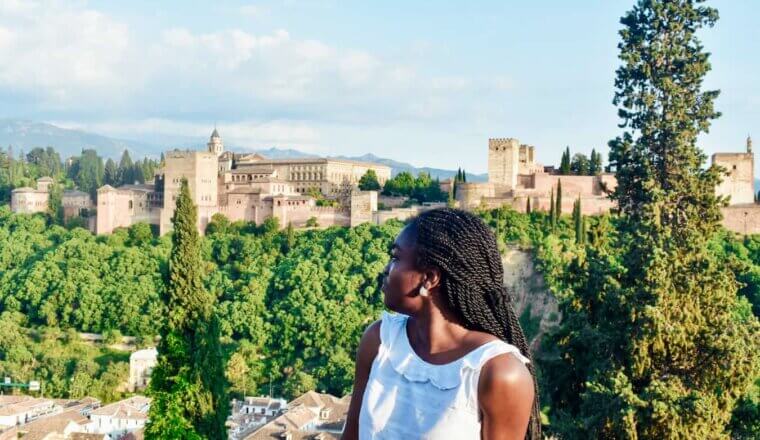
The Perfect 3 Day Granada Itinerary
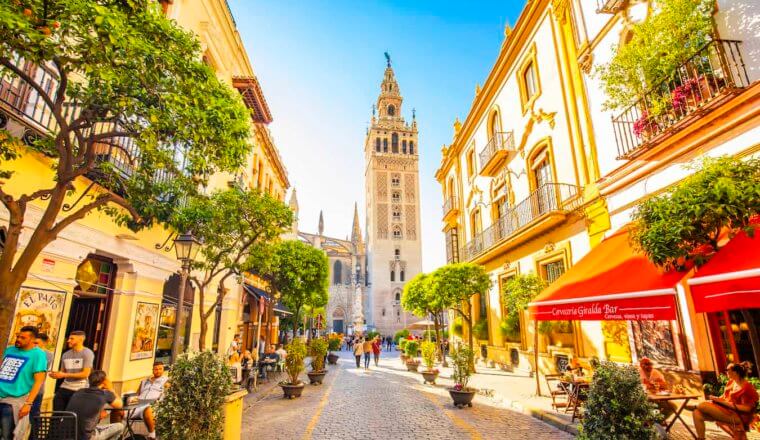
The 7 Best Hostels in Seville
Get my best stuff sent straight to you, pin it on pinterest.
- Where To Stay
- Transportation
- Booking Resources
- Related Blogs

- Cadiz Travel Guide
- Cordoba Province
- Granada Travel Guide
- Jaen Province
- Malaga Travel Guide
- Sevilla Travel Guide
- Andalucian Cuisine
Sevilla Province
The only seville two day itinerary you will ever need.
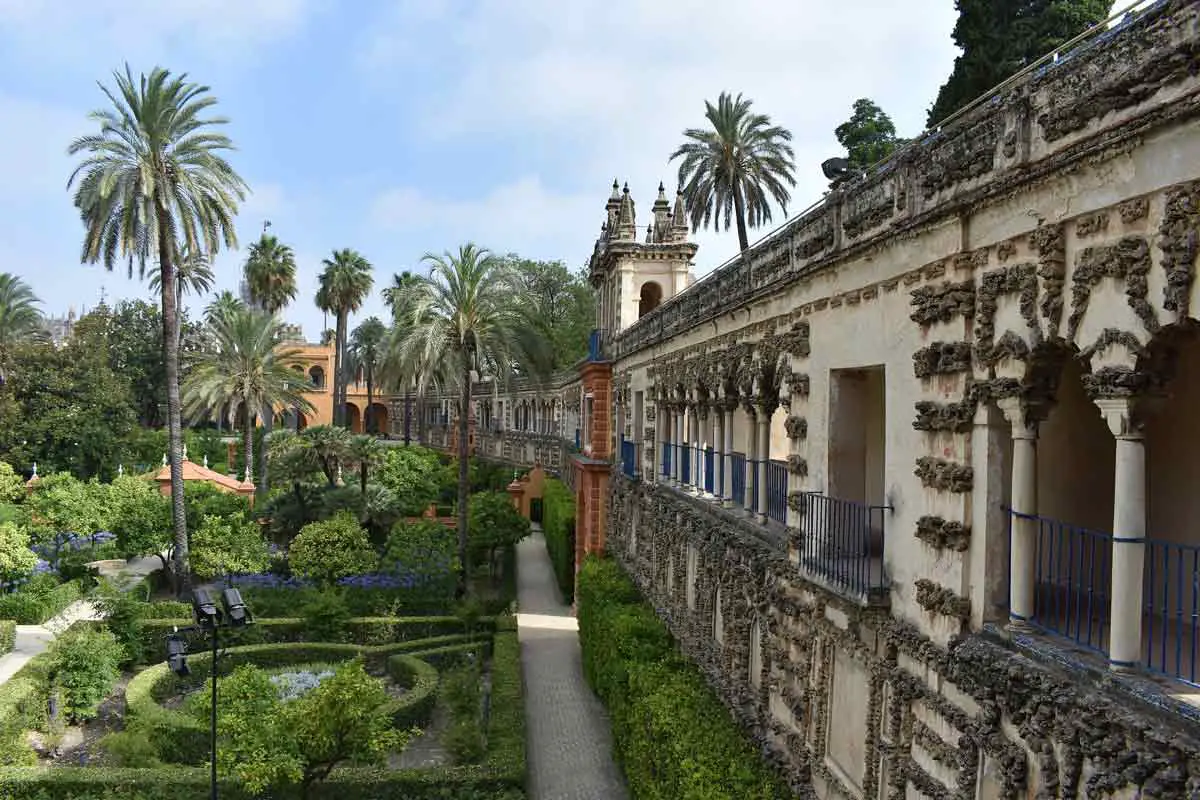
The Andalusian capital is not only one of the most alluring cities in Spain, but it’s also up there are one of the most picturesque and visually stunning cities in Europe.
Because of its compact size, and pedestrian-friendly nature, you’ll be able to see the best of Seville in two days. What’s more, because of the city’s location in the south of Spain, it’s a great destination for a short city break with pretty much-guaranteed sunshine throughout the whole year. Without any further due, let’s see how you can maximise your time in this Seville two day itinerary.
Two Days Seville Itinerary: Must See Places
Although the city is compact, there are a lot of things to see in Seville . Naturally, it’s going to be impossible to see everything in Seville in two days, so these are the unmissable attractions.
- Real Alcázar
- Cathedral of Seville & La Giralda
- Barrio Santa Cruz
- Plaza de España
- Parco de Maria Luisa
- Flamenco Shows and Tapas
- The Metropol Parasol (Las Setas)
- Palacio de las Dueñas
- Casa de Pilatos
- Torre del Oro (the Gold Tower)
- Alameda de Hércules
About Seville
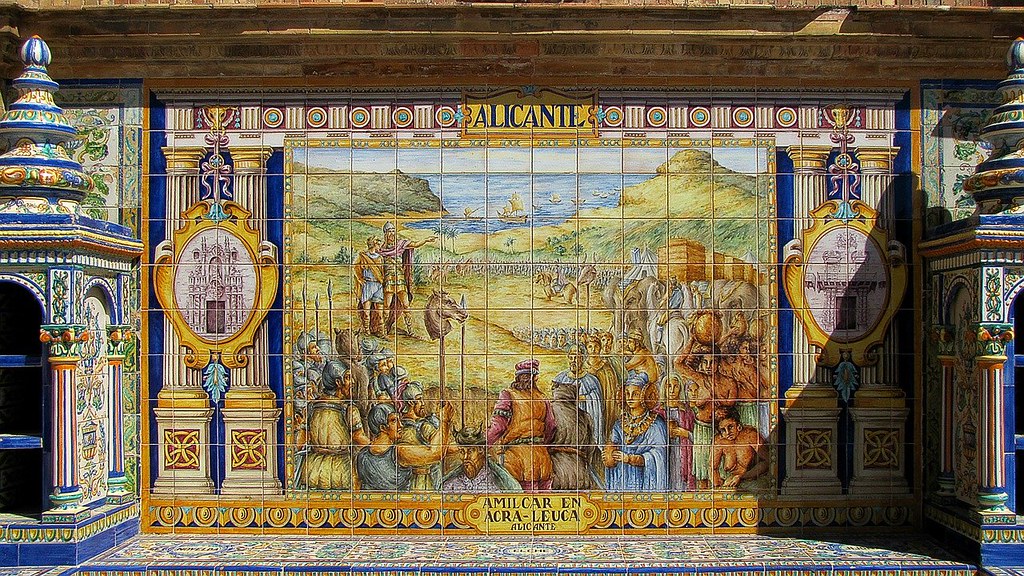
Seville’s eclectic history plays a huge part as to why the city is so visually stunning today. As with all ancient cities, they come with some fascinating legends as to how they were founded. In Seville’s case, it claims that it was by Hercules. FYI, it wasn’t.
Both the Greeks and Romans settled in what we know today as Seville , you’ll still find plenty of evidence of these civilisations both within the city and in the surrounding towns. There are ruins located under La Setas in the centre as well as just outside at Italica in Santiponce.
In 712, the city fell under the reign of the Arabs. Back then the city was called Isbilia , and the river that runs through the city was called Guad el Kevir . Over time, the names evolved to Seville and the Guadalquivir River.
The Arabs ruled the city for 500 years, so naturally left their mark with structures that still stand to this day. The most notable one is the Giralda, which is the name of the tower next to Seville Cathedral, and the city walls, the most intact section is called Muralla de la Macarena (the city walls at the Macarena) located to the north of the city.
Then in 1248, the Muslims were defeated in conquest and the city fell under the reign of the Christians. The city prospered in the late 1400s and became the location for the Chamber of Commerce. This is partly due to both Christopher Columbus, and his voyage to the Americas, and the cities strategic location next to the river. This meant that Seville became Spain’s wealthiest and developed city in Spain, and stayed that way up to the 1700s.
Both plague and the silting up of the river played their part in the demise of the city. The Chamber of Commerce then moved to Cadiz . In 1929, an event called the Ibero-American Exposition prompted the regeneration of the city, along with the building of the iconic Plaza de España and Maria Luisa Park.
Seville in 2 Days – Your Complete Seville Two-Day Itinerary
Day 1 highlights, day 1 – morning.
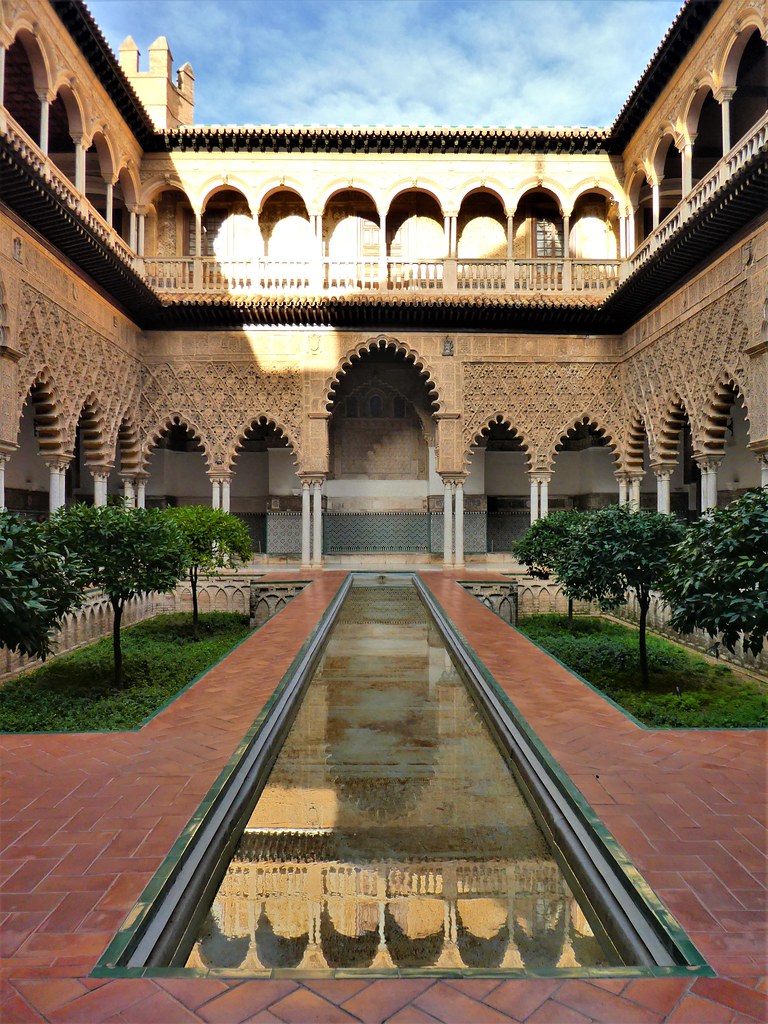
Start the morning at the magnificent Real Alcazar located in the heart of the historical city. Originally, this was built as a fort by the Muslims, then when the Christians conquered the city, it became the residence of the Spanish Kings.
Today, it’s a sprawling landmark, where each subsequent King added their mark to the complex. In 1987, the Real Alcazar became a UNESCO listed heritage site and is one of Seville’s must-see attractions.
To say the building is ornate is an understatement. Column adorned, grand, high ceilinged rooms, with intricate latticework stretching between them. This is called the Mudéjar style, which pulls influences from both Moorish and Christian design. If you’ve visited, or are planning on visiting the Alhambra in Granada , you’ll find plenty of parallels between them.
Although the entire palace is stunning, some of the most notable rooms are the Courtyard of the Maidens, Mudéjar Palacio de Don Pedro , Salon de Los Tapices and Salon de Embajadores.
The Real Alcazar does get busy, so it’s a good idea to book your ticket in advance to skip the queue. Although you can walk around by yourself, the information plaques are minimal, so for more information, either book the audio guide, join a tour or hire a private guide .
To enjoy the Real Alcazar fully, I recommend allowing 2+ hours here.
After exploring the Real Alcazar, continue your Seville two day itinerary by heading towards the gargantuan Cathedral of Seville and its neighbouring La Giralda . Like with the Real Alcazar, these both have UNESCO Heritage status.
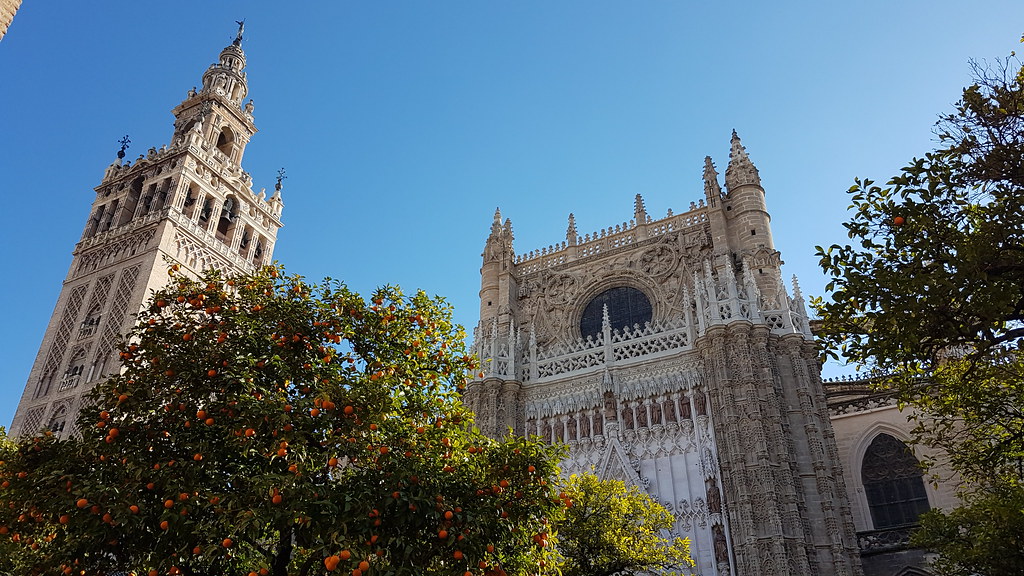
Seville Cathedral has two claims to fame, one is that it’s the biggest cathedral in the world, by volume and secondly, that it’s the resting place of Christopher Columbus. You can see his tomb inside.
During the Islamic rule, a Mosque stood here. When the Christians conquered the city they initially used the Mosque as a church. It was then demolished and rebuilt as a Gothic Style Roman Catholic Church. The completion of the cathedral was in 1506. However, the Giralda and the Orange Courtyard both date back to the Moorish times
You can climb the 350-foot high Giralda. You might expect steps leading up, but instead, you’ll find it’s a continuous ramp, winding round and upwards for 35 floors. But why a ramp? The Giralda was the minaret from the old mosque that once stood here. The ramps were used by horses who would carry the Muezzin to the top of the tower to call prayer.
The view from the top is stunning. You’ll be able to see a 360 view of the city below. The viewing platform is also the same level as the bells, it does get noisy if you coincide your visit with when they chime.
Again, like with the Real Alcazar, Seville Cathedral does get busy. Book your ticket in advance to skip the queues. To do it justice, you’ll probably want a couple of hours here.
After visiting the Cathedral, spend the remainder of the morning exploring the area called Barrio Santa Cruz . This is also a great place to stop for some lunch in one of the quaint tapas bars (in Spain, lunchtime is generally much later than the rest of Europe, typically at 2 or 3 pm).
This area is known as the Jewish District of the city. After the Christan Conquest, the leader Ferdinand III banished the Jews to this area of the city.

Barrio Santa Cruz is a myriad of narrow maze-like, cobblestone streets and alleys, opening out into small tree-clad courtyards with fountains and benches. It’s easy to get lost in this district, and that is exactly what you should do! History oozes from this area, and although you could enjoy wandering about by yourself, stopping off at the tapas bars and quaint artisan shops, you can delve into the history more by booking onto a guided tour of Barrio Santa Cruz.
Day 1 – Afternoon

From Barrio Santa Cruz, head towards Plaza de Espana . If you type Seville into any image search, I guarantee this will rank somewhere near the top of your findings.
The monument was built in 1929 as part of the Ibero-American Exposition in the style of Renaissance and Moorish architecture.
The red-bricked semi-circular plaza is lined with columns, bridges and balconies. Along the inner edge of the building, you find colourful tiled benches and images which represent every province of Spain. In the centre is a large fountain, and on a hot afternoon, you can catch the cooling spray from it, if you stand in the right place.
From Plaza de Espana, head towards the adjacent Parco de Maria Luisa. This large city park covers about 100acres. Make sure to allow plenty of time to discover the gazebos, fountains, tropical trees, and even museums which are all dispersed here.
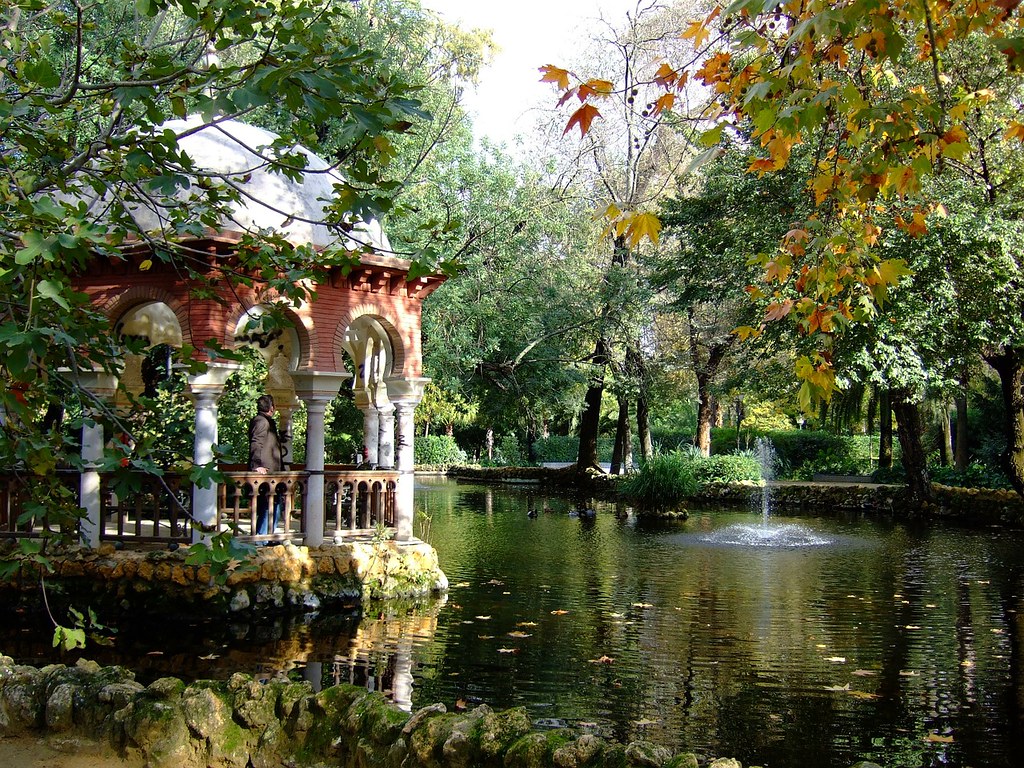
Maria Luisa Park is also a great place to head to escape the sun, with plenty of shaded benches. If you sit long enough, you’ll probably hear the squawking sound of the resident green parakeets which nest in the trees here.
Both Plaza de Espana and Parque Maria Luisa are free to enter , allowing about 1-2 hours to fully enjoy them. If you have the time, from Maria Luisa Park, head down towards the river and enjoy a stroll along the promenade.
Day 1 – Evening

It’s time to delve into the cultural side of Seville. The city is proud of its heritage and even today, still hold deep roots in folklore. Two traditions unarguably Seviliano are the Flamenco guitar and the Flamenco dance.
Flamenco performances are often intimate affairs, in a small venue allowing you to see and feel the emotion that the performers give. The fast rhythms are played out on a traditional guitar, often accompanied by percussion and clapping.
The dancers, especially the female dancers, dress in bright and beautifully coloured layered dresses. They are flamboyant and powerful in their movements, creating rhythms with their feet and intricate shapes with their hands and bodies to complement the music.
You can’t help but feel the emotion as you’re drawn into their storytelling through song and dance. Flamenco shows are popular, so book tickets in advance .
After watching the Flamenco show, head back towards Barrio Santa Cruz to enjoy a traditional evening meal (evening meals, like with lunchtime, are generally later than the rest of Europe, typically 10 pm onwards).
Day 2 Highlights
- Torre del Oro
Day 2 – Morning

The second day of your Seville in two days itinerary starts at La Encarnación square and the Metropol Parasol . The enormous wooden structure is affectionately known as Las Setas (The Mushrooms) and was designed by German architect, Jürgen Mayer, it was built in 2011. It’s also the largest wooden structure in the world.
The landmark is a bit of a love-hate affair, historically this area was a city market, and then a car park, the area surrounding the square wasn’t the most desirable area and overall needed regeneration. Today, it’s a hub of activity. Under Metropol Parasol, you’ll find a market, bars and restaurants. There is also a museum that houses Roman ruins which were discovered during the building of the Metropol Parasol.
On the upper level of Las Setas is a snake-like walkway, that meanders and undulates to view the city from above. There is no shelter at the top, so it’s advisable to visit either early in the day or late at night to avoid the harsh heat from the sun. In this itinerary, I recommend visiting early in the morning you could, however, push this activity to later in the day.
Allow about an hour at Las Setas. Book tickets in advance to skip the ques.
From the Metropol Parasol, head towards Calle Dueñas, which is where you will find the stunning Palacio de las Dueñas .

In terms of buildings that are just ‘wow’ for the senses, the Palacio de las Dueñas comes in at a close second to the Real Alcazar. The palace is stunning and often gets overlooked.
The palace was built between the 15-16th century and features a mix of Mudéjar and Gothic architectural styles. The reason this is so wow on the senses is that every surface is filled with some sort of detail.
The palace features courtyards, inner rooms (which still contain original family heirlooms) and beautifully manicured gardens. You can wander about by yourself, but to get a better insight into the affluent families that lived here, then it’s certainly worth hiring a guide.
Book your ticket in advance to skip the line and allow a couple of hours here to see everything.
From Palacio de las Dueñas take the 15-minute walk to another one of Seville’s stunning historical buildings, the Casa de Pilatos found on Plaza de Pilatos.
In visual terms, it’s a mixture of the Mudèjar style you saw at Palacio de las Dueñas twinned with the colourful azulejo tiles you saw at Plaza de Espana.

As you enter, you’ll start in a light coloured marble courtyard with a fountain in the middle, adorned with vivid geometric tiles, sculptures and statues. Similarly to the Palacio de las Dueñas, you could spend hours exploring and looking at every nook and cranny. There are elaborate murals and intricate latticework everywhere.
To skip the queue, book your ticket in advance . Allow at least an hour, longer if you have the time, to see everything.
From Casa de Pilatos head to the main square in Alfalfa and stop for lunch. This Old Town district is known for vintage tapas and wine bars (it’s worth checking out Bar Alfalfa IF you can get a table!), intertwined with hipster hangouts.
Day 2 – Afternoon
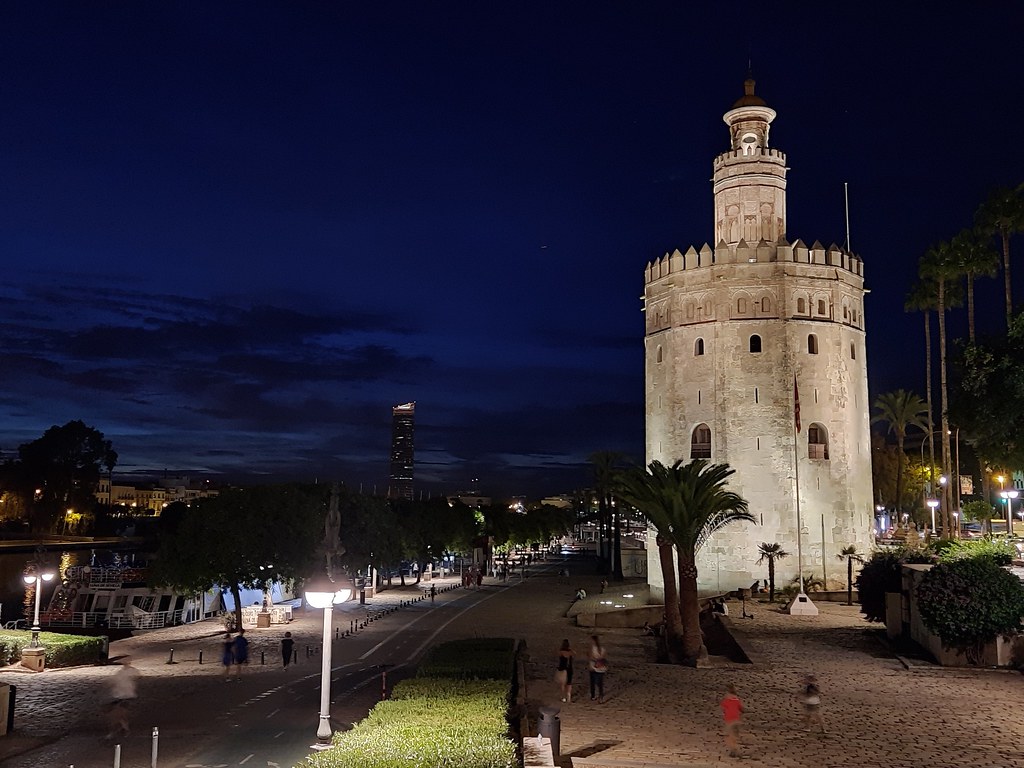
From Alfalfa, take the 20-minute walk to the Torre del Oro or Gold Tower. This tower dates back to the 13th century and originally was one of a pair of watchtowers that guarded the entrance of the city.
Today the tower houses a museum. The first floor is dedicated to the tower, and its importance to the city’s defences, the second floor is a nautical museum. The top-level is open to give views overlooking the city, and the Guadalquivir river. You’ll also be able to look across the river and see Triana, which is where you’ll be headed next.
From the top of the Gold Tower, you’ll also be able to see the Cathedral and gain some perspective as to just how big it is and how it dominates the skyline of the Old Town. Spend about an hour at the Torre del Oro before heading to the next destination on this 2 days in Seville guide.
From the tower, cross the nearest bridge and then turn right as you start to head into the pretty neighbourhood of Triana . Compared to the bustle of Seville centre, Triana has a much more residential and laid back vibe to it.

By now, you will have noticed how important the colourful tiles are in Seville’s building style, well Triana is where they originated. If you have time, head into the Centro Ceramica to find out more about the history of the area and tiles.
Two other places worthy of a visit here are Mercado de Traina , where you will find fresh produce and cute little eateries and the Castillo de San Jorge, which was rediscovered when the Mercado was being built. The San Jorge Castle sits under the market and contains the foundations of a castle that once stood here. It’s well informed, with lots of boards in English about the history of the area and the Spanish Inquisition .
You can easily spend a couple of hours in the neighbourhood of Triana.
Day 2 – Evening
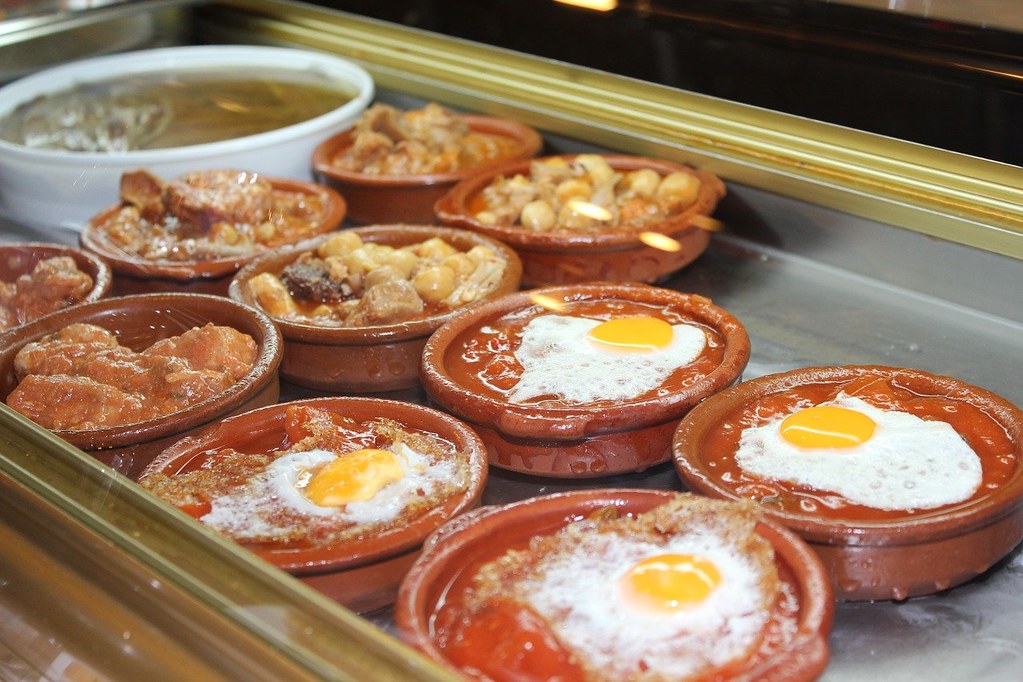
To finish your two days in Seville, cross back over the river, using the Puente de Isabel II . And meander your way up to Alameda de Hércules, often just referred to as Alameda.
This open plaza is the best place to go to experience Seville’s vibrant bars. During the day, it’s a relaxed affair here with locals and tourists sitting out in the sun, enjoying a Cerveza (beer) with friends and family.
By night, the focus is more on food, you’ll find every international style of cuisine as well as traditional Sevillan food here along with trendy bars and clubs.
Do a circuit of the whole plaza (it’s big!) to see where your mood takes you. No time for that? then two suggestions are Duo Tapas and Gigante Bar.
Duo Tapas is situated in an old church with hanging branches and lights twinkling above. Gigante Bar has a retro and vintage feel to it.
Final Thoughts on Seville in 2 Days
I hope you agree that Seville is a great destination for a short city break. Although you could spend much longer in the city, this Seville two day itinerary covers the must-see attractions.
If you have any questions about visiting Seville, then comment below and we’ll try our best to answer them.
For more articles about Seville, check out the suggestions below:
- How to spend Easter in Sevilla
- How to spend Christmas in Sevilla
- What to do in Sevilla in winter
Liked it? Pin it!

Disclaimer: Some of the links on this website are “affiliate links.” This means that if you click on the link and do a purchase, I will receive an affiliate commission at no extra cost to you. This helps me keep my website running and continue to share my travelling knowledge with you. I thank you for booking your flights or hotels using the links on my website. Regardless, I only recommend products or services I use personally and believe will add value to my readers.
Related Posts:
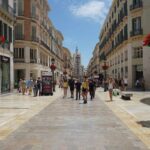
I am Joanna, the writer of this blog. I have been calling Andalucia home for the past few years, time in which I have explored extensively this beautiful land. This blog’s aim is to help you discover everything that Andalucia has to offer, from beautiful beaches to stunning mountains, from hidden white villages to off the beaten path experiences, from culinary adventures to fantastic road trips.
One thought on “ The Only Seville Two Day Itinerary You Will Ever Need ”
Pingback: 23 Great Things to Do in Seville for Free - Andalucia In My Pocket
Leave a Reply Cancel reply
Your email address will not be published. Required fields are marked *
Save my name, email, and website in this browser for the next time I comment.
Pocket Rough Guide Seville
This compact, pocket-sized Seville travel guidebook is ideal for travellers on shorter trips and those trying to make the most of Seville. It’s light, easily portable and comes equipped with a pull-out map.
This Seville guidebook covers: Barrio Santa Cruz, Barrio Alfalfa, Arenal and the Río Guadalquivir, El Centro, Sur, Barrio Triana, Barrio Macarena, La Alameda de Hércules, Los Remedios.
Inside this Seville travel book you will find:
Curated recommendations of places – main attractions, off-the-beaten-track adventures, child-friendly family activities, chilled-out breaks in popular tourist areas
Things not to miss in Seville – Alcázar, Flamenco, Giralda tower, Catedral, Barrio Santa Cruz, Feria de Abril, Tapas, Triana, Semana Santa, Parque de María Luisa, Museo Arqueológico and Museo de Costumbres Populares, Las Setas, Museo de Bellas Artes, Itálica, Monasterio San Isidoro del Campo
Ready-made itineraries samples – created for different time frames or types of trip
Seville at a glance – an overview map of Seville with key areas and short descriptions of what you’ll find there
Day trips – extra information for those on longer breaks or wanting to venture further afield
Practical travel tips – information on how to get there and around, health guidance, tourist information, festivals and events, plus an A–Z directory
Handy language section – themed basic vocabulary for greetings, numbers and food and drink
Independent reviews – honest descriptions of places to eat, drink or stay, written by our expert authors
Accommodation – handy reference guide to a range of hotels for different budgets
Pull-out map – easy to extract folded map with places to see marked
What’s new – a short overview of the changes in Seville in recent years for repeat travellers
Free download of the eBook – available after purchase of the printed Seville guidebook
Fully updated post-COVID-19
The guide is a perfect companion both ahead of your trip and on the ground. It gives you a distinct taste of Seville with a concise edit of all the information you’ll need.
Description
Book details.
This title is a part of Pocket Rough Guides
Pictorial, compact travel guides series to countries, cities and regions with a pull-out map and factual travel tips perfect for short trips and travellers seeking concise travel information and practical listings.
Concise practical travel information includes getting there, getting around, climate and safety tips, accommodation, food & drink advice and shopping essentials
Things Not to Miss at the beginning of each guide
Colour-coded places chapters with key coverage of places and sights in points-of-interest structure
Recommendations for accommodation, restaurants, shops and leisure activities for all budgets
Pull-out detailed maps with marked-up key sights or listings
Printed on paper from responsible sources verified to meet FSC’s strict environmental and social standards
Free eBook with each purchased printed guide from May 2019
Format: 102 x 190mm
Price: £7.99-£8.99 | $12.99-$13.99
Extent: 128–208 pages
BOOK DETAILS
Which payment options can I use in the Rough Guides Shop?
You can pay with credit card : Visa, MasterCard, American Express, and via PayPal .
How long will it take to receive my order from the Rough Guides Shop?
If you’ve ordered an ebook, it will be delivered to you via email immediately after your purchase.
For printed book orders, we offer DPD next day delivery in the United Kingdom and Northern Ireland and standard (2-8 days), priority (1-3 days) delivery options in the USA.
Please be aware that the delivery times are based on when your item was dispatched and not when you ordered your item. Unless stated otherwise, we intend to send items on the next available business day.
Currently we do not provide a tracking number for your order.
How can I contact Rough Guides about a shop order?
You can contact our shop team at " [email protected] ".
To help our team reply faster, please copy and use one of the following email subject lines:
- "Book shop: orders, shipping, returns"
- "Website: general usage and technical problems"
- "Guide books: corrections and other questions"
- "Tailor-made travel"
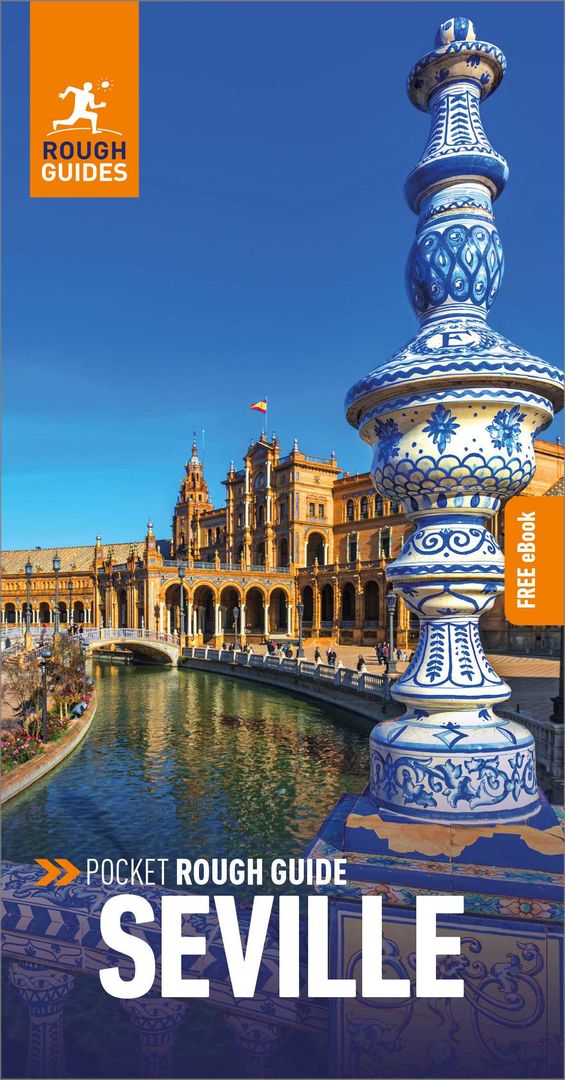
You might also love
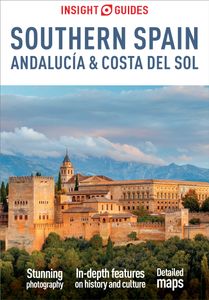
Insight Guides Southern Spain
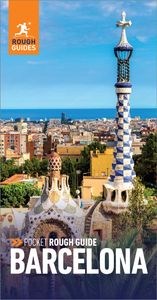
Pocket Rough Guide Barcelona
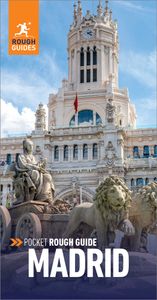
Pocket Rough Guide Madrid
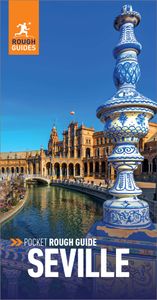
The Mini Rough Guide to Gran Canaria
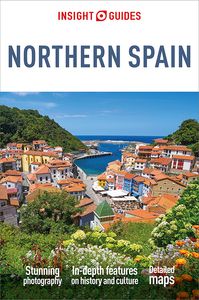
Insight Guides Northern Spain
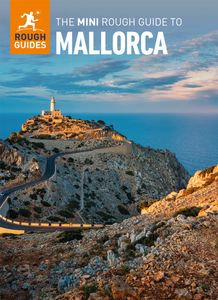
The Mini Rough Guide to Mallorca
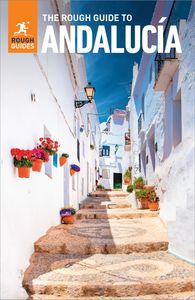
The Rough Guide to Andalucía
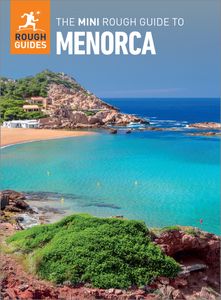
The Mini Rough Guide to Menorca
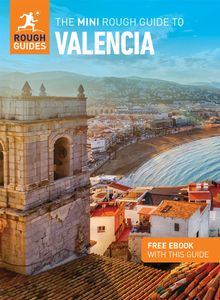
The Mini Rough Guide to Valencia
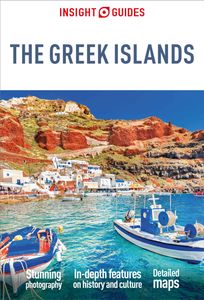
Insight Guides The Greek Islands

Insight Guides Southeast Asia

The Rough Guide to the Lake District
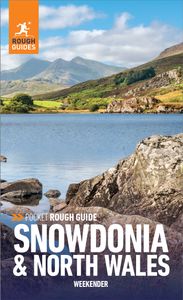
Pocket Rough Guide Weekender Snowdonia & North Wales

The Rough Guide to The Scottish Highlands & Islands

Pocket Rough Guide Stockholm

The Rough Guide to Bath, Bristol & Somerset

The Rough Guide to Prague
Seville Travel Guide
This article may contain affiliate/compensated links. For full information, please see our disclaimer here.
Welcome to Seville, a city that exudes charm and history with its stunning architecture, delectable cuisine, and lively flamenco culture. With its intriguing combination of ancient history and modern flair, Seville is a destination in Spain that will capture your heart… as it did mine!
I’ve visited Seville three times now and each time, I discover something new to love about this vibrant city. Whether you’re exploring one of the largest Gothic cathedrals in the world, taking in the stunning views of the city from the quirky Las Setas , or savoring some tapas and local wines, Seville will captivate you with its beauty, authenticity, and passion.
Read on to learn more as I share my essential Seville travel tips so that you can plan your dream trip!
Seville Facts and Figures
Today, Seville is recognized as one of the most beautiful and culturally rich cities in Spain, with a deep history and heritage that continues to attract visitors from around the world.
Here are some interesting facts about this beautiful city.
- Seville is the capital and largest city of the autonomous community of Andalusia in southern Spain, with a population of over 690,000 people.
- Seville was founded as the Roman city of Hispalis in the 2nd century BC and later became a major center of commerce and culture during the Islamic period.
- Seville played an important role in the Age of Discovery, with Columbus setting out from the city on his second and fourth voyages to the Americas.
- During the Golden Age of Spanish literature, Seville was home to many prominent writers and artists, including the playwright Lope de Vega and the painter Diego Velázquez.
- Seville was a center of political and cultural resistance during the Spanish Civil War, and many of its historic buildings were damaged or destroyed during the conflict. The city has since undergone extensive restoration and renovation, including the restoration of the Alcázar of Seville, which suffered damage during the war.
- Seville hosted the 1992 World Exposition, which brought major infrastructure improvements to the city and helped to boost its tourism industry. The Plaza de España, a grand plaza in the Parque de María Luisa, was built for the exposition and features elaborate tilework and a moat. Today, it’s one of the city’s main tourist attractions.
- Seville is known for its hot and dry summers, with temperatures regularly exceeding 40°C (104°F) in July and August.
- The Cathedral of Seville is the one of the largest Gothic cathedrals in the world and is the final resting place of Christopher Columbus.
- The Alcázar of Seville is a royal palace originally built by the Moorish rulers of Andalusia and is now a UNESCO World Heritage Site.
- Seville is famous for its cuisine, including dishes such as gazpacho, salmorejo, and pescaíto frito (fried fish).
- Flamenco, the traditional music and dance of Andalusia, originated in Seville and is still a vibrant part of the city’s culture today.
- Seville is the setting for many famous works of literature, including Don Juan by Lord Byron and The Barber of Seville by Pierre Beaumarchais.
- Seville has a rich history of bullfighting, with the Real Maestranza de Caballería de Sevilla being one of the most prestigious bullrings in Spain.
- The University of Seville is one of the oldest universities in Spain, founded in 1505 by Cardinal Francisco Jiménez de Cisneros.
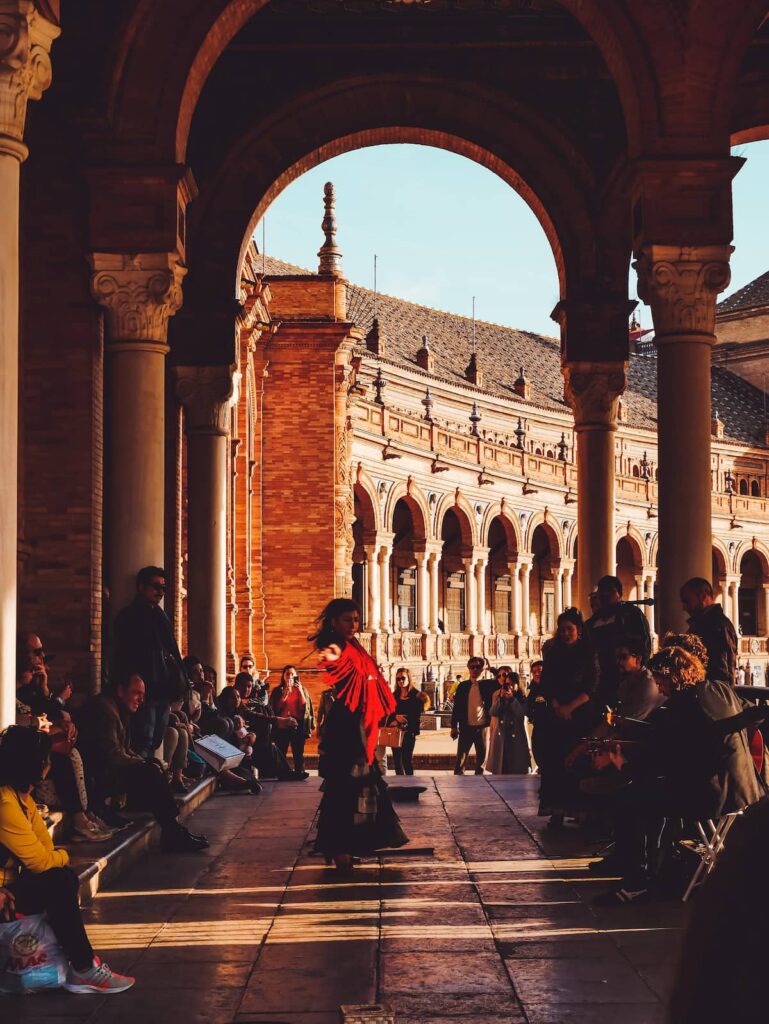
Visiting Seville, Spain: Travel Tips
Here’s what you need to know to plan your trip to Seville.
Getting to Seville
Seville is a major hub for transportation in southern Spain, with an international airport and high-speed rail connections to Madrid and other cities so it’s super easy to get here.
Travelling from Cadiz to Seville? Then check out our Cadiz-Seville transport guide for everything you need to know.
If you’re coming from outside of Spain, it’s best to fly into the city. Seville has its own international airport, the Seville Airport (SVQ), which is located about 10 km from the city center. It offers direct flights from many European cities, as well as some destinations in North Africa.
There are also some domestic flights from other Spanish airports but depending on where you’re coming from, you may be better off taking a train or bus versus flying (more on that next!).
The Seville airport is pretty small so don’t expect much on top of the basic services and amenities.
Seville is well-connected by rail to other cities in Spain, including Madrid, Barcelona, and Malaga. The Santa Justa train station is located about 2 km from the city center.
Here are approximate travel times for trains to Seville from other major Spanish cities:
- Train from Madrid to Seville: The AVE high-speed train connects Madrid and Seville in about 2.5 hours, making it the fastest way to travel between the two cities. I’ve done this journey before and it’s super comfortable and fast – I would highly recommend it!
- Train from Barcelona to Seville: The fastest way to travel from Barcelona to Seville is by AVE high-speed train, with a travel time of about 5.5 hours.
- Train from Valencia to Seville: The travel time between Valencia and Seville by train is about 6 hours, with direct connections available by high-speed train.
- Train from Malaga to Seville: The travel time between Malaga and Seville by train is about 2 hours, with direct connections available by high-speed train.
Tip: Travel times may vary depending on the specific train service, departure time, and any connections involved. It’s always best to check schedules and book your tickets in advance to ensure a smooth and efficient journey to Seville. Typically, tickets are available up to 4 months before your travel date. Head to the Renfe website (be sure to toggle to the English language for easy navigation) to search for your routes.
Seville has a modern bus station, the Estación de Autobuses Plaza de Armas, which serves many domestic and international destinations.
The bus station is located not too far from the historic center and depending on where you’re staying, you may be able to walk there. If not, no worries. Ths bus station is also a local transportation hub and there are numerous public buses that serve the station (lines 3, 6, 21, 43, A2, A7, C3, EA).
You can search for and buy bus tickets online and the bus company will depend on your departing destination. ALSA , which runs services across Spain, is a good place to check first.
Travel times may vary depending on the specific bus service, departure time, and any connections involved but here are some estimated travel times:
- Bus from Madrid to Seville: The travel time between Madrid and Seville by bus is approximately 6 hours, with several bus companies offering regular services.
- Bus from Barcelona to Seville: The travel time between Barcelona and Seville by bus is approximately 14 hours, with direct connections available from some bus companies.
- Bus from Valencia to Seville: The travel time between Valencia and Seville by bus is approximately 10-12 hours, with some services requiring a transfer in Madrid.
- Bus from Malaga to Seville: The travel time between Malaga and Seville by bus is approximately 2.5 hours, with frequent direct connections offered by several bus companies.
As you see, taking a bus to Seville takes longer so if you’re short on time, then traveling by train is the best option. That said, bus tickets are cheaper so there is a trade-off.
If you prefer to drive, Seville is well-connected to other cities in Spain by highways and roads.
However, keep in mind that parking in the city center can be challenging, so it’s best to park outside and take public transport or walk. On my last trip of Seville, our car basically stayed in its parking lot during our entire stay there as we walked everywhere.
Car Rental Recommendation
If you’re looking for the best prices for car rental during your stay in Spain, check out Discover Cars . Just plug in your location and dates and you’ll get the best deals available. Super convenient and easy!
Getting Around Seville
Once you’re safely in Seville, getting around the city is easy. Most of the key tourist attractions and places of interest are located within Seville’s historic center, so the best way to get around is by foot.
You can easily plan your days to focus on specific areas if you’d like to minimize walking across the city. Walking around Seville is also an awesome way to get a taste of the city’s vibe and maybe even stumble across some hidden gems!
If you’d like to be a bit more mobile, there are bike and electric scooter rentals located around the city. It’s fairly inexpensive and what’s more, it’s a fun way to explore Seville! There are bike lanes available on the larger streets, although I don’t believe any are available within the historic center itself. If you do decide to go with an electric scooter, do note that the uneven ground in the historic center will make it a bit challenging to scooter quickly.
Seville has an efficient and modern public transportation system, including buses, trams, and a metro line. The public transport network covers most areas of the city and is relatively inexpensive. As a visitor, I would say that you’re most likely to use the tram or buses.
Buses in Seville
The bus system in Seville is extensive and easy to use. Bus stops are clearly sign-posted and you can buy a bus ticket when you board. Buses typically run from around 6.00am to 11.30pm and there are some night buses that run until 2.00am. At the time of publishing, a single-journey ticket costs €1.40.
There are also two transport card options that offer more value for money:
- Tarjeta Multiviaje is a rechargeable card (with a refundable deposit for the card) that can be use on buses and the tram. The minimum amount is seven euros and when using this card, each journey costs less than a single-journey ticket (under €1). You can buy and recharge a card at kiosks and estancos (tobacconists). This is ideal if you’re taking multiple bus or tram journeys during your Seville visit.
- Intended for short visits, Tarjeta Turista offers a one-day card (€5) or three-day card (€10) with unlimited travel. These can be purchased in the TUSSAM Information Points at Prado San Sebastián, Plaza Ponce de León y en Avda. Andalucía, 11. Like the Multiviaje, there’s a €1.50 deposit fee.
For more information on buses in Seville, visit the TUSSAM website .
Tram in Seville
Called the MetroCentro, the T1 tram is a short-distance tram with just 4 stops. It goes south from Plaza Nueva through the centre of the city (with a stop next to the Alcazar( to the San Bernardo train station.
A one-way ticket costs €1.20 and you can buy tickets at the machines on the tram platform (be sure to validate them when you get on the tram!). It’s cheaper if you have a Tarjeta Multiviaje card.
Taxis in Seville
Taxis are a convenient and efficient way to get around Seville, especially for if you are traveling in a group, have mobility issues, or when you need to travel with luggage. That said, there are some taxi drivers that take advantage of tourists so here’s what you need to know about taking a taxi in Seville.
Taxi fares in Seville are metered and are based on the distance traveled and time taken. There are additional charges for weekends, holidays, night journeys, and for carrying luggage. You can expect a taxi from the airport to the center of Seville to cost around €20. ( Click here to see a breakdown of how tariffs and charges are imposed.)
There are taxi stands located throughout the city, including at major transport hubs, such as the airport, train station, and bus station. You can also flag down a taxi on the street, but it’s often more convenient to use a taxi stand to avoid any confusion or misunderstandings.
Taxis in Seville are generally safe and reliable, but it’s always best to take precautions when using any form of public transport. Make sure to only use licensed taxis, check the meter is running, and keep your belongings with you at all times.
Best Time to Go to Seville
In my opinion, the best time to visit Seville is during the spring (March to May) or autumn (September to November) months. During these periods, the weather is pleasant and comfortable, with warm days and cool nights. The crowds are also thinner, and prices for flights and accommodation are generally lower.
In spring, Seville is in full bloom with colorful flowers and lush greenery. This is the perfect time to visit the city’s many parks and gardens, including the famous Parque de María Luisa and the stunning Alcázar Gardens. The city also celebrates its annual Feria de Abril (April Fair) during this season, where locals and tourists come together to enjoy flamenco music, dance, and traditional food.
Autumn is another great time to visit Seville, as the weather is mild and perfect for exploring the city on foot. This is also the season for the annual International Film Festival of Seville, where film enthusiasts gather to watch the latest independent films from around the world.
I’ve visited Seville twice during the autumn months and it’s my favorite time to visit in terms of vibe, weather, and activities.
I would discourage you from visiting Seville in the summer months. Summer in Seville can be scorching, with temperatures often exceeding 40°C (104°F). The high temperatures can make it uncomfortable to explore the city during the day, and many locals take their holidays during this period. However, if you don’t mind the heat and crowds, summer can be a good time to experience the lively nightlife and outdoor events and festivals that take place throughout the city.
Winter in Seville is mild, with occasional rain and cool temperatures. If you’re looking to avoid crowds, then winter in Seville is for you. I’ve visited Seville in February towards the tail end of winter and loved my time there. It was still lively but not overly crowded and some days, with the warm sunshine on me, it didn’t even feel like winter! Learn more about winter in Seville in this article.
Overall, the best time to visit Seville depends on your preferences and travel style. Spring and autumn are generally the best seasons for comfortable weather, fewer crowds, and affordable prices. For a closer look at the weather in Seville and tips for enjoying the weather, read this article. You can also read our more in-depth article on the best time to go to Seville .
How Many Days to Spend in Seville?
Seville is lively and vibrant and there’s a lot to do here! On my first visit, I was in Seville for only 3 days and felt so sad to leave. I recommend spending at least three to four days in Seville to get a good sense of the city and its attractions. This timeframe would allow you to explore the historic center, visit the main landmarks, and experience the local culture and cuisine.
Ideally, if you have time to spare, I suggest 4 to 5 days in Seville as this would allow you to include a day trip in your itinerary. Seville to Cordoba is one of the most popular day trips and it’s well worth the effort – I’ve done it myself! Other day trip possibilities from Seville include the ancient Roman city of Italica or the charming town of Carmona.
However, if you’re short on time, it’s still possible to see the highlights of Seville in just a weekend (that is, 1 to 2 days). In this case, I recommend focusing on the must-see attractions and planning your itinerary carefully to make the most of your time in the city.
- Check out our One Day in Seville Itinerary to help you plan the perfect day!
- Have more time? Then our Seville 2-day itinerary might work for you
- For the ideal trip, spend 4 days in Seville
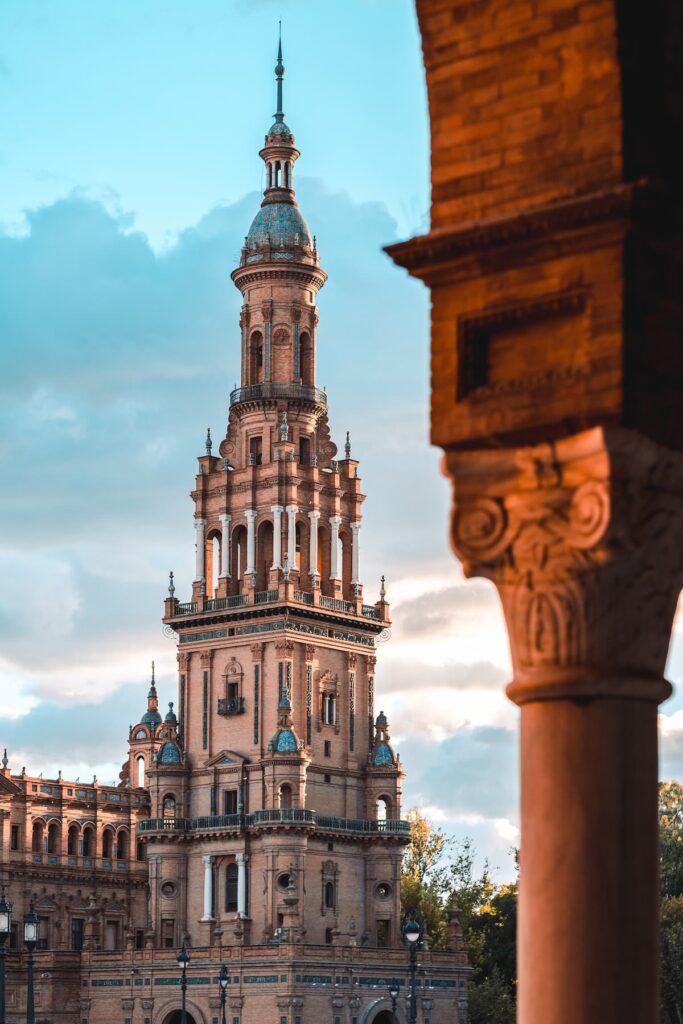
What to Do in Seville, Spain
Here’s a quick overview of the best things to do in Seville, Spain:
- Marvel at the Real Alcázar: This stunning palace complex is one of Seville’s top attractions, with its beautiful gardens, intricate architecture, and fascinating history. Here, you’ll get a closer look at the city’s Moorish past and it’s a wonderful complement to the Alhambra, if you’re visiting Granada as well.
- Explore the Cathedral of Seville: This massive Gothic cathedral is the third largest in the world and boasts impressive features such as the Giralda Tower and the tomb of Christopher Columbus. The walk up the Giralda is long and steep but the view is totally worth it!
- Wander around the Santa Cruz neighborhood: This charming, historic district is filled with narrow streets, picturesque courtyards, and traditional houses, making it the perfect place to wander and soak up the local culture. I’ve gotten delightfully lost in this neighborhood but didn’t mind it at all.
- See a flamenco performance: Seville is known as the birthplace of flamenco, and there are many opportunities to experience this passionate dance form through performances at local venues. I’ve watched flamenco twice in Seville and both times, the performances were so emotional and moving.
- Wander around the Plaza de España: When you say Seville, it’s often a picture of the Plaza de España that comes to mind. This iconic landmark is a must-see, with its grand size, stunning architecture, and intricate tilework depicting each province of Spain. If you’re lucky, you might come across flamenco artists performing here… it’s such a cool experience!
- Explore the Triana neighborhood: For a more authentic, down-to-earth side of Seville, head across the river to Tirana. This lively and colorful district is known for its vibrant nightlife, local markets, and ceramic shops. Tirana feels more lived-in and real and it’s fun to wander around the neighborhood.
- Go to the Metropol Parasol (aka Las Setas) : Here, you can enjoy a more quirky side of Seville. This modern and innovative wooden structure is a unique addition to Seville’s skyline and provides stunning views of the city. You’ll find a mix of locals and tourists just hanging out and it’s a great place to people-watch.
- Visit the Museum of Fine Arts: Calling all art-lovers! This museum houses an impressive collection of Spanish art, including works by famous painters such as Velázquez and Murillo. (Pssst, entry is free for EU nationals!)
- Stroll along the Guadalquivir River: If you want a spot of relaxation, a walk along the Guadalquivir will do the job. This scenic river provides a unique perspective of Seville, with views of iconic landmarks such as the Torre del Oro and the Maestranza bullring. Take in the sunshine, the sights, and mingle with locals.
- Visit the Mercado de la Encarnación: I love learning about a city through its food and there’s no better way to do that than to visit a local market. This indoor market is a food lover’s paradise, with its wide variety of fresh local produce, meats, and seafood.
These top 10 attractions provide a well-rounded experience of Seville’s history, culture, and beauty and you can easily cover them in 3 to 4 days! For the full list of things to do in Seville, click here .
And the fun doesn’t stop in Seville when the sun sets – check out the best things to do in Seville at night .
If you’re looking to spend some time by the sea, check out the best beaches close to Seville .

Recommended Tours & Activities in Seville
- Discover the city’s highlights on a free walking tour ! I love walking tours and take them whenever they’re available. They’re an awesome way to get to know a city when you first arrive.
- The line to enter Seville Alcazar is notoriously long (I once had to change my plans as the line was too long!) so it’s good idea to skip the line and buy your ticket in advance . If you’re a history lover like me, then you may also be interested in a guided tour of the monument so that you can learn more about its history.
- The Seville Cathedral is also a super popular tourist attraction. Click here to buy your entry ticket (includes the Giralda) in advance.
- Want to visit the Alcazar, Cathedral, and Giralda in one day? Join a local guide in this 2.5-hour tour which includes all entry tickets.
- It’d be a shame not to watch flamenco while in Seville! Check out this flamenco show in a historic venue or this flamenco show in Tirana .
- Enjoy a relaxing day out on the river on this 2-hour yacht tour when you can admire Seville from the water.
- Get acquainted with some of the best spots to eat in Seville in this tapas crawl (yummy!).
- Shop at the market like a local and learn how to make traditional Spanish dishes in this cooking class in Seville .
Here are other popular activities in Seville:
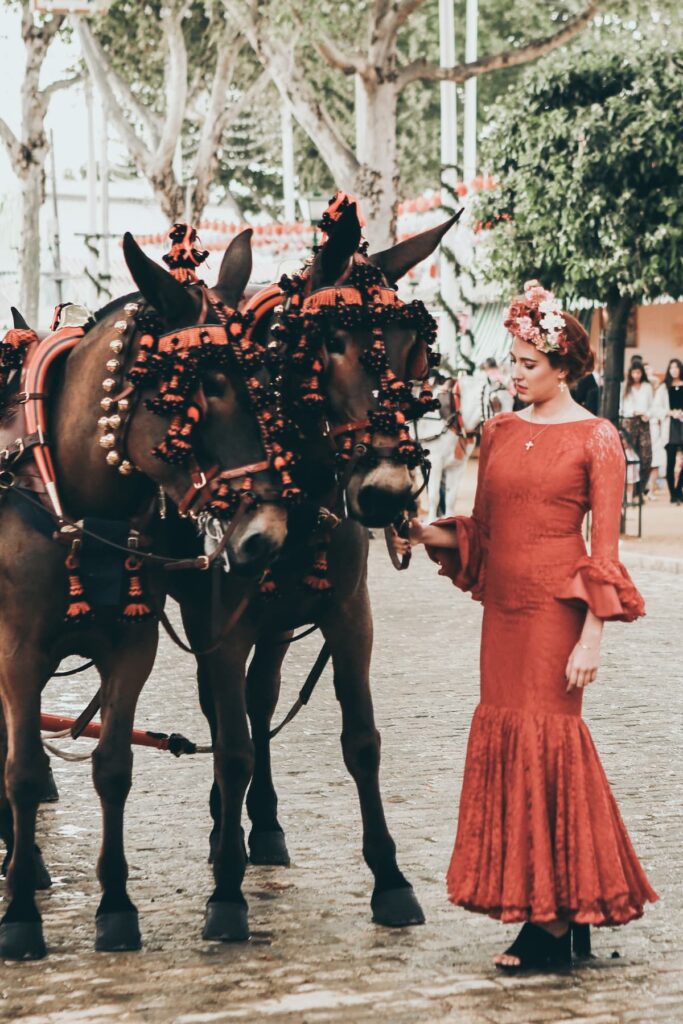
Festivals in Seville
Seville is known for its vibrant and colorful festivals which celebrate the city’s rich history and culture. These three festivals provide a glimpse into Seville’s rich history and culture, and they are a great way to experience the city’s unique traditions and customs.
Semana Santa (Holy Week)
Semana Santa is a major religious holiday in all of Spain and it is especially impressive in Seville. The celebrations in Seville are said to date back to the 16th century and today, the traditions live on.
Locals spend all year preparing for this week-long festival thattakes place in the week leading up to Easter.
Processions of elaborately decorated floats (called pasos ) carrying statues of the Virgin Mary and Jesus, wind through the streets of Seville, accompanied by the mournful sound of music played by marching bands. Some of the processions last up to 12 hours with devoted locals carrying the pasos !
The main processions take place in the city center, around the Cathedral and other historic churches. You can get more infromation on the Semana Santa routes in Seville on this website .
Tip: For a memorable sight, stand by the river and watch the processions come from Triana over the Puente de Isabel II.
Feria de Abril
This week-long festival of music, dancing, and traditional dress is one of the most important events on the Sevillian calendar. Feria de Abril typically takes place two weeks after Holy Week, and it celebrates Seville’s cultural heritage.
The fairground is set up in the district of Los Remedios, with hundreds of colorful tents (called casetas ) set up for eating, drinking, and dancing. The streets are filled with people wearing traditional flamenco dresses and suits, and the atmosphere is festive and joyful. Expect horse-drawn carriages, flamenco music, and tons of fun!
The fair also features a large amusement park, with rides and attractions for all ages. Feria de Abril is an unforgettable way to experience Seville’s vibrant culture and traditions.
Bienal de Flamenco
If you love music and dance, then you can’t miss the Bienal de Flamenco in Seville.
This biennial festival celebrates flamenco, a traditional Spanish art form that combines singing, dancing, and guitar playing. Today, it is one of the most important flamenco festivals in the world.
During the Bienal de Flamenco, you’ll find performances by some of the most renowned flamenco artists, as well as up-and-coming talents. The shows take place in various venues throughout the city, including historic theaters, flamenco clubs, and outdoor stages.
The festival also offers workshops, lectures, and exhibitions that explore different aspects of flamenco culture so it’s the ideal time to learn about the history and evolution of flamenco, as well as the various styles and techniques used in the art form.
The Bienal de Flamenco is a unique opportunity to experience the passion and intensity of flamenco, and to immerse oneself in the rich cultural heritage of Seville. It is a must-see for anyone interested in flamenco or Spanish culture.
The festival will be next held in 2024. For more information, check out the official website .
Tip: Seville goes into overdrive when there’s a festival so if you’re planning a visit during one of these times, it’s a good idea to book your accommodation in advance.
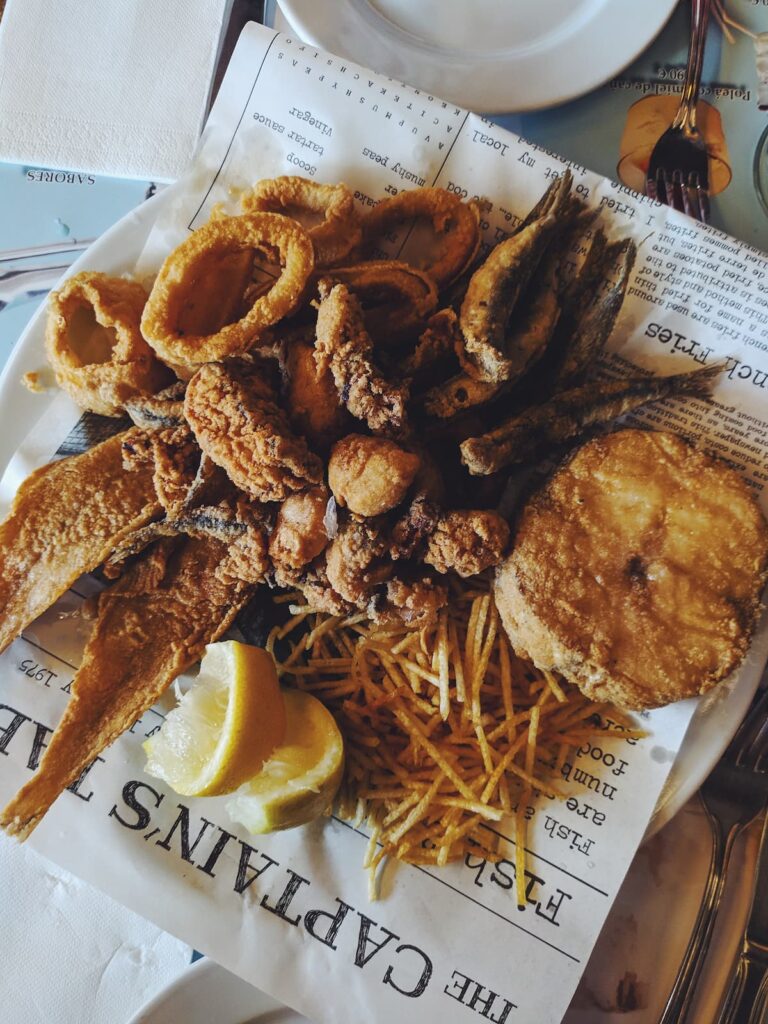
What to Eat in Seville
Ain’t nothing like food to get to know a place! If you’re excited to check out Seville’s culinary delights, you won’t be disappointed! Here, you’ll find some Spanish national favorites but also some local delicacies that are unique to the icty.
Some of the most popular local dishes and must-try foods in Seville include:
- Tapas: Seville is famous for its tapas, small plates of food that are perfect for sharing. Some popular tapas dishes include tortilla española (Spanish omelet), croquetas (deep-fried balls of bechamel and filling), and montaditos (small sandwiches).
- Gazpacho: This cold soup is made with tomatoes, peppers, cucumbers, bread, olive oil, and garlic. It’s perfect for hot days in Seville and is a refreshing and healthy option.
- Pescaíto frito : This is a fried fish dish that is popular throughout Andalucia. It’s usually made with small fish such as anchovies or sardines, and it’s often served as a tapa.
- Huevos a la Flamenca: This dish consists of baked eggs in a tomato sauce with chorizo, ham, and vegetables. It’s a hearty and flavorful dish that is perfect for breakfast or brunch.
- Solomillo al Whisky: This is a pork tenderloin dish that is cooked with whisky, garlic, and olive oil. It’s a classic Sevillian dish and is often served as a main course.
Sevillanos also love their desserts, and there are many delicious options to choose from, such as tocino de cielo (a rich egg yolk dessert), torrijas (similar to French toast), and yemas de San Leandro (sweet egg yolk candies).
So, as you wander around Seville, don’t forget to spot these items on the menu and give them a try!
More on Seville
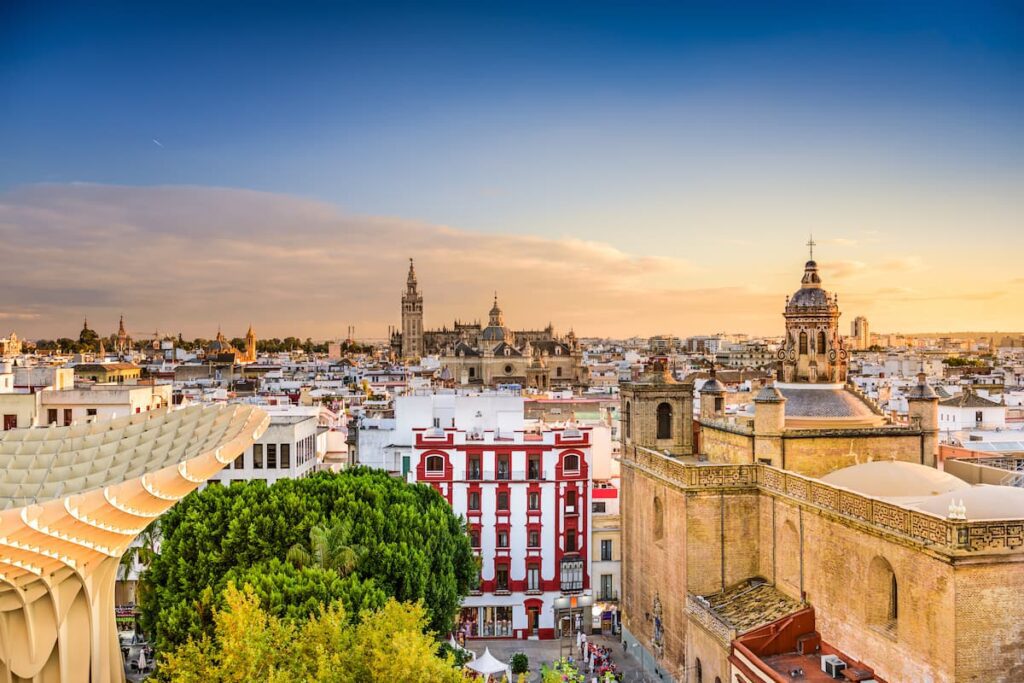
The Ultimate Guide to Seville in 2 Days


One Day Seville Itinerary: See the Best of Seville in 24 Hours
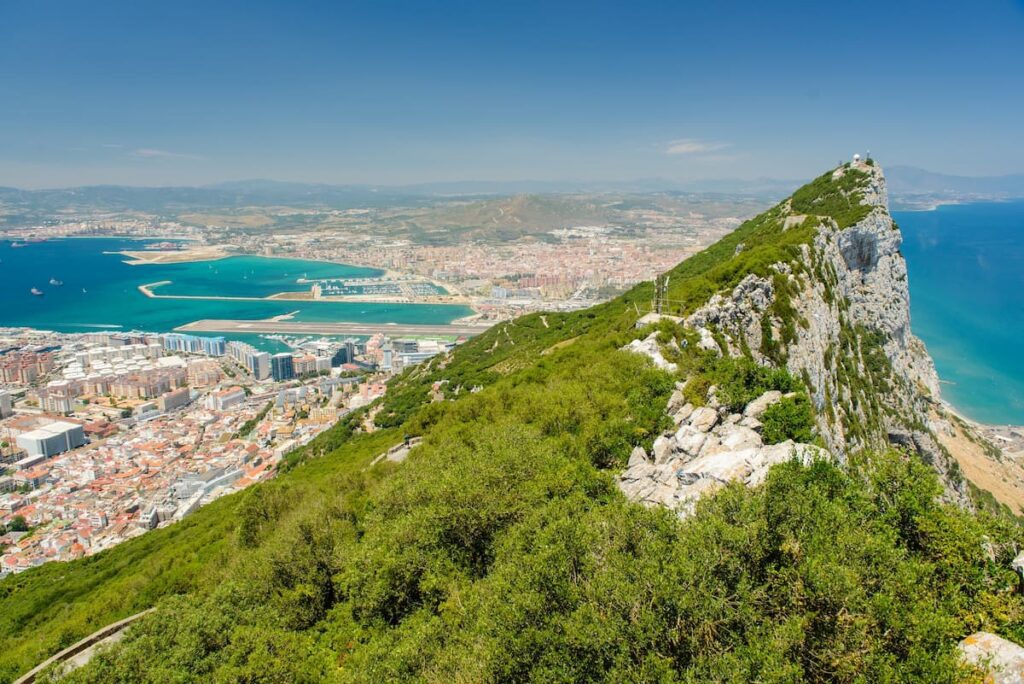
Gibraltar Day Trip from Seville: All You Need to Know (2023 Guide)

Seville to Granada Day Trip: The Perfect One Day Itinerary
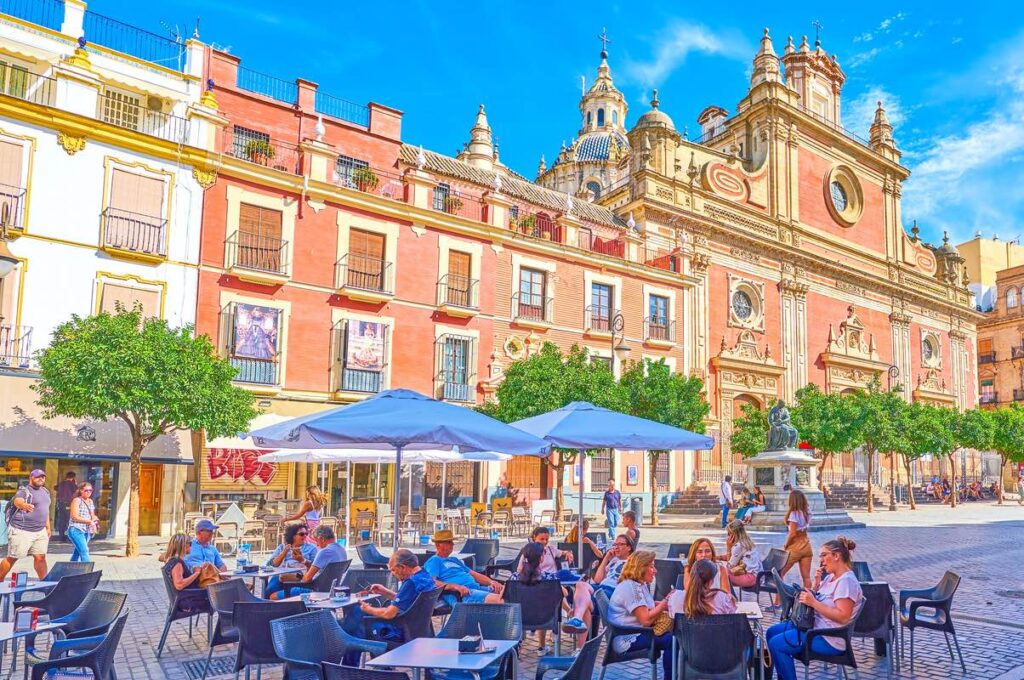
Cadiz to Seville: Ultimate Transport Guide (2023)
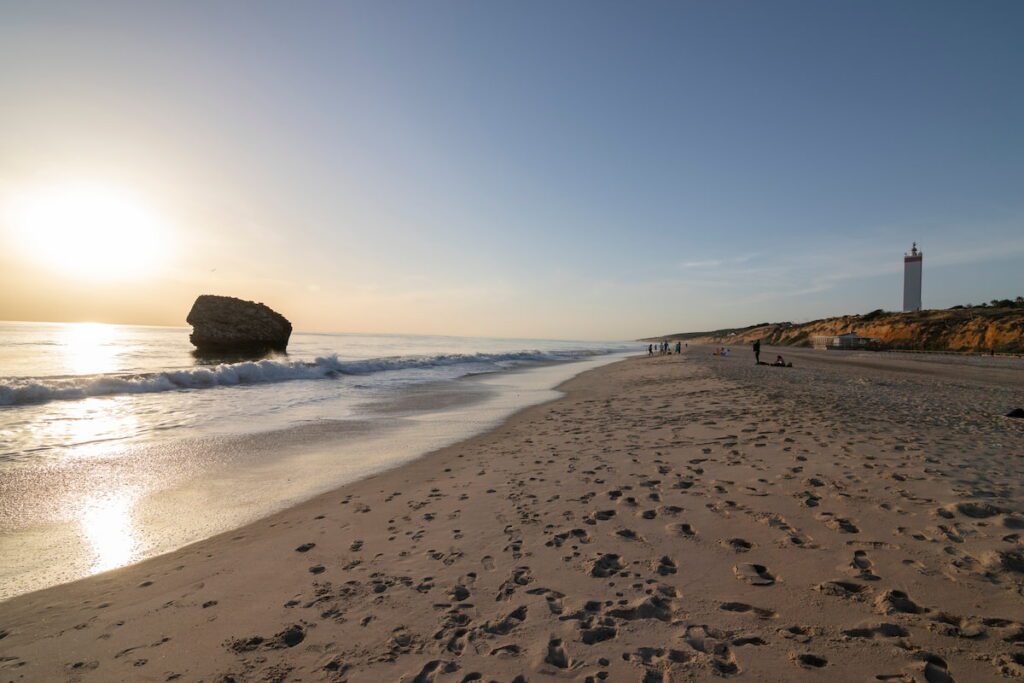
Discover the Best Beach Near Seville for Your Next Vacation (2023)
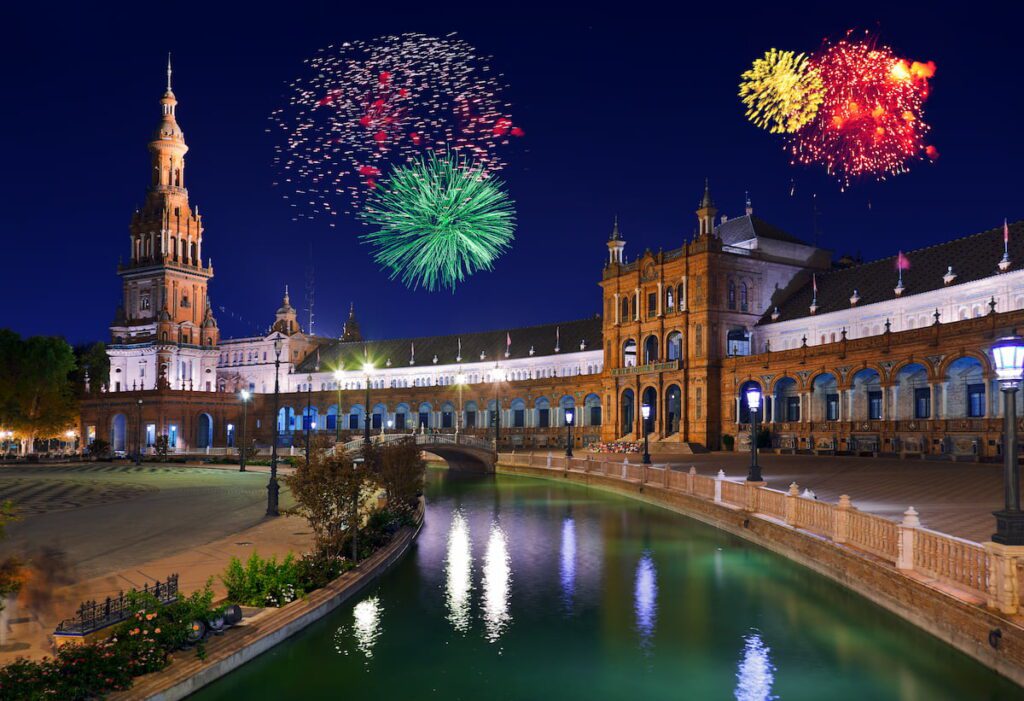
Winter in Seville: Weather, Things to Do, and What to Expect
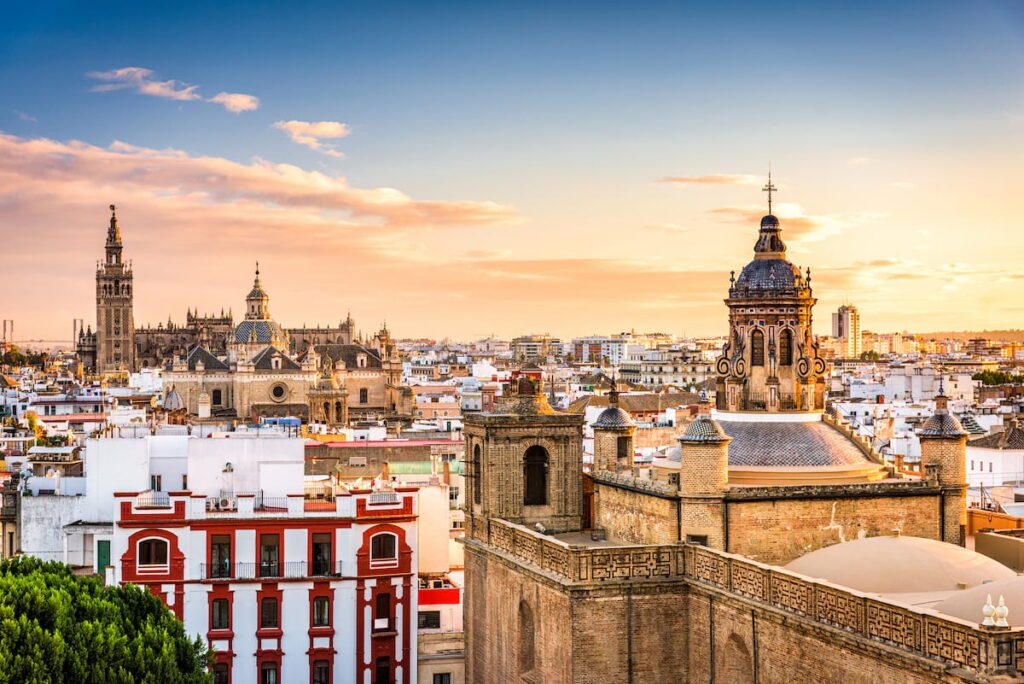
26 Marvelous Things to Do in Seville, Spain (Don’t Miss Them!)

4 Days in Seville: What to See and Do for an Unforgettable Trip
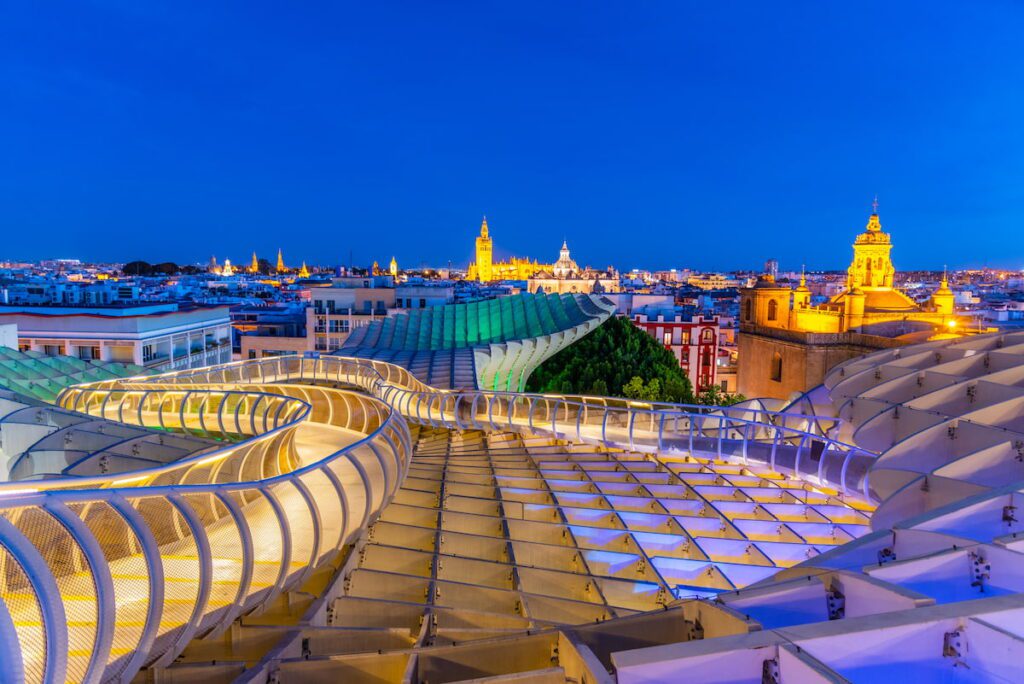
Best Things to Do in Seville at Night (2023 Guide)
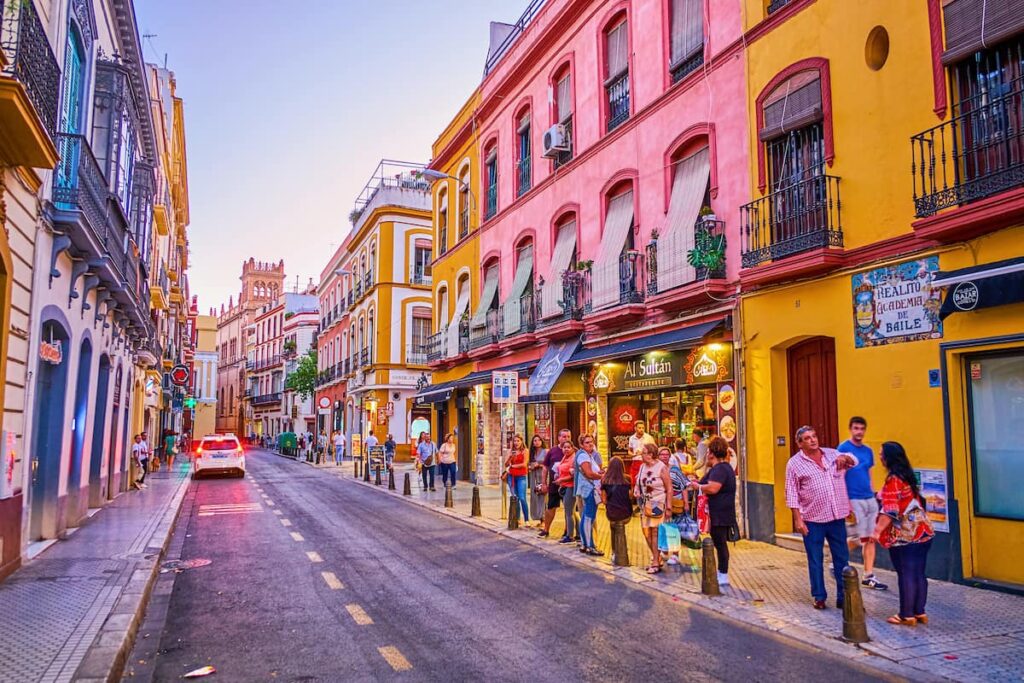
Best Time to Visit Seville, Spain: A Comprehensive Guide
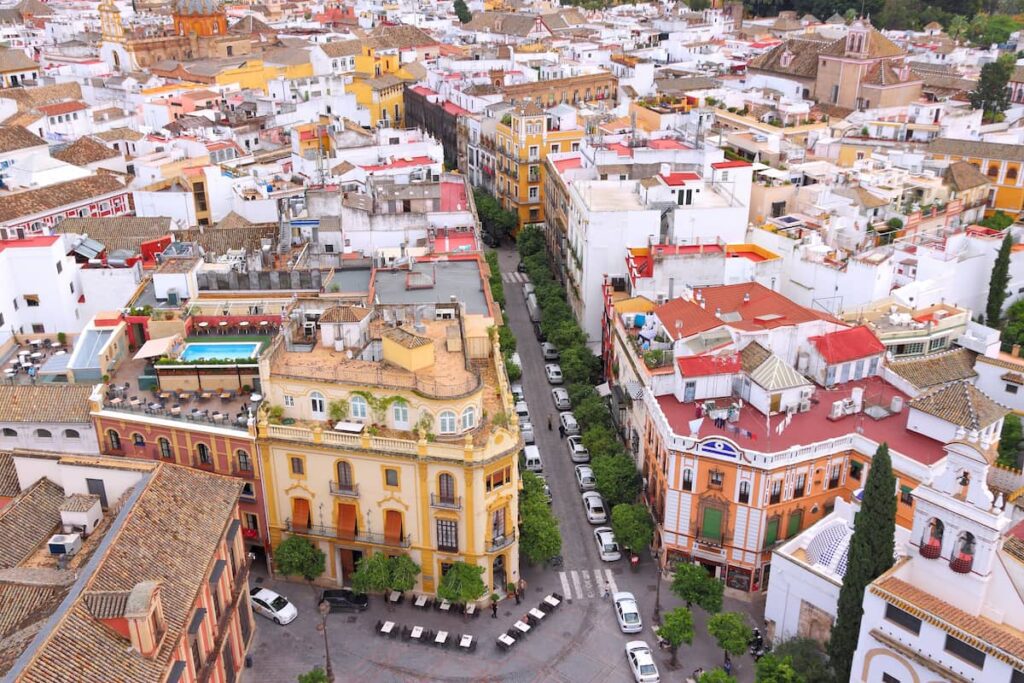
Seville, Spain Weather: When to Go, Travel Tips & FAQs
The Ultimate Guide To Seville, Spain
Seville, located in the Andalusia region of Spain, is a charming city with incredible architecture, a rich history and a great food scene. There’s a host of wonderful things to do in Seville that are perfect for a long weekend city break.
In this post, I’ll share all the secrets and only the very best things to do for your next Seville trip including where to eat, drink and stay. I’ve travelled to this region of Spain several times and with the addition of a few up-market restaurants and hotels, not much has changed in 2024!
Find the hidden gems and epic roof terraces in my Ultimate Guide To Seville!
Why visit Seville?
With its jasmine-scented air, orange trees and magnificent monuments, Seville attracts visitors from all over the world and for good reason. For most of the year, you can sit in a sun-filled cobbled stoned square (even in January), enjoy traditional tapas, catch a flamenco show in the evening and immerse yourself in the vibrant culture, there’s a lot to see and do in Seville!
It’s one of the most appealing cities in Spain and probably one of the most affordable too when compared to other European cities. Seville also makes a great base for exploring other parts of Andalusia – in my opinion, the most attractive region in Spain – check out the best 7-day tours from Seville here .
Here’s what not to miss in Seville!

THINGS TO SEE & DO IN SEVILLE
Seville cathedral.
Seville Cathedral is the largest Gothic cathedral in the world and you’ll find it in the heart of the old town, its grandness is very hard to miss. Inside is just as spectacular, there are 80 chapels and many historical relics to explore. One of those is Christopher Columbus’s final resting place and you must also stop by the domed Chapter House to admire the paintings of Murillo, there is a great deal of history under one highly detailed Gothic roof!
GIRALDA TOWER
Don’t miss the Giralda Bell Tower climb (35 stairs, if you wondered) for epic panorama views over the city of Seville, it is well worth the effort. You can also book these queue jump tickets ahead of time, which will take you straight into the cathedral and includes the bell tower admission – it’s definitely one of the best things to do in Seville.
When to visit the Seville Cathedral?
A great time to visit the Cathedral is in the late afternoon – around 4pm, at this time there are fewer crowds and much better lighting.
REAL ALCAZAR PALACE
While the Cathedral might be the most striking landmark in Seville The Real Alcazar Palace is the most famous and wandering around it is one of the best things to do in Seville – despite the crowds it draws.
Discover intricate gold ceilings, gorgeous courtyards with colourful tiles, tall palm trees, fountains and exotic gardens as you walk from one attractive courtyard to the next. The restaurant’s terrace might be my favourite part of the whole experience, here you can take a coffee break with peacocks roaming the patio, so very dream-like.
Similarly to the Alhambra in Granada , the Real Alcazar is opulent, and decorative and shows many influences of Moorish Spain. Also, just like the Alhambra it draws a huge crowd and lines of people queuing to get in, to avoid a wait in the glaring sun, book your skip-the-line ticket here .

HISTORICAL GUIDED TOUR
If you’re looking for a historical guided tour of all three of the above main attractions; Cathedral, Giralda Tower, and Alcazar then I recommend this highly rated small group tour , you’ll get a private entrance and a local guide to show you where all the hidden treasures are in half the time! All three sights are just a short walk from each other, but there can be annoyingly long queues at each, if you don’t want to waste time, this is your best option.
Book: Seville: Cathedral, Giralda & Royal Alcazar Guided Tour
PLAZA DE ESPANA
Plaza de Espana next to Maria Luisa Park is another spectacular sight you cannot miss when visiting Seville. Created around a grande semi-circle with striking coral bricks and blue and yellow tiles, it’s a feast for the eyes.
Along the perimeter of the Plaza, you will find an emerald-green canal with fountains and bridges, there’s even paddle boats for hire if you wish to float your way around for a bit of fun. Most people just hang out here, take pictures, relax and have a breather from the bustling old town, sometimes there’s an impromptu (mini) flamenco show for entertainment as well – more on that below!
TIP! Arrive in time for sunset and take a walk through the lovely Maria Luisa Park on the way, at this time the sunlight will be beautiful, read this post for more sunset tips!

THE REAL MAESTRANZA
Seville’s bullring is a historic landmark dating back to 1762, it’s one of the oldest (and largest) in Spain and is just a short walk from Plaza de Espana. Bullfighting has a long-standing tradition in Spain and many of the cities have their own bullring, however, these days most are used for festivals or to showcase via a walking tour.
The Real Maestranza in Seville is I must admit pretty impressive, it is housed within a beautiful baroque building and the red and yellow colours are quite striking. If you’re looking to learn more about the culture of Spain and visit the museum, hop on a short guided tour – it’s run frequently throughout the day. You can also check out this guide for more Spanish Culture tips!
BARRIO SANTA CRUZ
Barrio Santa Cruz, also known as the medieval Jewish Quarter is the real heart of Seville and the most desirable area to walk around. A typical Spanish old town with a maze of winding cobbled streets and picturesque squares to lose yourself in.
The best thing to do is wander, find local tapas bars and enjoy a nice café latte in one of the pretty orange-filled courtyards, framed by the typical white and yellow houses of this region. Check out Plaza Alfaro and Plaza Dona Elvira, they are two of the best.
Historical sights in Barrio Santa Cruz:
- Rosina’s Balcony
- Casa de Murillo
- Palacio Duenas
- Casa de Pilatos

TAPAS FOOD CRAWL
Tapas hopping is the primary social event in Seville’s oldest quarter – Barrio Santa Cruz. There’s an overwhelming amount of beautiful restaurants, hole-in-the-wall places and traditional local haunts to take your pick from – and with such a variety, it’s hard to know where to start!
If you want to order more than a ham croquette staple and have a bit of fun doing so, then why not kick start your culinary adventures with a local guided tour with a few like-minded people? This highly rated small group tour will take you to three different neighbourhoods and markets in Seville.
Book: Seville: Tapas Crawl Tour
TRIANA NEIGHBOURHOOD
Exploring the local neighbourhood of Triana is one of the best things to do in Seville. Situated across the Guadalquivir, Triana is full of flavour and you’ll find some of the best local arts, crafts and ceramic stalls as well as authentic flamenco .
After exploring the streets you could go for an traditional bite to eat at Triana Market or check out the trendy Hotel Zenit rooftop terrace for a drink, it’s probably the most sleek in the whole of Seville!
SEVILLE FLAMENCO
One of the best experiences in Seville is spending an evening watching the live performances of enchanting musicians and flamenco dancers, it’s a must-do! Not all shows are the same, but one of the best options is a show at Casa de la Memoria – a very special little theatre dating back to the 15th century.
A good alternative is Los Gallos Tablao in the central historical district of Barrio Santa Cruz, watch the talented performers in an intimate venue and wonderful location. If you’re visiting in summer, the later shows are best.
HISTORICAL HOTELS
From former Palaces to stately Manors and luxury iconic stays, many wonderful historical properties in Seville have been converted into the most amazing hotels. Some of the best include dreamy courtyards, outdoor patios, roof terraces, traditional Andalusian tiles, arches and original ceiling beams – all the Old World character you could wish for!
Hotel Alfonso XIII , boutique Corral del Ray and Placido y Grata are three of the best examples. If you not lucky enough to be staying there, you can easily visit and check out the restaurants, roof terraces and lobby’s.
Book a stay at a beautiful Historic Hotel
LA TERRAZA ROOF TERRACE
What not to miss in Seville – the secret rooftop terraces! After a day of exploring enjoy a cool drink at one of Seville’s best rooftop bars with a special view. Stylish La Terraza at the top of EME Hotel has the perfect outlook over the Cathedral, a long bar with tall stools and a fab cocktail menu.
La Terraza is one of the best places to go to for sunset, head there early as it’s very popular- and the atmosphere is wonderful!
Love rooftop terraces? You can also check out the Pura Vida roof terrace at Los Seises Sevillia – this boutique hotel also is a popular sunset spot with a Seville Cathedral view.

TIME FOR A DAY TRIP?
Seville is well placed to visit some spectacular gems in Andalusia , from the local vineyards to the famous Pueblo Blancos (white villages). With gorgeous landscapes and white-washed photogenic houses set amongst rolling green hills, they are a must-visit.
There are dozens of these white villages across the Sevillian countryside, but a few of them are really outstanding namely Ronda and Arcos de la Frontera. If you have one spare day, book this small group tour to see the best of this area!
Book: Seville: White Villages & Ronda Small Group Full Day Tour
WHERE TO EAT IN SEVILLE
The food in Seville is delicious and inexpensive – even the fancy restaurants and it’s worth knowing where they are in advance to avoid the usual mediocre tourist fare. Some are well-known restaurants while others are hidden local gems or simply too beautiful not to be missed!
El Pinton is a beautiful restaurant, dine on the attractive terrace after a visit to the nearby Seville Cathedral for the perfect afternoon treat. It’s not all about looks though, the food is also presented well and delicious – I visited twice!
El Rinconcillo
El Rinconcillo is well known in Seville, dating back to 1670 it’s also the oldest and for that alone deserves a visit – if you can get in! It’s busy as a tourist hotspot these days, but you don’t have to wait for a table, you can stand at the bar with a drink and tapas.
La Chunga is a great option if you fancy a break from the old town, choose from a variety of tapas with a modern twist. I can recommend ordering around 4 or 5 dishes, especially the risotto, it was fresh and tasty.
Torres Y Garcia
Torres Y Garcia is another of my favourite finds in Seville, a hip restaurant serving delicious food and ambience. Make sure you arrive early, this restaurant is one of the busiest in town – grab a local wine at the bar while you wait for a table.
On Ovejas Negras
On Ovejas Negras is another well-located restaurant just a few steps from Seville Cathedral that serves modern tapas with a great atmosphere. The restaurant is quite trendy for the area and finishes late into the night.
Filo is one of the best coffee shops in Seville with two locations to choose from, both equally good. Head here if you are nearby, they also serve good sandwiches and smoothies and the surrounds are dreamy boho.
Best restaurant in Seville
El Pinton is the best restaurant in Seville, it has the aesthetics and tasty food to match – and the location couldn’t be more ideal. Just a stone’s throw from the Cathedral – seek El Pinton after your visit you won’t be disappointed!

WHERE TO STAY IN SEVILLE
Seville is a very walkable city and to be in the best possible location I recommend staying nearby the beautiful old town just moments from all the sights and sounds. Barrio Santa Cruz , Triana and El Arenal are all excellent neighbourhoods in Seville offering attractions on the doorstep and fantastic accommodations.
BEST ACCOMMODATION IN SEVILLE
When it comes to accommodation in Seville, you’ll find small boutique hotels with original character and charm and many stunning boutique hotels, some even have rooftop pools. Whether you’re looking for a luxury hotel, boutique or an apartment, this list has something for you!
Here’s my top picks for where to stay in Seville!
Luxury Hotels
- Hotel Alfonso XIII check prices
- Querencia de Sevillia check prices
- Hotel Mercer Sevillia check prices
Boutique Hotels
- Hotel Boutique Corral del Ray check prices
- Placido y Grata check prices
- Hotel Amadeus check prices
- Mylu Suites check prices
- Well Done Apartments check prices
- Suites Maestranza Santas Patronas check prices
SEVILLE TIPS
Seville is a popular European city to visit, I highly recommend booking your tickets online and in advance to avoid waiting in long lines, particularly the Real Alcázar, where the queues can be enormous!
Book at least a week in advance for the best flamenco show and the guided skip-the-queue tour of Seville’s top three attractions; Alcázar, Cathedral and Giralda – note this tour fills up fast, book it as soon as you can it’s one of the best things to do in Seville!
BOOK ACTIVITIES
How to get to seville.
Seville is a very accessible destination with good flight and train connections from other European cities and local trains to other places in Andalusia.
The nearest Airport to Seville is Sevilla International Airport (SVQ). Seville is fortunate to have an airport and it’s just a 20-minute taxi ride from the centre of town. There’s also an airport bus that runs approximately every 25 minutes to the station nearby Santa Cruz the journey time is around 35 minutes.
Costs: Taxi €25-30, Bus €4
The train is the best way to get to Seville if you’re already in Spain. Seville’s Santa Justa train station is well connected with high-speed trains to other major Spanish cities, including, Cordoba (50 minutes) and Malaga (2 hours). It is recommended to book in advance and check times before departure. Check rail travel here .
Seville has two centrally located bus stations, Plaza de Armas and Prado de San Sebastian. If travelling by bus around Andalusia you are in for countryside views and long and windy roads and the buses are relly coaches, you can look at the time table and reserve your seat here .
GETTING AROUND SEVILLE
Seville Old Town is very walkable, you can walk around pretty much everything in this guide in less than 40 minutes! Triana is just across the bridge and if you’re heading to the city centre it will be an extra 20 minutes to Macarena.
If you’re planning on exploring more of the region and the attractive towns near Seville; Cordoba or Carmona and the interesting smaller villages ‘Pueblos Blancos’ hiring a car will be a more convenient and flexible way to do it. Consider using Discover Cars , they provide a comparison of car rental prices from various vendors across Seville ensuring you find a great rate – it’s an effective way to secure a rental without the hassle!
SEVILLE FAQ
When to visit seville.
Seville has good weather all year around with mild winters and hot summers, where temperatures regularly exceed 40 degrees! March to May is the best time to visit Seville when the gardens are lush and green and the evenings are light. In these months there are also fewer crowds and better hotel prices – Seville is one of the best winter-sun destinations closer to home.
Is Seville warm in January?
Is Seville warm in January – yes! January in Seville is actually mild (16-18 Celsius) compared to other regions in Europe. Seville is always an attractive destination and the activities and accommodation can be enjoyed with appealingly low rates from January to March.
How many days in Seville?
A long weekend in Seville is perfect if you only plan on visiting the highlights, if you have 2 full days this is possible, but I recommend at least 3 nights to do it justice. In 3 nights you can absorb the vibrant culture better, wander around more and factor in a holiday-enhancing activity in Seville or nearby.
Is Seville expensive?
Seville is one of the more affordable cities in Europe, especially when compared to Paris or London. In Seville it’s possible to find quality budget-friendly options for accommodation, dining and entertainment, remarkably a glass of wine in a pretty orange tree-filled square is as little as €3 – and a tapas from €1.50.
Is Seville a good European city break?
Seville stands out as one of the best European city breaks. Boasting excellent connection links from most major European cities, a vibrant cultural scene, and abundant sunshine throughout the year, it’s the perfect choice for a cultural weekend getaway.
FINAL THOUGHTS
Seville is a stunning place to visit in Spain, with warm weather and plenty of amazing things to do, I love it so much that I have visited Seville four times. It’s a wonderful European city break or a great addition to a longer Andalusian road trip.
Plan your Seville Trip
Here’s my go-to list of resources for booking flights, accommodation, tours and more:
- Booking.com : For the best accommodation rates
- Trip Advisor : Check out the latest reviews & trips
- Get Your Guide : For incredible day trips
- Discover Cars : Best car hire price comparison
- Rail Europe: Best routes & prices across networks
- 5 Essential Things To Do In Granada
- Travel Tips For Ronda Spain
- 7 Wonderful Day Tours From Seville Spain
LIKED THIS POST? PIN IT!

Things To Do In Seville Spain | Pin For Later
This post contains affiliate links and I earn a small commission if you make a purchase using the link. This is at no extra cost to you and it allows the site to keep running.
YOU MAY ALSO ENJOY:
Paradise found: the best beach hotels in tulum, split travel guide: what to see, do & eat, dubrovnik travel guide: where to eat, drink & relax, 10 summer beach bag essentials: packing guide, leave a reply cancel reply.
Your email address will not be published. Required fields are marked *
Email address:
20 of the best things to do in Seville, Spain

Jan 7, 2024 • 13 min read
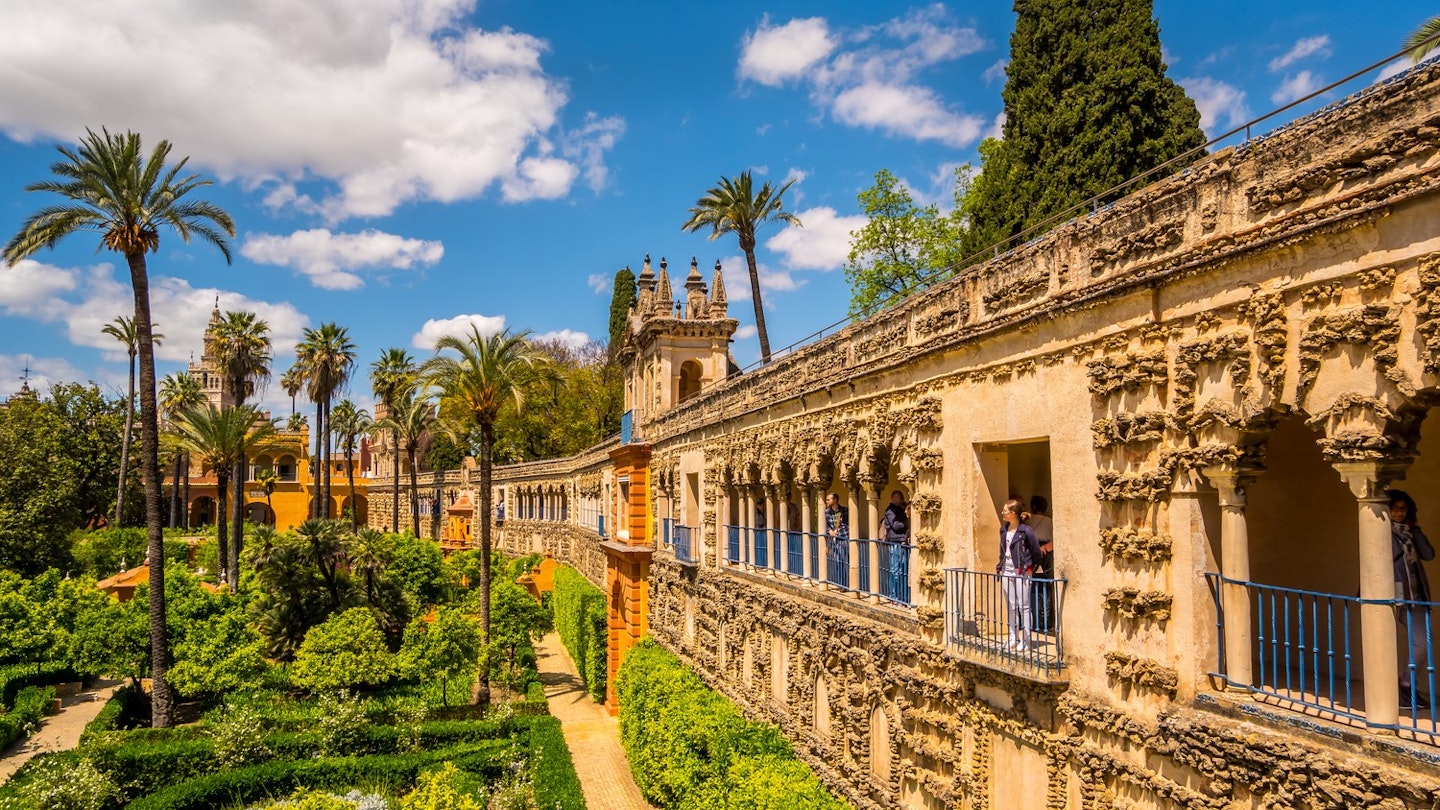
Experience Seville with this guide to the city's best things to do © David Ridley / Shutterstock
Many civilizations have left their mark on Seville .
The capital of Andalucía is proud, beautiful and packed full of culture. It wears its heritage with pride, and the sensual blend of Islamic, Gothic and Renaissance architecture is on magnificent display in the royal palace and mighty cathedral.
Beyond the elaborate mansions and verdant parks that Seville is most famous for, the city's spirit thrives in countless tapas restaurants in bar-strewn plazas and along the banks of the Guadalquivir river. From soul-stirring flamenco to glorious gastronomy and gregarious neighborhoods , here are our favorite things to do in Seville.
1. Marvel at the Real Alcazár
Remarkably well-preserved, the royal palace is one of Spain's most beautiful buildings and serves as a palimpsest of Sevillian history. Originally built as a fort in the 10th century, subsequent rulers – from the Moors of North Africa to the Spanish Christians six centuries later – left their indelible mark on the palace complex.
Let your imagination run amok beneath intricately carved archways and in staterooms whose geometric tiles have witnessed the scheming of sultans and kings. Don't miss the stunning Patio de las Doncellas, which archaeologists uncovered in 2004, or the subterranean baths of Doña María de Padilla. The sensual, foliage-filled gardens look prettiest in the soft light of the late afternoon – keep an eye out for a glimpse of peacock feathers.
Planning tip: Long entry queues are standard here. To cut waiting time, buy tickets online in advance.

2. Tour the rooftop of the largest Gothic cathedral in the world...
The Catedral de Santa María de la Sede is a staggering affair that melds Gothic, Renaissance and Moorish architecture. In true Sevillian style, Spanish Christians transformed the city's 12th-century mosque into a cathedral between the 15th and 16th centuries. These layers of history are best viewed on a rooftop tour, where you can get up close with startling gargoyles and intricate stained glass windows, and even see the sculptors' initials etched into the stonework.
If you can bear the crowds of tourists traipsing through it, make time for the cathedral's cavernous interior, home to Christopher Colombus' tomb and several valuable works of art. Ogle Francisco de Goya's haunting painting Santas Justa y Rufina , the martyrs who are the city's patron saints, before stepping out into the peaceful Patio de los Naranjos, an inner courtyard named after the 66 orange trees within.
3. ...and then climb the Giralda for unbeatable views of Seville
An icon of Seville's elegant skyline, the Giralda – the bell tower of the cathedral – gleams golden against the blue sky that stretches above Andalucía nearly all year round . The scalloped archways and Islamic ornament found on the lower section belies the Giralda's origins; it was formerly the minaret of the 12th-century mosque.
Planning tip: Climb the 35 ramps and flight of stairs during the morning while it is cool. It's worth the effort; at the top lie 24 mighty bells and panoramic views of Seville, with the hazy outline of the Sierra Norte mountains in the distance.
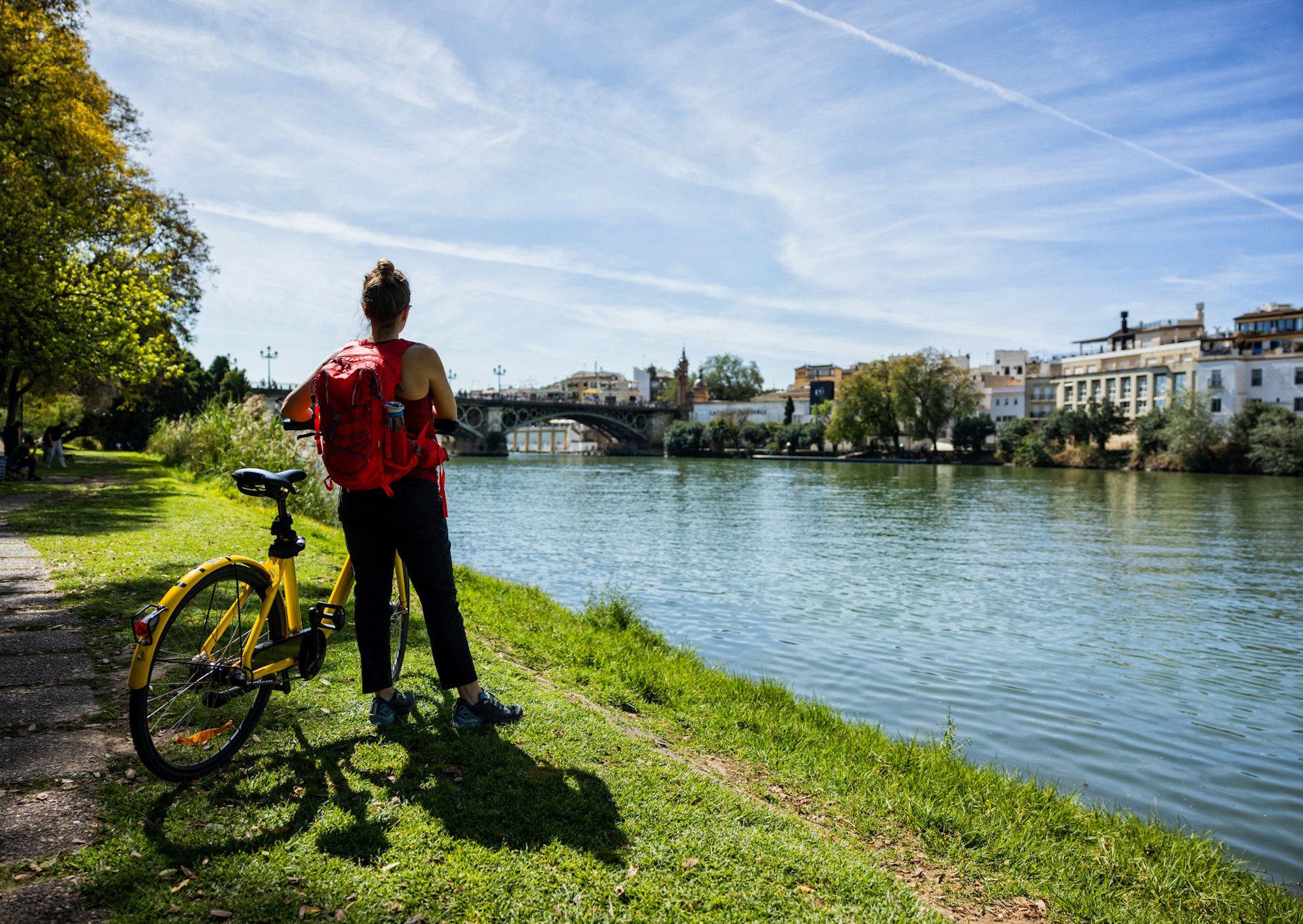
4. Hire a bike and cycle around Seville
Flat and sunny Seville is one of Spain's most cycle-friendly cities. Grab a pay-as-you-go bicycle, Servici , and head off along 180km (111 miles) of smooth, interconnected bike lanes. Set out from the old Jewish district of Santa Cruz, a labyrinth of cobbled streets and squares shaded by orange trees, then head north towards the La Macarena neighborhood. En route, you'll pass the ochre-and-white Basílica de La Macarena and the soaring arches of the Palacio do los Marqueses de la Algaba , a restored Mudéjar palace that doubles as a cultural center.
After refueling on café con leche , pedal south past the two-millennia-old Roman columns on Alameda de Hércules square and over the river into Triana. The heart of Seville's old ceramics industry is less picturesque than Seville's other neighborhoods but still worth a visit. It is lined with popular cafes, and eye-catching tiles adorn shop fronts, though not much happens here during siesta hours.
5. Clap along to an entrancing flamenco show
Raw, passionate and utterly hypnotic, flamenco in Seville is rooted in Triana. This typically working-class neighborhood was originally home to the Roma community, people who migrated from eastern Europe in the 15th and 16th centuries. Intimate flamenco shows at night are the most powerful; let the frenzy of stamping feet and quavering voices transport you in Triana's CasaLa Teatro .
Close to the cathedral, shows in La Casa del Flamenco unfold between Mudéjar arches or for something simpler, try the tiny La Casa de la Guitarra . With its low-slung ceilings, wooden beams and program of top-quality artists, atmospheric El Arenal hosts one of the best tablaos of flamenco in the city. For more of a casual setting, try Lola de los Reyes , an authentically Sevillian bar whose elegant proprietor frequently joins in. You will need to spend around €10 on copas .
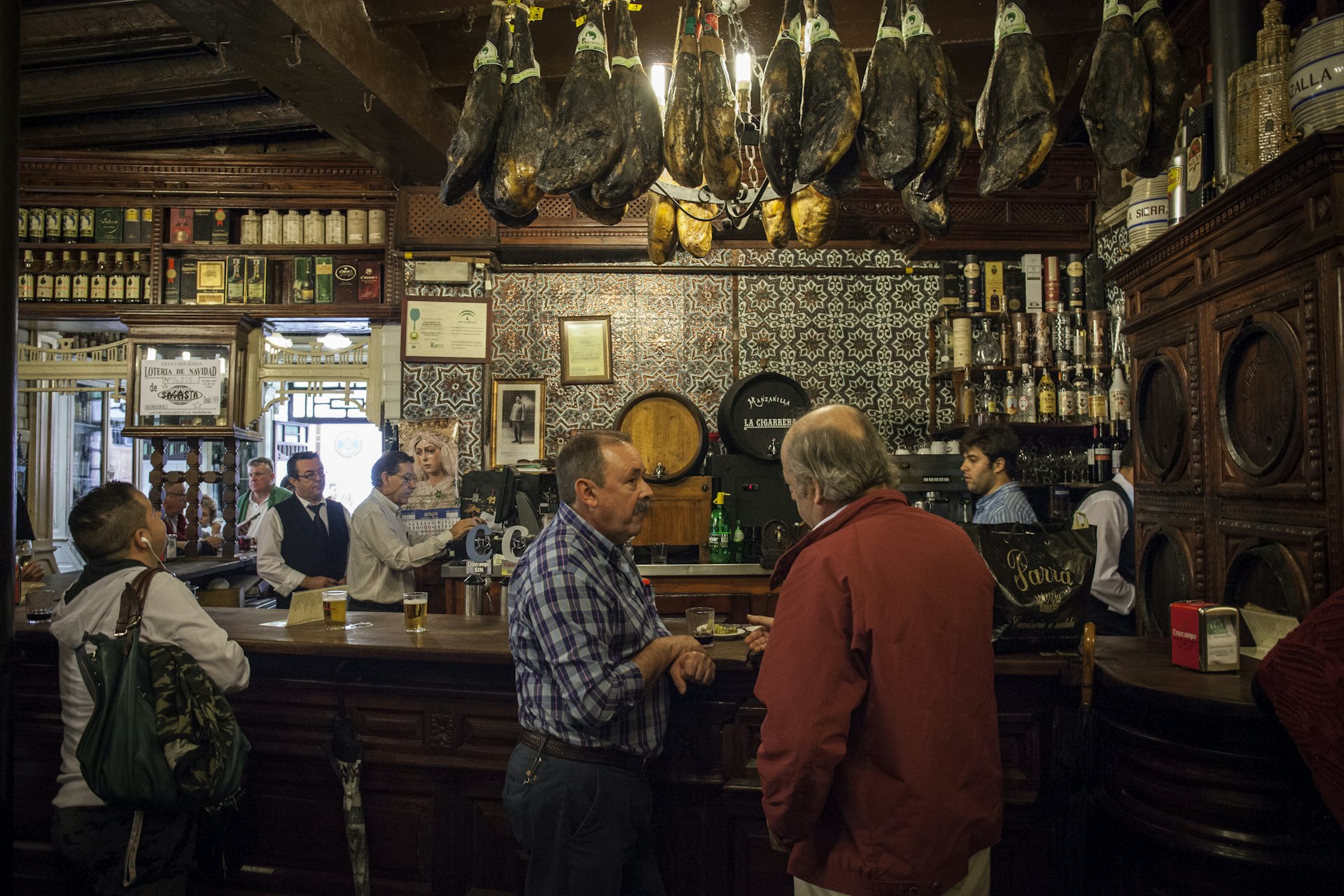
6. Feast on tapas in Seville's best restaurants
Seville is truly the epicenter of tapas – the small plates that have become one of Spain's most prolific exports. More than 3000 tapas bars hide along Seville's side streets. Some are traditional affairs of wood and tiles in an old bar; others are swankier fusion joints.
Feast on Andalucían classics such as pescaítos frito s (deep-fried fish) or artichokes with jamón at Casa Morales . Stand with the locals at the back of this bustling bodega , a jarra of local brew Cruzcampo in hand. Just around the corner, haunches of ham swing from the ceiling of Cafe Bar Las Teresas , a friendly tapas bar packed with loyal customers.
If you should tire of the platters piled high with fried slivers of berejenas (aubergines) and casseroles of chickpeas and spinach, then make your way to La Brunilda , an unassuming whitewashed building where inventive cuisine is beautifully served. Locals may squabble over who serves the best acorn-fed jamón ibericó bellota in Seville, but everyone agrees that the wafer-thin slices of the cured, salty meat are delectable at Casa Román , a 19th-century institution on the Plaza Venerables. Pencil in time for a siesta after lunch.
7. Paddleboard along the Guadalquivir River
When Ferdinand Magellan set out to circumnavigate the globe for the first time in 1519, he struck out from the Guadalquivir River. The blue ribbon that slices twice through Seville was essential to the riches of the Spanish Empire, built up over centuries of maritime trading.
For a slightly more unusual view of the city, take a leisurely paddle down the river with a slight breeze in your hair. Glide beneath the decorative bridges that connect Seville's two banks – Puente de Isabel II is the oldest – and past prettily-painted apartments that stand proudly at the water's edge.
Planning tip: The helpful guides at Paddle Surf Sevilla give tours of the city's history as you float along. It is surprisingly social on the river; time it right, and you may cross paths with Seville's devoted flotilla of rowers and kayakers.
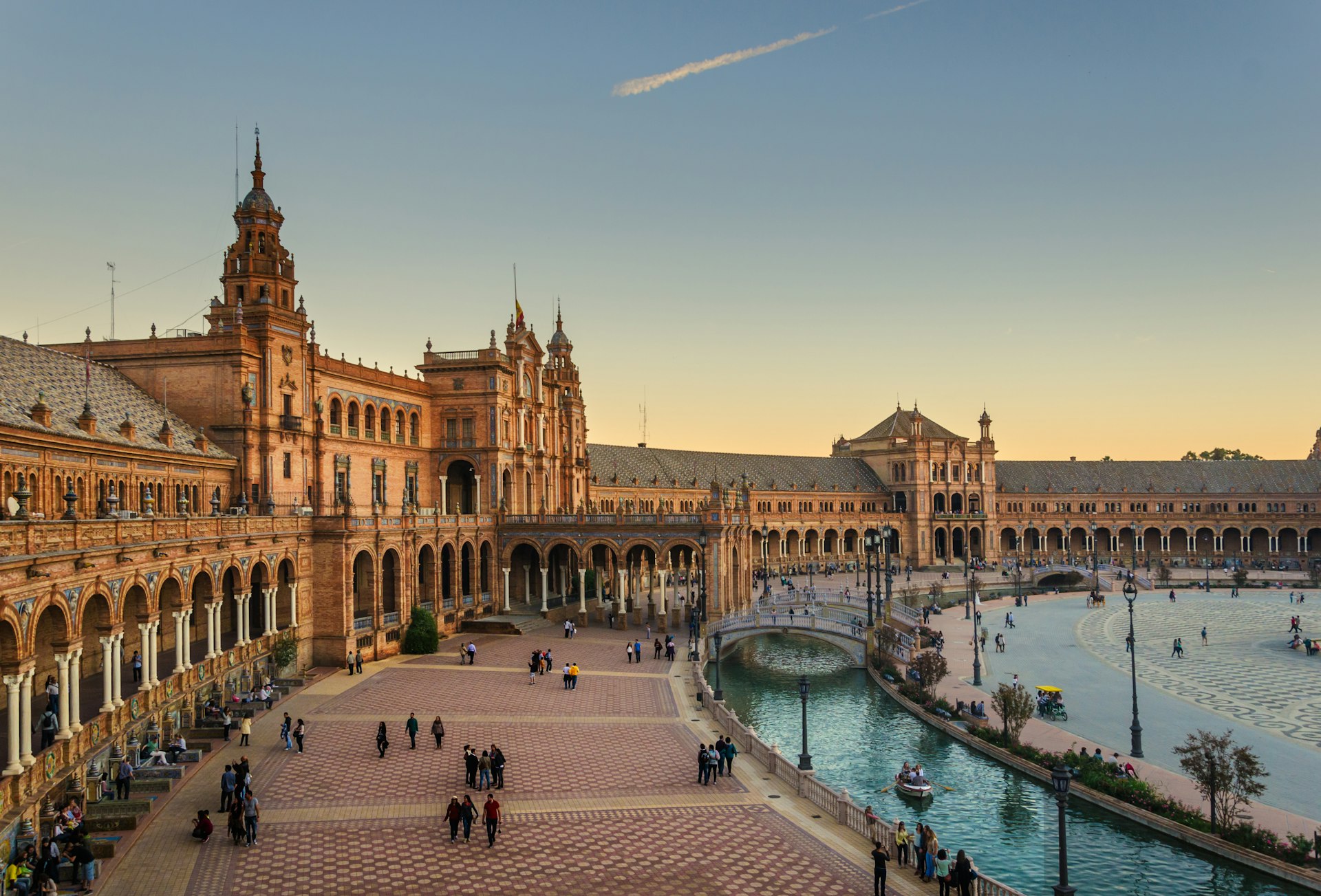
8. Learn about Spanish history at Plaza de España
Glorious and sun-drenched, this grand monument to Spain's historic towns and cities is crammed full of the azulejo tiles that Seville is famous for. An ambitious commission for the 1929 Exposición Iberoamericana, it took local architect Aníbal González 15 years to complete the Plaza de España . Each of the four bridges over the crescent-shaped canal represents the old kingdom of Spain: Castile, León, Navarre and Aragón. Between snapping pictures, brush up on your Spanish history; tiled murals in each alcove tell the story of Spain's provinces.
Planning tip: Visit during the quiet of siesta while the rest of the city naps.
9. Sample sherry from Andalucía's best wineries
In Seville, sherry is not a dusty bottle at the back of the drinks cabinet. The city sits just north of southern Spain's "sherry triangle," meaning bars throughout the city stock superb wines from artisan producers. Forget the sickly sweet tipple that gets rolled out at Christmas; these drinks are dry, delicate and quaffable. The paler-colored Manzanilla, Fino and Amontillado styles are tangy and aromatic. Fuller-bodied Oloroso varieties taste great with meat dishes.
Mixologists shake bold, sherry-based concoctions at late-night spot Premier Sherry Cocktail Bar in the old town. With more than 60 sherries to choose from at Palo Cortao , this swish tapas bar tucked down a tiny side street is where to linger over a glass, or three.
Planning tip: Pick up a bottle to take home at Flores Gourmet , a specialty abacería (shop) that sells only local produce.
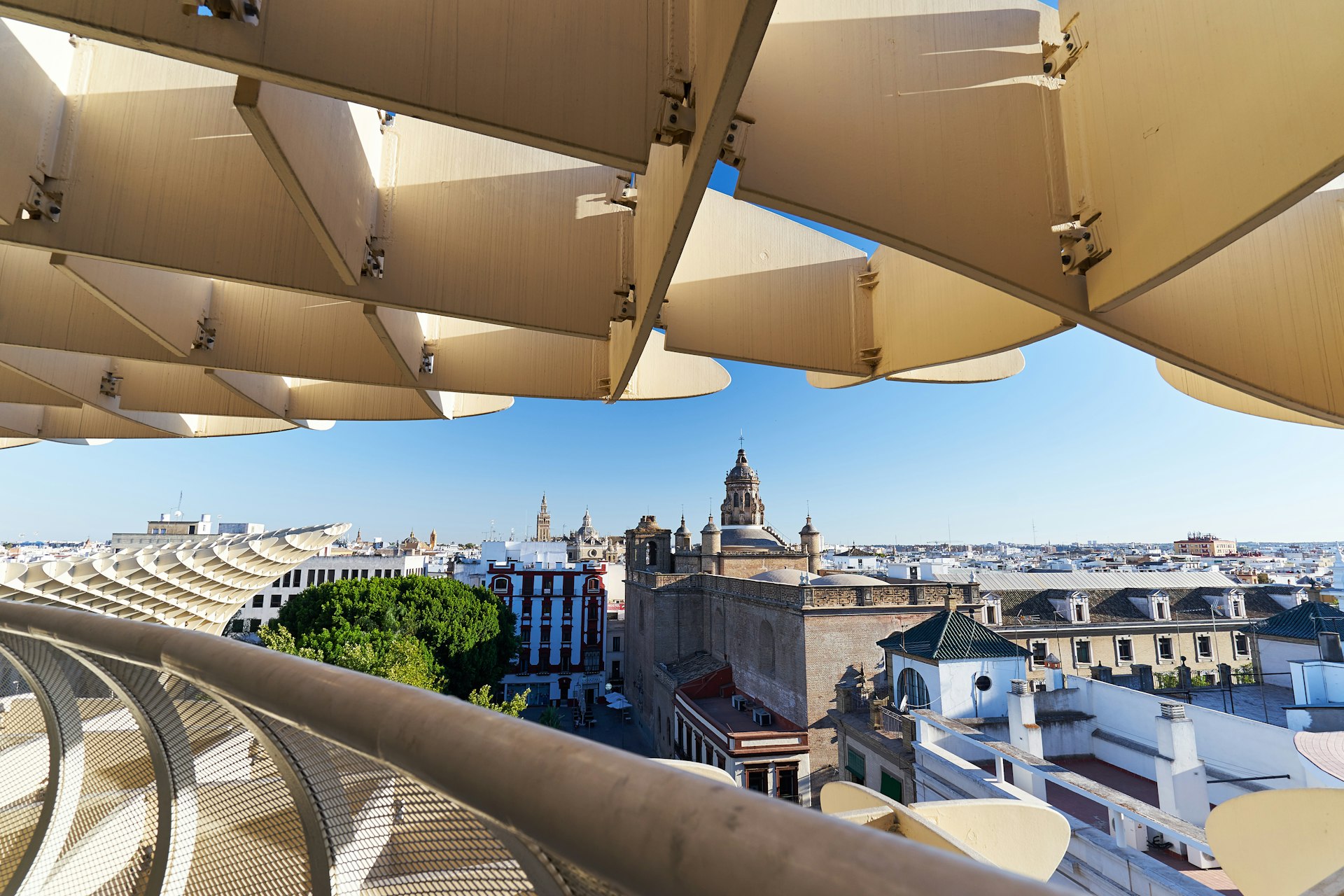
10. Ascend the Metropol Parasol
Las Setas (mushrooms), as the Metropol Parasol is locally known, acts as a contemporary counterbalance to Seville's centuries-old architecture. There are no Gothic archways here; instead, a showy, modernist structure built entirely from wood – one of the largest in the world – sits atop a Roman and Moorish archaeological site.
Planning tip: Meander through the vast cuboid structure via rooftop walkways at sunset, when the futuristic timber lattice is lit up, before settling down to sip a caña in the Plaza de la Encarnación, a buzzy former market square.
11. Cool down in Seville's parks
When the temperatures soar, seek shade in any of Seville's nine green spaces. The Parque de Maria Luisa is a spectacular spot for a Sunday stroll. A small pavilion overlooks the aqua lagoon, and the sound of horse hooves rings out between the secluded walkways dripping with flowers. Ancient trees and colorful blooms dominate the Murillo gardens, tucked behind the Alcázar.
12. Enjoy a tipple at a majestic hotel
With its tiled turrets and towering palm trees, it is easy to mistake the Hotel Alfonso XIII for the royal palace. In fact, the eponymous king demanded that the hotel be built to welcome presidents and distinguished guests during the world's fair that bequeathed Seville with so many monuments. The grandeur remains to this day.
Planning tip: Quench your thirst with mint tea or something stronger inside the exquisitely decorated inner courtyard – a homage to Andalucían crafts and timeless elegance. The rest of the hotel is equally decadent.
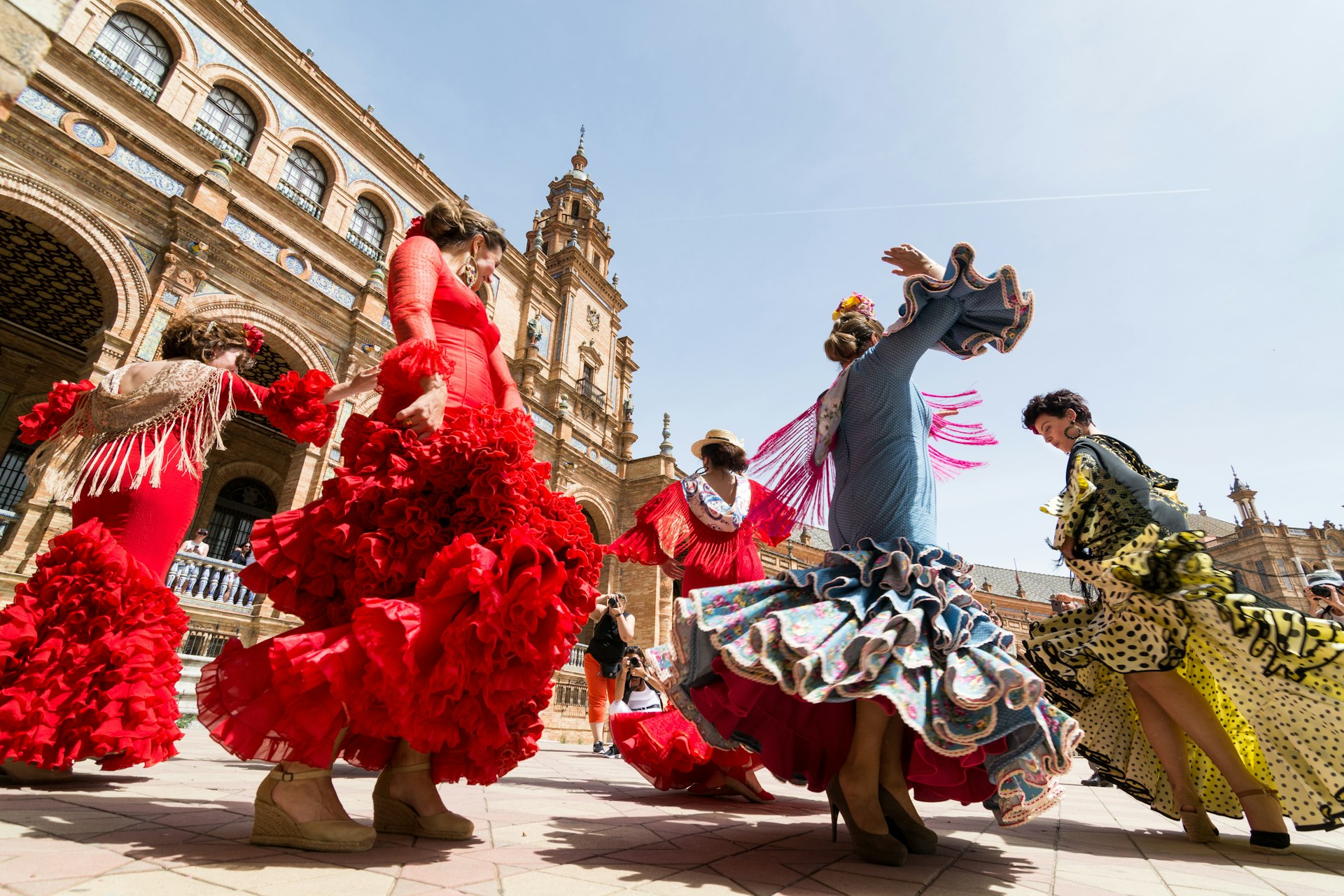
13. Time your visit to coincide with a festival of Sevillian culture
Accommodation costs will hike up during Seville's annual Feria de Abril, though the ebullient, sherry-fuelled week is still worth dipping into. The festival is one of Andalucía's most important, and Sevillanas stroll the calles (streets) in traditional dress or mounted on horseback.
In July, the revelry returns to Triana for its own 400-year-old festival. During festivals, much of the entertainment takes place outdoors, free of charge. Visit Seville during the biennial of flamenco to witness the frenzied art form at its spine-tingling best. This is when the streets come alive with maestros and baillarinas stamping their feet and whirling shawls as mournful seguiriyas fill the air.
14. Unwind in the Arab baths
After the glare of Seville's sunny squares, the candle-lit depths of the Arab baths offer instant respite. Like much of the city's architecture, the act of communal bathing harks back 700 or so years to when Seville was the seat of Moorish power. Then Muslims would cleanse by moving through a series of marble pools before seeking purification of the spiritual sort in a nearby mosque.
Today, the experience is less authentic but no less pleasurable. The ritual of steam, scrub and soak is heavenly at Aire Baños Árabes – spa baths housed inside a grand 16th-century Mudéjar palace. After floating through the thermal circuit beneath cavernous ceilings bedecked with bronze lanterns, head up to the roof terrace for a view over the medieval cathedral and bell tower.
Planning tip: This is one of Seville's most romantic activities; reserve a slot at dusk before a late-night meal.
15. Revel in Spanish Golden Age art
The Museo de Bellas Artes , situated in a former convent, crams in work by Spain's most notable painters – who also happen to be Sevillian: Diego Velázquez, a bronze statue of whom also gazes out over the Plaza del Duque; and Bartolomé Esteban Murillo, a baroque artist whose gentle, religious scenes also adorn the chapel of the striking Hospital de la Caridad . Sala (room) V, a former church, is a fitting place for Murillo's The Immaculate Conception . Raised on high beneath the gold-flecked cupola, the radiant painting of the Virgin Mary adds a touch of the divine.
16. Admire the tiles in Casa de Pilatos
The Casa de Pilatos was the formal residence of the aristocratic Medinaceli family, and some find this petite palace even more splendid than the Alcázar. Inside, stuccoed arches frame a graceful patio, and geometric patterns run wild over the tiled, 16th-century walls. Perfectly pruned Sevillian orange trees stand to attention over another courtyard and on the ground floor; the soft tinkling of a fountain is always audible. Spot busts of Roman emperors and Greek heroes throughout the Mudéjar mansion – a nod to the Italian Renaissance.
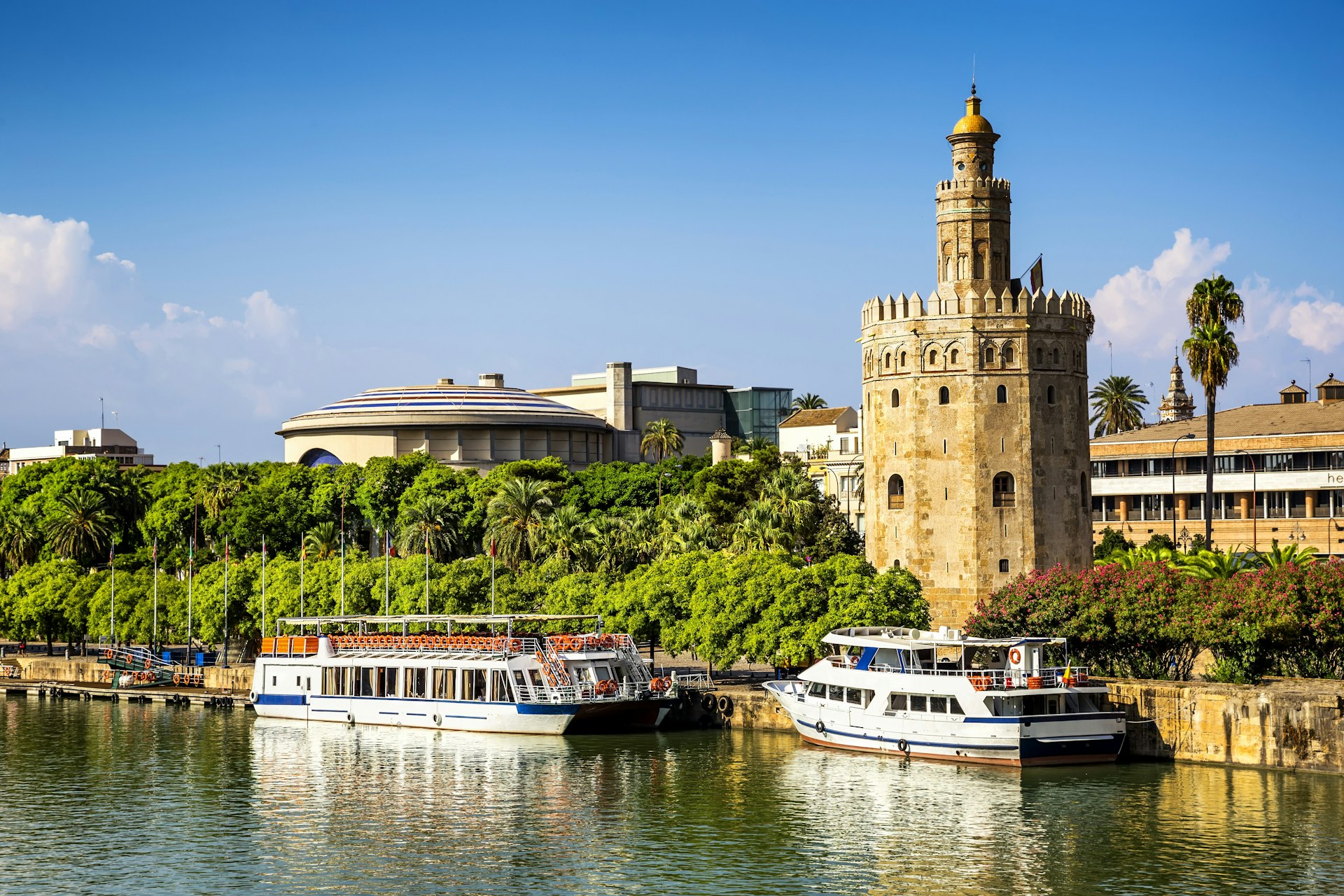
17. Play at the beach, then take a riverside stroll
Life around the Guadalquivir River is more placid now than when this was the major artery of trade for the Spanish Empire. Ponder the river that earned the Catholic Monarchs of Spain their war chest from the artificial sandy beach at Muelle de las Delicias, complete with volleyball nets and sun loungers, then stroll north along the bank, past the imposing Torre del Oro watchtower to the old fish market for a drink. The smartly-restored Mercado Lonja del Barranco is a magnet for foodies.
18. Meander around Triana
It's hard not to imagine the former inhabitants of this bohemian barrio: the Roma gypsy community, religious deviants and the sailors who joined Christopher Columbus on his voyage to the Americas.
Inside the Centro Cerámica Triana , gaze at the azulejo tiles which served as the neighborhood's lifeblood until the mid-1960s, then walk a few miles along the ruta de la cerámica . Head north from the Punta de Isabel II bridge, past the blue and yellow dome of the Capilla Virgen del Carmen and along the Calle Castilla, before looping back down Calle Alfarería towards Plaza del Altozano. Peep through the gateway of the flower-filled Casa de las Flores, one of the few attractive surviving multi-family workers' houses in Seville, then stop at Cerámica Santa Ana to pick up gifts. Finish up at any of Triana's lively bars for a night on the tiles.
19. Discover Seville's Roman history
Centuries before Seville became the capital of Muslim Spain, the Romans ruled the city here called Hispalis. Evidence of the 2000-year-old town sits in the Calle Mármoles, where three of six towering granite columns, most likely the remains of a temple, stand frozen in time as nature grows around them. A pair were moved to the Alameda de Hércules square in the 16th century; the other was broken in transit.
Planning tip: The Roman mosaics in the courtyard of the resplendent Palacio de la Condesa de Lebrija have fared better. Explore the palace house's remarkable collection of Roman artifacts for free on Fridays at 10am.
20. Tour Spain’s most important bullring
Though many people fundamentally disagree with blood sports for reasons of animal cruelty, bullfighting is woven deeply into the fabric of Andalucía, as any Sevillano will tell you. This quintessentially Spanish tradition is protected by the EU. If you'd like to learn more, take a guided tour around La Maestranza . A small exhibition explains the history of the plaza del toros (bullring) and how the heart-stopping la fiesta brava works.
Planning tip: Entry is free from 5:30 to 7:30pm on Wednesdays.
This article was first published March 2022 and updated January 2024
Explore related stories
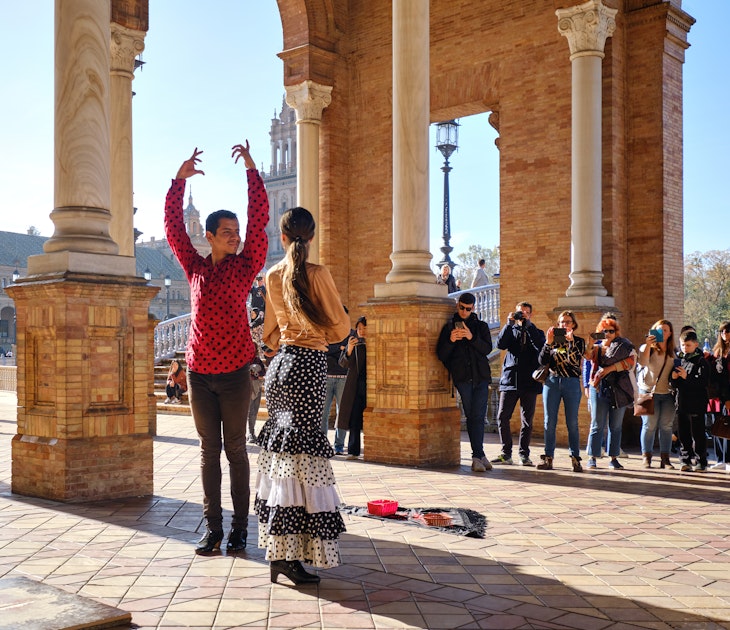
Mar 9, 2024 • 5 min read
Seville is one of the most beautiful cities in Spain, but the seasons will impact the type of trip you'll have. Read on for the best times to visit.

Feb 28, 2024 • 3 min read

Nov 1, 2023 • 15 min read
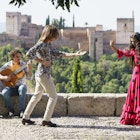
Aug 22, 2023 • 7 min read

Jul 21, 2022 • 9 min read
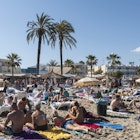
Jun 24, 2022 • 6 min read

Apr 7, 2022 • 6 min read

Mar 22, 2022 • 5 min read
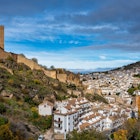
Apr 19, 2021 • 7 min read

Sep 27, 2019 • 6 min read

Enjoy fast, free delivery, exclusive deals, and award-winning movies & TV shows with Prime Try Prime and start saving today with fast, free delivery
Amazon Prime includes:
Fast, FREE Delivery is available to Prime members. To join, select "Try Amazon Prime and start saving today with Fast, FREE Delivery" below the Add to Cart button.
- Cardmembers earn 5% Back at Amazon.com with a Prime Credit Card.
- Unlimited Free Two-Day Delivery
- Streaming of thousands of movies and TV shows with limited ads on Prime Video.
- A Kindle book to borrow for free each month - with no due dates
- Listen to over 2 million songs and hundreds of playlists
- Unlimited photo storage with anywhere access
Important: Your credit card will NOT be charged when you start your free trial or if you cancel during the trial period. If you're happy with Amazon Prime, do nothing. At the end of the free trial, your membership will automatically upgrade to a monthly membership.
Buy new: $15.99
Return this item for free.
Free returns are available for the shipping address you chose. You can return the item for any reason in new and unused condition: no shipping charges
- Go to your orders and start the return
- Select the return method

Download the free Kindle app and start reading Kindle books instantly on your smartphone, tablet, or computer - no Kindle device required .
Read instantly on your browser with Kindle for Web.
Using your mobile phone camera - scan the code below and download the Kindle app.

Image Unavailable

- To view this video download Flash Player

Follow the author

Pocket Rough Guide Seville: Travel Guide with Free eBook Paperback – April 2, 2024
Purchase options and add-ons.
This compact, pocket-sized Seville travel guidebook is ideal for travellers on shorter trips and those trying to make the most of Seville. It’s light, easily portable and comes equipped with a pull-out map. This Seville guidebook covers: Barrio Santa Cruz, Barrio Alfalfa, Arenal and the Río Guadalquivir, El Centro, Sur, Barrio Triana, Barrio Macarena, La Alameda de Hércules, Los Remedios. Inside this Seville travel book you will find:
- Curated recommendations of places – main attractions, off-the-beaten-track adventures, child-friendly family activities, chilled-out breaks in popular tourist areas
- Things not to miss in Seville – Alcázar, Flamenco, Giralda tower, Catedral, Barrio Santa Cruz, Feria de Abril, Tapas, Triana, Semana Santa, Parque de María Luisa, Museo Arqueológico and Museo de Costumbres Populares, Las Setas, Museo de Bellas Artes, Itálica, Monasterio San Isidoro del Campo
- Ready-made itineraries samples – created for different time frames or types of trip
- Seville at a glance – an overview map of Seville with key areas and short descriptions of what you’ll find there
- Day trips – extra information for those on longer breaks or wanting to venture further afield
- Practical travel tips – information on how to get there and around, health guidance, tourist information, festivals and events, plus an A–Z directory
- Handy language section – themed basic vocabulary for greetings, numbers and food and drink
- Independent reviews – honest descriptions of places to eat, drink or stay, written by our expert authors
- Accommodation – handy reference guide to a range of hotels for different budgets
- Pull-out map – easy to extract folded map with places to see marked
- What’s new – a short overview of the changes in Seville in recent years for repeat travellers
- Free download of the eBook – available after purchase of the printed Seville guidebook
- Fully updated post-COVID-19
The guide is a perfect companion both ahead of your trip and on the ground. It gives you a distinct taste of Seville with a concise edit of all the information you’ll need.
- Print length 144 pages
- Language English
- Publisher Rough Guides
- Publication date April 2, 2024
- Dimensions 3.8 x 0.5 x 7.4 inches
- ISBN-10 183905980X
- ISBN-13 978-1839059803
- See all details

Frequently bought together

Similar items that may deliver to you quickly

Editorial Reviews
About the author, product details.
- Publisher : Rough Guides; 1st edition (April 2, 2024)
- Language : English
- Paperback : 144 pages
- ISBN-10 : 183905980X
- ISBN-13 : 978-1839059803
- Item Weight : 6.4 ounces
- Dimensions : 3.8 x 0.5 x 7.4 inches
- #5 in Seville Travel Guides
- #166 in General Spain Travel Guides
- #705 in Tourist Destinations & Museums Guides
About the author
Rough guides.
Escape the everyday with Rough Guides.
Rough Guides is a leading travel publisher known for its “tell it like it is” attitude, accurate, up-to-date content and authoritative contemporary writing. We publish books covering more than 120 destinations around the globe, producing an ever-growing series of ebooks and a range of reference titles, with an award-winning website.
Since 1982, our books have helped over 35 million travellers explore the world with accurate, honest and informed travel writing.
---------------------------------------
• INSPIRATIONAL GUIDES
Stylish picture-packed inspirational books that make great gifts.
• ROUGH GUIDES
Classic in-depth 'Tell it like it is' guidebooks covering cities, regions and countries.
• ON A BUDGET
Guidebook bibles for budget-conscious travellers.
• FIRST TIME
Everything you need to know before you go.
• POCKET GUIDES
Compact practical guidebooks for short-trip travellers.
• WALKING GUIDES
Compact practical guidebooks tailored to trekkers and walkers.
• PHRASEBOOKS
User-friendly, pocket-sized phrasebooks.
Now we offer a personalised trips of a lifetime with unique adventure
Find your own path with Rough Guides tailor-made trip - roughguides.com
Customer reviews
Customer Reviews, including Product Star Ratings help customers to learn more about the product and decide whether it is the right product for them.
To calculate the overall star rating and percentage breakdown by star, we don’t use a simple average. Instead, our system considers things like how recent a review is and if the reviewer bought the item on Amazon. It also analyzed reviews to verify trustworthiness.
- Sort reviews by Top reviews Most recent Top reviews
Top reviews from the United States
Top reviews from other countries.
- Amazon Newsletter
- About Amazon
- Accessibility
- Sustainability
- Press Center
- Investor Relations
- Amazon Devices
- Amazon Science
- Sell on Amazon
- Sell apps on Amazon
- Supply to Amazon
- Protect & Build Your Brand
- Become an Affiliate
- Become a Delivery Driver
- Start a Package Delivery Business
- Advertise Your Products
- Self-Publish with Us
- Become an Amazon Hub Partner
- › See More Ways to Make Money
- Amazon Visa
- Amazon Store Card
- Amazon Secured Card
- Amazon Business Card
- Shop with Points
- Credit Card Marketplace
- Reload Your Balance
- Amazon Currency Converter
- Your Account
- Your Orders
- Shipping Rates & Policies
- Amazon Prime
- Returns & Replacements
- Manage Your Content and Devices
- Recalls and Product Safety Alerts
- Conditions of Use
- Privacy Notice
- Consumer Health Data Privacy Disclosure
- Your Ads Privacy Choices
Book your individual trip , stress-free with local travel experts
- roughguides.com
- seville-sevilla
- Travel guide
- Itineraries
- Local Experts
- Travel Advice
- Accommodation
Plan your tailor-made trip with a local expert
Book securely with money-back guarantee
Travel stress-free with local assistance and 24/7 support
Maureen C, USA
The hotels were fabulous and we were greeted and treated with care. The itinerary proved outstanding. The drivers were wonderful. He was always on time, ma...
“Seville,” wrote Byron, “is a pleasant city, famous for oranges and women.” And for its heat, he might perhaps have added, since Seville’s summers are intense and start early, in May. Seville (Sevilla) has three important monuments and an illustrious history, but what it’s essentially famous for is its own living self – the greatest city of the Spanish south, of Carmen, Don Juan and Figaro, and the archetype of Andalucian promise. This reputation for gaiety and brilliance, for theatricality and intensity of life does seem deserved. It’s expressed on a phenomenally grand scale at the city’s two great festivals – Semana Santa (Holy Week at Easter) and the Feria de Abril (which starts two weeks after Easter Sunday and lasts a week). Either is worth considerable effort to get to. Seville is also Spain’s second most important centre for bullfighting, after Madrid.
The Catedral
Moorish seville, the alcázar.
Despite its elegance and charm, and its wealth, based on food processing, shipbuilding, aircraft construction and a thriving tourist industry, Seville lies at the centre of a depressed agricultural area and has an unemployment rate of nearly twenty percent – one of the highest in Spain. The total refurbishment of the infrastructure boosted by the 1992 Expo – including impressive new roads, seven bridges, a high-speed rail link and a revamped airport – was intended to regenerate the city’s (and the region’s) economic fortunes, but has hardly turned out to be the catalyst for growth and prosperity promised at the time. Indeed, some of the colossal debts are still unpaid two decades later.
Seville’s old city – where you’ll want to spend most of your time – is sited along the east bank of the Guadalquivir. At its heart, side by side, stand the three great monuments: the Giralda tower, the Catedral and the Alcázar, with the cramped alleyways of the Barrio Santa Cruz, the medieval Jewish quarter and now the heart of tourist life, extending east of them.
North of here is the main shopping and commercial district, its most obvious landmarks Plaza Nueva, Plaza Duque de la Victoria and the smart, pedestrianized c/Sierpes, which runs roughly between them. From La Campana, the small square at the northern end of c/Sierpes, c/Alfonso XII runs down towards the river by way of the Museo de Bellas Artes, second in importance in Spain only to the Prado in Madrid. Across the river is the earthier, traditionally working-class district of Triana, flanked to the south by the Los Remedios
barrio, the city’s wealthier residential zone where the great April feria takes place.
Book tickets and tours for Seville
Tailor-made travel itineraries for Spain, created by local experts

9 days / from 2445 USD
Andalucía Explored
Discover the best of Andalucía's breathtaking palaces, churches, museums, vineyards, and more, as you travel through spectacular scenery dotted with pueblos blancos and bordered by rugged mountains and coast en route to Granada, Seville, Ronda and Jerez de la Frontera.

4 days / from 637 USD
A culinary experience in Seville
Explore the cuisine and surroundings of Seville in Andalucia. From Iberian ham over sherry wines to the production and secrets of olive oil, this tour is an ideal weekend getaway. Decide yourself if you prefer a rental car or a chauffeur-driven car to explore the beauty of Andalucia.

10 days / from 3756 USD
Spanish Honeymoon
Discover Andalusia, starting with the cultural city of Seville, then on to Córdoba and Granada, home of the stunning Alhambra Palace. Next you'll visit Granada and the Albayzin Arab quarter, then enjoy a stunning hot-air balloon ride, before ending your trip with a luxury boat trip from Marbella!
Seville’s Catedral was conceived in 1402 as an unrivalled monument to Christian glory – “a building on so magnificent a scale that posterity will believe we were mad”. To make way for this new monument, the Almohad mosque that stood on the proposed site was almost entirely demolished. Meanwhile, the canons, inspired by their vision of future repute, renounced all but a subsistence level of their incomes to further the building.
The cathedral was completed in just over a century (1402–1506), an extraordinary achievement, as it’s the largest Gothic church in the world. As Norman Lewis says, “It expresses conquest and domination in architectural terms of sheer mass.” Though it is built upon the huge, rectangular base-plan of the old mosque, the Christian architects (probably under the direction of the French master architect of Rouen cathedral) added the extra dimension of height. Its central nave rises to 42m, and even the side chapels seem tall enough to contain an ordinary church. The total area covers 11,520 square metres, and new calculations, based on cubic measurement, have now pushed it in front of St Paul’s in London and St Peter’s in Rome as the largest church in the world, a claim upheld by the Guinness Book of Records, a copy of whose certificate is proudly displayed in the church.
Book tickets and tours for Seville's' Cathedral
The monument to Christopher Columbus
Entry to the cathedral is via the Puerta de San Cristóbal on the building’s south side; you are guided through a reception area and bookshop that brings you into the church to the west of the portal itself. Turn right once inside to head east, where you will soon be confronted by the Tomb of Christopher Columbus (Cristóbal Colón in Spanish). Columbus’ remains were originally interred in the cathedral of Havana, on the island that he had discovered on his first voyage in 1492. But during the upheavals surrounding the declaration of Cuban independence in 1902, Spain transferred the remains to Seville, and the monumental tomb – in the late Romantic style by Arturo Mélida – was created to house them. However, doubts have always been voiced concerning the authenticity of the remains, and in 2002 scientists from the University of Granada carried out DNA tests in an attempt to confirm that they are those of Columbus – but these proved inconclusive. The mariner’s coffin is held aloft by four huge allegorical figures, representing the kingdoms of León, Castile, Aragón and Navarra; the lance of León should be piercing a pomegranate (now inexplicably missing), symbol of Granada (and the word for the fruit in Spanish), the last Moorish kingdom to be reconquered.
As you move into the nave, sheer size and grandeur are, inevitably, the chief characteristics of the cathedral. But once you’ve grown accustomed to the gloom, two other qualities stand out with equal force: the rhythmic balance and interplay between the parts, and an impressive overall simplicity and restraint in decoration. All successive ages have left monuments of their own wealth and style, but these have been limited to the two rows of side chapels. In the main body of the cathedral only the great box-like structure of the coro stands out, filling the central portion of the nave.
The Capilla Mayor
The coro extends and opens onto the Capilla Mayor, dominated by a vast Gothic retablo composed of 45 carved scenes from the Life of Christ. The lifetime’s work of a single craftsman, Fleming Pieter Dancart, this is the supreme masterpiece of the cathedral – the largest and richest altarpiece in the world and one of the finest examples of Gothic wood carving. The guides provide staggering statistics on the amount of gold involved.
The Sacristía de los Cálices
Before proceeding around the edge of the nave in a clockwise direction it’s best to backtrack to the church’s southeast corner to take in the Sacristía de los Cálices where many of the cathedral’s main art treasures are displayed, including a masterly image of Santas Justa y Rufina by Goya, depicting Seville’s patron saints, who were executed by the Romans in 287. Should you be interested in studying the many canvases here or the abundance of major artworks placed in the various chapels, it’s worth calling at the bookshop near the entrance to purchase a copy of the official Guide to the Cathedral of Seville, which deals with them in detail.
The Sacristía Mayor
Alongside this room is the grandiose Sacristía Mayor, housing the treasury. Embellished in the Plateresque style, it was designed in 1528 by Diego de Riaño, one of the foremost exponents of this predominantly decorative architecture of the late Spanish Renaissance. Amid a confused collection of silver reliquaries and monstrances – dull and prodigious wealth – are displayed the keys presented to Fernando by the Jewish and Moorish communities on the surrender of the city; sculpted into the metal in stylized Arabic script are the words “May Allah render eternal the dominion of Islam in this city”. Through a small antechamber here you enter the oval-shaped Sala Capitular (chapterhouse), with paintings by Murillo and an outstanding marble floor with geometric design.
Puerta del Nacimiento
Continuing to the southwest corner and the Puerta del Nacimiento – the door through which pass all the pasos and penitents who take part in the Semana Santa processions – you then turn right (north) along the west wall, passing the Puerta Principal.
The Capilla de San Antonio
In the northwest corner, the Capilla de San Antonio has Murillo’s Vision of St Anthony depicting the saint in ecstatic pose before an infant Christ. A magnificent work: try to spot where the restorers joined San Antonio back into place after he had been crudely hacked out of the picture by thieves in the nineteenth century. He was eventually discovered in New York – where art dealers recognized the work they were being asked to buy – and returned to the cathedral. The Baptism of Jesus above this is another fine work by the same artist.
The Capilla Real
The nave’s north side leads to the Puerta de la Concepción, through which you will exit – but before doing so, continue to the northeast corner to view the domed Renaissance Capilla Real, built on the site of the original royal burial chapel and containing the body of Fernando III (El Santo) in a suitably rich, silver shrine in front of the altar. The large tombs on either side of the chapel are those of Fernando’s wife, Beatrice of Swabia, and his son, Alfonso the Wise. The chapel is reserved for services and private prayer and may only be viewed via the entrance in Plaza Virgen de los Reyes (Mon–Sat 8am–2pm & 4–7pm; free). You are now close to the entry to the Giralda tower.
The entrance to the Giralda lies to the left of the Capilla Real in the cathedral’s northeast corner. Unquestionably the most beautiful building in Seville, the Giralda, named after the sixteenth-century giraldillo, or weather vane, on its summit, dominates the city skyline. From the entrance you can ascend to the bell chamber for a remarkable view of the city – and, equally remarkable, a glimpse of the Gothic details of the cathedral’s buttresses and statuary. But most impressive of all is the tower’s inner construction, a series of 35 gently inclined ramps wide enough to allow two mounted guards to pass.
Book tickets and tours for Giralda
The minaret
The Giralda tower, before it was embellished with Christian additions, was the mosque’s minaret and the artistic pinnacle of Almohad architecture. Such was its fame that it served as a model for other minarets at the imperial capitals of Rabat and Marrakesh. It was used by the Moors both for calling the faithful to prayer (the traditional function of a minaret) and as an observatory, and was so venerated that they wanted to destroy it before the Christian conquest of the city. This they were prevented from doing by the threat of Alfonso (later King Alfonso X) that “if they removed a single stone, they would all be put to the sword”. Instead, it became the bell tower of the Christian cathedral.
The Giralda’s construction
The Moorish structure took twelve years to build (1184–96) and derives its firm, simple beauty from the shadows formed by blocks of brick trelliswork (a style known as sebka), different on each side, and relieved by a succession of arched niches and windows. The original harmony has been somewhat spoiled by the Renaissance-era addition of balconies and, to a still greater extent, by the four diminishing storeys of the belfry – added, along with the Italian-sculpted bronze figure of “Faith” which surmounts them, in 1560–68, following the demolition by an earthquake of the original copper spheres. Even so, it remains in its perfect synthesis of form and decoration one of the most important and beautiful monuments of the Islamic world.
The Patio de los Naranjos
To reach the cathedral’s exit, move east along the nave’s north side to reach the Puerta de la Concepción, passing through this to enter the Patio de los Naranjos. Along with the Giralda tower, this was the only feature to be spared from the original mosque. In Moorish times the mosque would have been entered via the Puerta del Pardon, now the visitor exit. Taking its modern name from the orange trees that now shade the patio, this was the former mosque’s entrance courtyard. Although somewhat marred by Renaissance additions, the patio still incorporates a Moorish fountain where worshippers carried out at ritual ablutions prior to worship. Interestingly, it incorporates a sixth-century font from an earlier Visigothic cathedral, which was in its turn levelled to make way for the mosque.
Seville was one of the earliest Moorish conquests (in 712) and, as part of the Caliphate of Córdoba, became the second city of al-Andalus. When the caliphate broke up in the early eleventh century it was by far the most powerful of the independent states (or taifas) to emerge, extending its power over the Algarve and eventually over Jaén, Murcia and Córdoba itself. This period, under a series of three Arabic rulers from the Abbadid dynasty (1023–91), was something of a golden age. The city’s court was unrivalled in wealth and luxury and was sophisticated, too, developing a strong chivalric element and a flair for poetry – one of the most skilled exponents being the last ruler, al-Mu’tamid, the “poet-king”. But with sophistication came decadence, and in 1091 Abbadid rule was overthrown by a new force, the Almoravids, a tribe of fanatical Berber Muslims from North Africa, to whom the Andalucians had appealed for help against the rising threat from the northern Christian kingdoms.
Despite initial military successes, the Almoravids failed to consolidate their gains in al-Andalus and attempted to rule through military governors from Marrakesh. In the middle of the twelfth century, they were in turn supplanted by a new Berber incursion, the Almohads, who by about 1170 had recaptured virtually all the former territories. Seville had accepted Almohad rule in 1147 and became the capital of this last real empire of the Moors in Spain. Almohad power was sustained until their disastrous defeat in 1212 by the combined Christian armies of the north, at Las Navas de Tolosa. In this brief and precarious period, Seville underwent a renaissance of public building, characterized by a new vigour and fluidity of style. The Almohads rebuilt the Alcázar, enlarged the principal mosque – later demolished to make room for the Christian cathedral – and erected a new and brilliant minaret, a tower over 100m tall, topped with four copper spheres that could be seen for miles around: the Giralda.
Rulers of Seville have occupied the site of the Alcázar from the time of the Romans. Here was built the great court of the Abbadids, which reached a peak of sophistication and exaggerated sensuality under the cruel and ruthless al-Mu’tadid – a ruler who enlarged the palace in order to house a harem of eight hundred women, and who decorated the terraces with flowers planted in the skulls of his decapitated enemies. Later, under the Almohads, the complex was turned into a citadel, forming the heart of the town’s fortifications. Its extent was enormous, stretching to the Torre del Oro on the bank of the Guadalquivir.
Parts of the Almohad walls survive, but the present structure of the palace dates almost entirely from the Christian period. Seville was a favoured residence of the Spanish kings for some four centuries after the Reconquest – most particularly of Pedro the Cruel (Pedro I; 1350–69) who, with his mistress María de Padilla, lived in and ruled from the Alcázar. Pedro embarked upon a complete rebuilding of the palace, employing workmen from Granada and utilizing fragments of earlier Moorish buildings in Seville, Córdoba and Valencia. Pedro’s works form the nucleus of the Alcázar as it is today and, despite numerous restorations necessitated by fires and earth tremors, it offers some of the best surviving examples of Mudéjar architecture – the style developed by Moors working under Christian rule. Later monarchs, however, have left all too many traces and additions. Isabel built a new wing in which to organize expeditions to the Americas and control the new territories; Carlos V married a Portuguese princess in the palace, adding huge apartments for the occasion; and under Felipe IV (c.1624) extensive renovations were carried out to the existing rooms. On a more mundane level, kitchens were installed to provide for General Franco, who stayed in the royal apartments whenever he visited Seville.
Book tickets and tours for Real Alcazar of Seville
Entry and the Salón del Almirante
The Alcázar is entered from the Plaza del Triunfo, adjacent to the cathedral. The gateway, flanked by original Almohad walls, opens onto a courtyard where Pedro I (who was known as “the Just” as well as “the Cruel”, depending on one’s fortunes) used to give judgement; to the left is his Sala de Justicia and beyond this the Patio del Yeso, the only surviving remnant of the Almohads’ Alcázar. The main facade of the palace stands at the end of an inner court, the Patio de la Montería; on either side are galleried buildings erected by Isabel. This principal facade is pure fourteenth-century Mudéjar and, with its delicate, marble-columned windows, stalactite frieze and overhanging roof, is one of the finest things in the whole Alcázar.
The Salón del Almirante
As you will exit on the other side of the complex, it’s probably better to look round the Salón del Almirante (or Casa de Contración de Indias), the sixteenth-century building on the right, before entering the main palace. Founded by Isabel in 1503, this gives you a standard against which to assess the Moorish forms. Here most of the rooms seem too heavy, their decoration ceasing to be an integral part of the design. The only notable exception is the Sala de Audiencias (or Capilla de los Navigantes, Chapel of the Navigators) with its magnificent artesonado ceiling inlaid with golden rosettes; within is a fine sixteenth-century retablo by Alejo Fernández depicting Columbus (in gold) and Carlos V (in a red cloak) sheltering beneath the Virgin. In the rear, to the left, are portrayed the kneeling figures of the Indians to whom the dubious blessings of Christianity had been brought by the Spanish conquest.
The royal apartments
The royal apartments, known as the Palacio Real Alto, have now been opened for visits when not in use, and a temporary desk located in front of the Salón del Almirante sells tickets (€4) for a guided tour lasting about thirty minutes. This takes in the royal chapel with a fine early sixteenth-century retablo by Nicola Pisano; the so-called bedroom of Pedro I, with fine early Mudéjar plasterwork; and the equally splendid Sala de Audiencias – with more stunning plaster and tile decoration – which is still used by the royal family when receiving visitors in Seville.
Palacio de Pedro I
As you enter the main palace, the Palacio de Pedro I, the “domestic” nature of Moorish and Mudéjar architecture is immediately striking. This involves no loss of grandeur but simply a shift in scale: the apartments are remarkably small, shaped to human needs, and take their beauty from the exuberance of the decoration and the imaginative use of space and light. There is, too, a deliberate disorientation in the layout of the rooms, which makes the palace seem infinitely larger and more open than it really is. From the entrance court a narrow passage leads straight into the central courtyard, the Patio de las Doncellas (Patio of the Maidens), its name recalling the Christians’ tribute of one hundred virgins presented annually to the Moorish kings. The heart of the patio has recently been restored to its fourteenth-century original state after having been buried under a tiled pavement for four centuries. Archeologists have replanted the six orange trees that once grew in sunken gardens to either side of a central pool. The pool is now filled with goldfish – as it was in the time of Pedro I – a medieval way of eliminating mosquitoes in summer. The court’s stucco work, azulejos and doors are all of the finest Granada craftsmanship. Interestingly, it’s also the only part of the palace where Renaissance restorations are successfully fused – the double columns and upper storey were built by Carlos V, whose Plus Ultra (“yet still farther”) motto recurs in the decorations here and elsewhere.
Salons de Carlos V and Embajadores
Past the Salón de Carlos V, distinguished by a superb ceiling, are three rooms from the original fourteenth-century design built for María de Padilla (who was popularly thought to use magic in order to maintain her hold over Pedro – and perhaps over other gallants at court, too, who used to drink her bath water). These open onto the Salón de Embajadores (Salon of the Ambassadors), the most brilliant room of the Alcázar, with a stupendous media naranja (half-orange) wooden dome of red, green and gold cells, and horseshoe arcades inspired by the great palace of Medina Azahara outside Córdoba. Although restored, for the worse, by Carlos V – who added balconies and an incongruous frieze of royal portraits to commemorate his marriage to Isabel of Portugal here – the salon stands comparison with the great rooms of Granada’s Alhambra. Adjoining are a long dining hall (comedor) and a small apartment installed in the late sixteenth century for Felipe II.
Patio de las Muñecas
The last great room of the palace – the Patio de las Muñecas (Patio of the Dolls), takes its curious name from two tiny faces decorating the inner side of one of the smaller arches. It’s thought to be the site of the harem in the original palace. In this room, Pedro is reputed to have murdered his brother Don Fadrique in 1358; another of his royal guests, Abu Said of Granada, was murdered here for his jewels (one of which, an immense ruby that Pedro later gave to Edward, the “Black Prince”, now figures in the British crown jewels). The upper storey of the court is a much later, nineteenth-century restoration. On the other sides of the patio are the bedrooms of Isabel and of her son Don Juan, and the arbitrarily named Dormitorio del los Reyes Moros (Bedroom of the Moorish Kings).
Palacio de Carlos V
To the left of the main palace loom the large and soulless apartments of the Palacio de Carlos V – something of an endurance test, with endless tapestries (eighteenth-century copies of the sixteenth-century originals now in Madrid) and pink, orange or yellow paintwork. Their classical style asserts a different and inferior mood.
The gardens
It’s best to hurry through to the beautiful and rambling Jardines de los Reales Alcázares (gardens), the confused but enticing product of several eras, where you can take a well-earned rest from your exertions. Here you’ll find the vaulted baths in which María de Padilla is supposed to have bathed (in reality, an auxiliary water supply for the palace), and the Estanque de Mercurio with a bronze figure of the messenger of the gods at its centre. This pool was specially constructed for Felipe V in 1733, who whiled away two solitary years at the Alcázar fishing here and preparing himself for death through religious flagellation. Just to the left of the pool a path beyond the Puerta de Marchena leads to a pleasant cafetería with a terrace overlooking the gardens. South of here towards the centre of the gardens there’s an unusual and entertaining maze of myrtle bushes and, nearby, the pavilion (pabellón) of Carlos V, the only survivor of several he built for relaxation.
Discover more places in Spain

- Travel Guide Morocco
- Travel Guide Namibia
- Travel Guide South Africa
- Travel Guide China
- Travel Guide India
- Travel Guide Indonesia
- Travel Guide Japan
- Travel Guide Laos
- Travel Guide Malaysia
- Travel Guide Myanmar (Burma)
- Travel Guide Nepal
- Travel Guide Philippines
- Travel Guide Singapore
- Travel Guide South Korea
- Travel Guide Sri Lanka
- Travel Guide Taiwan
- Travel Guide Thailand
- Travel Guide Australia
- Travel Guide Fiji
- Travel Guide New Zealand
- Travel Guide Belize
- Costa Rica Travel Guide
- Travel Guide Cuba
- Travel Guide Guatemala
- Travel Guide Honduras
- Travel Guide Jamaica
- Travel Guide Nicaragua
- Travel Guide Panama
- Travel Guide Puerto Rico
- Travel Guide Trinidad and Tobago
- Travel Guide Albania
- Travel Guide Austria
- Travel Guide Belgium
- Travel Guide Bosnia-Herzegovina
- Travel Guide Bulgaria
- Travel Guide Cyprus
- Travel Guide Czechia (Czech Republic)
- Travel Guide Denmark
- Travel Guide England
- Travel Guide Estonia
- Travel Guide Finland
- Travel Guide France
- Travel Guide Germany
- Travel Guide Greece
- Travel Guide Hungary
- Iceland Travel Guide
The Rough Guides to Spain and related travel guides
In-depth, easy-to-use travel guides filled with expert advice.

Find even more inspiration here

Planning your own trip? Prepare for your trip
Use Rough Guides' trusted partners for great rates
written by Rough Guides Editors
updated 27.04.2021
Ready to travel and discover Spain?
Get support from our local experts for stress-free planning & worry-free travels.
- Where to stay
- Travel advice

IMAGES
VIDEO
COMMENTS
The Ultimate Travel Guide to Seville. Welcome to the sunny and vibrant city of Seville, the capital of Andalucia and the fourth largest city in Spain. Seville has an extremely rich heritage dating back to the Roman Empire, stunning architecture, as well as a fantastic culture and a vibrant atmosphere. Some of the most famous sites in Sevilla ...
🌟 Unlock the Wonders of Seville with "The Ultimate Seville Pocket Travel Guide: Explore Like a Local During Your Trip to Seville (Spain)- Discover Insider Tips, Hidden Gems, Where to Go, Experience Food & Party For A Wonderful and Unforgettable Trip To Seville" 🌟. Are you ready to embark on the journey of a lifetime in one of Spain's most enchanting cities?
By Train: The most convenient way to travel to Seville is by train. Seville's Santa Justa Train Station is located on the edge of the Centro neighbourhood and main tourist area of the city. From Malaga, you can take a 2 hour train direct to Seville. A one way journey will cost approximately €46. From Madrid, the train to Seville takes 2 ...
Seville Travel Guide. Seville is the artistic, cultural, and financial capital of southern Spain. It's a city full of gorgeous architecture, vibrant history, and wonderful food. I loved my visit to Seville. Originally founded as a Roman city, Seville came to prominence after the Islamic conquest in 711. Today, the city is known for its ...
Seville is one of the most beautiful cities in Spain, but the seasons will impact the type of trip you'll have. Read on for the best times to visit. Attraction. Yet another potential tourist fee - this time for Seville. Feb 28, 2024 • 3 min read. Architecture. The top 6 day trips from Seville.
The Ultimate Trips Guide to Seville. Welcome toward the cheerful and vibrant city of Seville, the equity are Andalusian and the fourth largest city into Spain. Seville has einem extremely rich heritage dating behind to the Roman Roman, dazzling architecture, as well as a fantasievoll culture and a vibrant atmosphere.
Day 2 - Morning. The second day of your Seville in two days itinerary starts at La Encarnación square and the Metropol Parasol. The enormous wooden structure is affectionately known as Las Setas (The Mushrooms) and was designed by German architect, Jürgen Mayer, it was built in 2011. It's also the largest wooden structure in the world.
The guide is a perfect companion both ahead of your trip and on the ground. It gives you a distinct taste of Seville with a concise edit of all the information you'll need. BOOK DETAILS. ISBN: 9781839059803. Series: Pocket Rough Guides. Publication Date: 4/1/2024. Pages: 144.
Bus from Valencia to Seville: The travel time between Valencia and Seville by bus is approximately 10-12 hours, with some services requiring a transfer in Madrid. Bus from Malaga to Seville: The travel time between Malaga and Seville by bus is approximately 2.5 hours, with frequent direct connections offered by several bus companies.
Get to the heart of Seville and begin your journey now! Publisher: Lonely Planet Global Limited. ISBN: 9781788689212. Number of pages: 160. Weight: 165 g. Dimensions: 153 x 106 x 9 mm. Buy Lonely Planet Pocket Seville by Lonely Planet, Duncan Garwood from Waterstones today! Click and Collect from your local Waterstones or get FREE UK delivery ...
Your Pocket Guide to Visiting Seville. Essentials of what to see and do in Seville. Aug 08, 2023 · 8 min read. summary. Explore Seville's Rich History; ... If you need to travel further, Seville also has a reliable public transportation system. You can take the bus or the metro to get to different parts of the city.
Seville is one of Europe's hottest cities, with temperatures regularly reaching into the 90s°F (30s°C) or even low 100s°F (40s°C) in July or August. Remember to always carry a bottle of water with you when walking around, and don't forget sunscreen. You may even want to invest in a portable fan, as the locals routinely do.
Seville is fortunate to have an airport and it's just a 20-minute taxi ride from the centre of town. There's also an airport bus that runs approximately every 25 minutes to the station nearby Santa Cruz the journey time is around 35 minutes. Costs: Taxi €25-30, Bus €4.
5. Clap along to an entrancing flamenco show. Raw, passionate and utterly hypnotic, flamenco in Seville is rooted in Triana. This typically working-class neighborhood was originally home to the Roma community, people who migrated from eastern Europe in the 15th and 16th centuries.
Bask in the sunlight of Seville with the free destination guide from Compass & Key. Go beyond the immense cathedral and royal palace to experience Seville like a local. Easily plan your vacation with curated lists of boutique hotels, dynamic restaurants, and travel tips to make the most of your
An insider guide to 48 hours in Spain's steamy southern city, home to fabulous food, extraordinary architecture and exotic flamenco. Fiona Flores-Watson, Destination Expert 15 April 2024 • 5 ...
This compact, pocket-sized Seville travel guidebook is ideal for travellers on shorter trips and those trying to make the most of Seville. It's light, easily portable and comes equipped with a pull-out map.This
Best time to visit Seville. Bathed in year-round sunshine, there's never a bad time to visit Seville. Spring is best for catching some of the city's most famous festivals (more on that later). Early summer and autumn are better for outdoor activities, as the weather is pleasant and you can avoid the soaring temperatures of July and August.
Across the river is the earthier, traditionally working-class district of Triana, flanked to the south by the Los Remedios. barrio, the city's wealthier residential zone where the great April feria takes place. Book tickets and tours for Seville. Tailor-made travel itineraries for Spain, created by local experts.
The guide is a perfect companion both ahead of your trip and on the ground. It gives you a distinct taste of Seville with a concise edit of all the information you'll need. Publisher: APA Publications. ISBN: 9781839059803. Number of pages: 144. Dimensions: 191 x 100 mm. Buy Pocket Rough Guide Seville: Travel Guide with Free eBook by Rough ...
Buy Seville (Berlitz Pocket Travel Guides) Revised by Berlitz Guides (ISBN: 9782831523569) from Amazon's Book Store. Everyday low prices and free delivery on eligible orders. ... An essential pocket guide for travellers, very worthwhile purchase. Read more. Helpful. Report. B Ladbrook. 1.0 out of 5 stars Old. Reviewed in the United Kingdom on ...
Our updated 2022 travel guide brings Seville and Andalucia to life. DK Eyewitness Seville and Andalucia is your ticket to the trip of a lifetime. ... Pocket Rough Guide Seville: Travel Guide with Free eBook. Rough Guides. £9.99. Paperback Added to basket. DK Eyewitness Top 10 Mallorca. DK Eyewitness. £8.99.
The $80 Wireless Magnetic ChargeCard, the original version of which debuted on ABC's "Shark Tank," comes in three colors and can fit easily into your pocket. There is also a built-in phone ...